September 2, 2013 by Steve
Sometimes the simplest things in life can be the best. And while sometimes you need fifteen buttons to play a game, sometimes you only need two. Today we'll be reviewing the two-button fighting game, Divekick. Originally envisioned and created by a tiny team of gamers in the fighting game community, Divekick seeks to break down the complex fighting game into a single move, a jumping downwards kick (or divekick). First conceived very late at night after a tournament ("hey, wouldn't it be hilarious to make a game where you can only divekick?"), it ran through a successful kickstarter campaign, cancelled that campaign since they found a publisher, successfully got greenlit on Steam, and now released on Steam/PSN/Vita. Not bad at all for its origins.
Read moreJune 5, 2013 by Steve
What does it mean to be a god if no one will listen to you? Arcen Games looks at this with a bit of humor in their latest release, Skyward Collapse. Here, we play an omniscient, omnipresent celestial being, tasked with cultivating and manipulating two factions that would like nothing more than to see the other eradicated. That's an interesting scenario on its own, but we are further entangled by a godly need for entertainment (conflict) and plagued by natural "woes." To further jumble our troubles, rogue elements including deities and mythological creatures try to spoil our day. In this turn based strategy/god sim, we inherit the intriguing situation of lacking direct control yet commanding plenty of manipulation.
Read moreMay 20, 2013 by Greg Noe
Yes, yes, this site still functions. I apologize for not writing anything in... a long time, but I'm actually playing games! Loving Rune Factory: Tides of Destiny on the PS3 and just picked up a 3DS with Super Mario 3D Land, Harvest Moon: A New Beginning, and Fire Emblem: Awakening! With all the great games coming down the pipe from Nintendo and third party developers, I figured I had better get on the 3DS train sooner than later.
In the meantime, here are some more thoughts on Android and iOS games I've been playing lately.
Read moreApril 18, 2013 by Steve
Well, I was not entirely ready for this. The Cat Lady, released last year by Screen 7 and created almost entirely by Remigiusz Michalski, was absolutely no where on my radar until I recently saw a preview of it in action. I suppose this isn't overly surprising. Michalski's and his studio, Harvester Games, have only developed two titles. The first, released in 2009, is called Downfall and is apparently both highly acclaimed and fairly successful. The second is this game, The Cat Lady. Both are created in Adventure Game Studio and are horror adventures, further limiting the client base (unless you have the media strength of The Walking Dead).
Yet, this ended up being one of the most interesting and complete titles I've played in ages. And somehow, that's even more satisfying when it's a complete surprise. It feels like this game has been stirring and simmering over the course of many years, and that probably isn't very far from the truth. This is an unbelievably mature experience, most likely the most mature game I've ever played. Many of the themes are very dark and complex and real, and this is one of the few instances I can imagine where an age/user discretion is actually warranted. And that can also be a bit of a warning for the rest of this article.
Read moreMarch 25, 2013 by Greg Noe
I've been distracted by life's other bits the last couple of weeks, but there's pretty much always time to play games on my phone. I’ll spend a minute writing about each game, hopefully summarizing my thoughts as quickly as if I were telling you about a mobile game in person.
I covered Super Hexagon last go around, and have since played it on the PC, and I have to say the experience is a lot better on the big screen. It's definitely fun on the go, but I managed to reach 60 seconds on Hard on my second attempt using my keyboard.
Read moreMarch 4, 2013 by Greg Noe
I used to write reviews on nearly every Android or IOS game I spent more than an hour on, but I’ve fallen behind lately, so here's my first round at some reviews. I’ll spend a minute writing about each game, hopefully summarizing my thoughts as quickly as if I were telling you about a mobile game in person.
Read moreMarch 1, 2013 by Ian M. Bagley
It's been a long while since I've written a review, which is pretty commonplace due to my busy schedule. But as my days have cleared up due to seriously inclement weather, I figured I'd write a review. Not just a review, but a review on a game in a series that I am in love with. This is something I had been saving and looking forward to for the right time.
Unfortunately though, this didn't pan out like I had hoped. This is hard for me to write. Not just because of the fact it's a multiplayer experience I'm reviewing, but also because it's a dream of mine being crushed.
As I've mentioned before, I was a pretty avid player of Counter Strike, and much more so, Counter Strike: Source. My father and I played CS: Source from around 2005 until 2007. We were in a clan, competitively. (The name of it was Exemplar Sect, best player was Pug.) Anyway, we loved that game, and I remember upgrading computer parts all of the time to increase framerates, and every weekend was a Mountain Dew fueled weekend of meeting people all over the world and killing them. But then other games became popular (I played Battlefield: Bad Company 2 quite a bit.) and I went over to them, but I always visited CS: Source, and always had a blast.
Read moreFebruary 22, 2013 by Greg Noe
I’ve had my PlayStation 3 over a year now, and during that time I’ve enjoyed Heavy Rain, Infamous, and Uncharted, but the game that I’ve had the best time with is Valkyria Chronicles. I hadn’t even heard of the game until a friend shoved it in my hands, and it ended up being my First Hour of the Year and now my favorite game on the platform.
Valkyria Chronicles is nearly a perfect execution of all aspects of a video game. The gameplay is a fun and addicting mix of strategy and action, the graphics have a lovely anime-style to them, the presentation is flawless, the story is an interesting riff on World War I, the voice acting is actually great most of the time, and the soundtrack has a grand bluster to it that makes everything else better. And to top it all off, Valkyria Chronicles was developed by Sega. Sega!
I will admit, the game took me quite a long time to beat, over six months with about 40 hours of actual gaming (I’ve put more time than that into Xenoblade Chronicles in the last month). It wasn’t because I didn’t enjoy the game, but because Valkyria Chronicles seemed to require a certain amount of minimum playtime to really get into it. Even one hour free didn’t feel like enough for one sitting. Weird how that is for some types of games.
Read moreJanuary 24, 2013 by Greg Noe
My writing pace has slowed to a halt the last month. I might have burned myself out a bit at the end of 2012, and the new year has allowed me to erase any kind of guidelines or deadlines I was imposing on myself. With Nate and the other writers’ help, I always tried to publish three times a week, but I’ll be honest and say it’s just not in me like it used to be. Maybe it’s temporary, it probably is, but for now, I don’t mind taking it a bit easier. This is my hobby after all.
And most of that time not spent writing has gone into video games! Yeah, those! (Also reading, a lot of reading.) Maybe I’ll declare 2013 the year of the catch up, even though 80% of the games I beat last year weren’t released last year as it is. But my backlog is huge and the only game I’m really interested in on the near horizon is Bioshock Infinite, so now’s as good as time as any.
As for Deus Ex: Human Revolution? It was a good game, problematic at times, but an experience worth putting at least a few hours into, and at about 24 hours long, probably worth finishing. I’m not sure how much I have to say about it that hasn’t already been said by our own Paul Abbamondi, let alone everyone else, so I’ll keep this short and to the point... starting now.
Read moreDecember 29, 2012 by Greg Noe
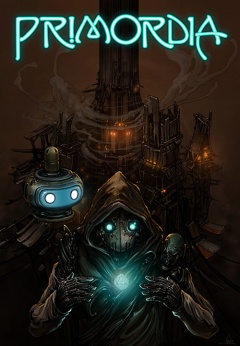 It feels appropriate to end 2012 with a Wadjet Eye game, as this was the year I discovered, bought, and played nearly all of their games. Dave Gilbert has taken his Adventure Game Studio-developed titles from humble roots to full-on publisher in just six years, culminating with this year’s Blackwell Deception, Resonance, and Primordia; a tour de force in indie point and click adventure games. Wadjet Eye Games is the only publisher from whom I regularly preorder games from anymore, in an industry where they will often fall to half their price a few weeks later. But hey, what’s $10 between me and a few great games?
It feels appropriate to end 2012 with a Wadjet Eye game, as this was the year I discovered, bought, and played nearly all of their games. Dave Gilbert has taken his Adventure Game Studio-developed titles from humble roots to full-on publisher in just six years, culminating with this year’s Blackwell Deception, Resonance, and Primordia; a tour de force in indie point and click adventure games. Wadjet Eye Games is the only publisher from whom I regularly preorder games from anymore, in an industry where they will often fall to half their price a few weeks later. But hey, what’s $10 between me and a few great games?
Primordia is their final offering of the year, and it is ambitious. As a robotic steampunk homage to games like Sam and Max, Primordia puts you in the distant future where humans are dead and a variety of robots are all that remains. Wadjet Eye Games tend to be uniquely evocative: the Blackwell series explores death, The Shivah examines religion, Resonance questions the power of technology, and Primordia scrutinizes progress and freedom. These can all be heavy topics, especially for a computer game, but Wadjet Eye always manages to make it about the characters.
For my final review of 2012, let us talk about Primordia, developed by Wormwood Studios and published by Wadjet Eye Games. Monday will feature our sixth annual Game of the Year Awards, so please have a safe and happy new year.
Read moreDecember 21, 2012 by Greg Noe
 I used to love the Ace Attorney series, but fans in the United States have to face it: it’s been almost three years since the last American release and over five years since we actually got to play as Phoenix Wright, so we have to move on, and if you’re looking for your defense attorney fix, Devil’s Attorney may be it.
I used to love the Ace Attorney series, but fans in the United States have to face it: it’s been almost three years since the last American release and over five years since we actually got to play as Phoenix Wright, so we have to move on, and if you’re looking for your defense attorney fix, Devil’s Attorney may be it.
Released in October for Android and iOS, Devil’s Attorney stars an egotistical attorney who makes his buck defending the dregs of society in their exceedingly hilarious and bizarre crimes. The cases come rapid-fire and are played out like a turn-based battle - pretty much the opposite of what fans of Phoenix Wright have come to learn, love, and in turn, lose. The humor is what sustains the game through nearly 60 cases, and there are some really clever bits of writing.
As the year draws to a close, this may be one of our last reviews of 2012, be sure to return on December 31st for our 2012 Game of the Year Awards. I may personally have a surprise pick for my favorite of the year if one of the final games I’m playing stays awesome. Thanks for reading.
Read moreDecember 17, 2012 by Greg Noe
 My oldest son is four years old now, I’ve been playing games with him since he was one. In some ways, gaming is a lot more accessible now: Wii Fit, touch gaming, and even the Kinect allow little kids and casual gamers to ease into things like never before. But on the other hand, give a toddler an Xbox 360 controllers with its nine buttons, two triggers, two thumbsticks, and a D-pad, and they’re more likely to send Batman sailing to an icy death.
My oldest son is four years old now, I’ve been playing games with him since he was one. In some ways, gaming is a lot more accessible now: Wii Fit, touch gaming, and even the Kinect allow little kids and casual gamers to ease into things like never before. But on the other hand, give a toddler an Xbox 360 controllers with its nine buttons, two triggers, two thumbsticks, and a D-pad, and they’re more likely to send Batman sailing to an icy death.
So that’s how my Wii has been resurrected. Having collected dust for years, its wide array of kid friendly but adult awesome games is a godsend. We recently played through Donkey Kong Country Returns, and have now finished New Super Mario Bros. Wii. This is a newbie attractive game that features an especially excellent and forgiving cooperative mode. We can both play at the same time, and the punishment for death is rather limited.
But that’s not to say New Super Mario Bros. Wii isn’t challenging, and it certainly doesn’t lack in content or even replayability. Let’s take a deeper look at NSMBW, played completely through in cooperative mode with a four year old.
Read moreDecember 13, 2012 by Greg Noe
 The finale to the first episodic season of The Walking Dead has arrived, and after the shocking conclusion to the fourth episode, it was apparent just how No Time Left would end. Of course, getting there is never straightforward in The Walking Dead universe.
The finale to the first episodic season of The Walking Dead has arrived, and after the shocking conclusion to the fourth episode, it was apparent just how No Time Left would end. Of course, getting there is never straightforward in The Walking Dead universe.
This final review will be rather spoilerific after the cut, so there’s your first warning. It would be massively difficult to talk about the season as a whole without talking about the characters and their relationships, the real core to The Walking Dead. It’s funny: comparing it to my earlier episodic gaming experience, Tales of Monkey Island, and while I’m going to end up awarding them identical scores, it’s for completely different reasons and I feel totally different about each experience. My thoughts are also a lot more complicated when it comes to The Walking Dead.
So with that, let’s talk Lee, Clementine, and the end of the world.
Read moreDecember 5, 2012 by Greg Noe
 The penultimate episode of the first season of The Walking Dead brings our group of survivors to the edge with seemingly no hope for a happy ending. While I’ve certainly enjoyed the previous three episodes quite a bit, I feel like everything has finally clicked for me in Around Every Corner. There’s a great sense of dread, urgency, and horror as you progress, and it successfully caps off the previous three hours with a heart-stopping finale.
The penultimate episode of the first season of The Walking Dead brings our group of survivors to the edge with seemingly no hope for a happy ending. While I’ve certainly enjoyed the previous three episodes quite a bit, I feel like everything has finally clicked for me in Around Every Corner. There’s a great sense of dread, urgency, and horror as you progress, and it successfully caps off the previous three hours with a heart-stopping finale.
Telltale Games wouldn’t have been my first choice for a Walking Dead game, as a popular graphic novel and the most successful show on cable television, the intellectual property owners should have had their pick of the litter when shopping their game. Could Call of Duty: Black Ops II have sold even more with a fully licensed Walking Dead zombie mode? Should the Dead Island developers been tapped? Capcom for their Dead Rising experience? Valve with Left 4 Dead? EA for their gobs of money?
But Telltale’s interactive drama experiment has been a huge success, at least critically. There are bound to be more Walking Dead games in the future, but this will certainly set the bar high. Here’s my review of episode four: Around Every Corner.
Read moreNovember 28, 2012 by Greg Noe
 If there’s something that Telltale Games teaches its Walking Dead players in Long Road Ahead, it is that everyone is expendable. While I don’t know if everyone’s experience was like mine, I lost four major characters over the course of the episode. Zombies are dangerous in the world of The Walking Dead, but humans are a lot worse. To quote one of the characters, “I don’t believe in strength in numbers.”
If there’s something that Telltale Games teaches its Walking Dead players in Long Road Ahead, it is that everyone is expendable. While I don’t know if everyone’s experience was like mine, I lost four major characters over the course of the episode. Zombies are dangerous in the world of The Walking Dead, but humans are a lot worse. To quote one of the characters, “I don’t believe in strength in numbers.”
I haven’t been quite as blown away by the episodes so far as the rest of the internet are, but I’ve certainly enjoyed them so far. The areas are generally small and there is little exploration or puzzle solving required. I’m reminded again of my original comparison of the game to Heavy Rain, but there was a greater sense of dread in Quantic Dream’s psychological epic than in this zombie-laden drama.
Long Road Ahead was released in late August and it was during this time that I was first exposed to the game through social channels, which is certainly not a surprise considering some of the hellish scenarios the episode puts its players through. While I feel episode three was an improvement over Starved for Help, I’m still looking for a bit more from the game than frantic quick time events.
Read moreNovember 19, 2012 by Greg Noe
 It’s been a while since I played a Kairosoft game, not since May with the extremely lackluster Epic Astro Story. It’s easy to say it’s that game that put me off for another six months, but the Kairosoft formula as a whole can really drag on a gamer after a half dozen games.
It’s been a while since I played a Kairosoft game, not since May with the extremely lackluster Epic Astro Story. It’s easy to say it’s that game that put me off for another six months, but the Kairosoft formula as a whole can really drag on a gamer after a half dozen games.
But Dungeon Village was on super sale at the Google Play store, and it seems like it should be right up my alley: build up a Japanese RPG village which will house an inn full of heroes. Some of my earliest gaming experiences were with Dragon Warrior and Final Fantasy 1, the nostalgia of my youth was calling me to a game I could play on my phone in the bathroom.
Dungeon Village was released in March for Android and iOS, this review is for the Android version.
Read moreNovember 9, 2012 by Steve
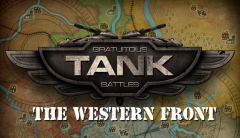 Gratuitous Tank Battles is a unique take on tower-strategy mechanics, created by a man who clearly has a strong attention to detail. This article will be covering both the base game, released this past May, and its expansion The Western Front, which is being released this today on Steam. Both are developed by Positech Games, which is more or less known as Cliff "cliffski" Harris. At first glance, GTB appears to be a standard tower defense game covered in a fine finish, but things quickly become more complicated. For a bit of background reading, we do also have a preview of the game which goes over the basics from a different point of view.
Gratuitous Tank Battles is a unique take on tower-strategy mechanics, created by a man who clearly has a strong attention to detail. This article will be covering both the base game, released this past May, and its expansion The Western Front, which is being released this today on Steam. Both are developed by Positech Games, which is more or less known as Cliff "cliffski" Harris. At first glance, GTB appears to be a standard tower defense game covered in a fine finish, but things quickly become more complicated. For a bit of background reading, we do also have a preview of the game which goes over the basics from a different point of view.
November 7, 2012 by Greg Noe
 I’m not any kind of expert on zombie apocalypse fiction, but from my point of view, there’s two crucial points in the story that every good zombie story needs, and needs to do well. The first is the tension build-up in Act 1. Everyone watching, reading, or playing some sort of zombie media knows there will be zombies. The ones who don’t know are the characters, the heroes whose lives are about to be torn apart by the undead. The more tension the author can build, the more satisfying and terrifying the reveal will be when hell is unleashed.
I’m not any kind of expert on zombie apocalypse fiction, but from my point of view, there’s two crucial points in the story that every good zombie story needs, and needs to do well. The first is the tension build-up in Act 1. Everyone watching, reading, or playing some sort of zombie media knows there will be zombies. The ones who don’t know are the characters, the heroes whose lives are about to be torn apart by the undead. The more tension the author can build, the more satisfying and terrifying the reveal will be when hell is unleashed.
The other crucial part of zombie fiction doesn’t involve the zombies at all, but human conflict. The zombie mythos rule of thumb says that the dead are never the true enemy in zombie fiction and that interesting drama lies in the living. This is true, but drama isn’t necessarily easy or obvious to write, so it’s not a given it’s executed well.
The Walking Dead already featured their tension build-up and zombie reveal in Episode 1: A New Day, but it still surprised me that Episode 2: Starved for Help almost immediately dropped running from zombies in favor of arguing with fellow survivors, but Telltale Games is apparently confident in their story, so let’s take a look.
Read moreNovember 5, 2012 by Nate
 When I rented the Harvey Birdman: Attorney at Law video game a few years ago, I learned that some comedy has a minimum speed limit. I loved the rapid surrealist gags in the Adult Swim cartoon, but fifteen minutes was all I could take of the same humor decelerated to account for player input. What worked at twenty jokes per minute just didn’t translate to a relaxed visual novel speed.
When I rented the Harvey Birdman: Attorney at Law video game a few years ago, I learned that some comedy has a minimum speed limit. I loved the rapid surrealist gags in the Adult Swim cartoon, but fifteen minutes was all I could take of the same humor decelerated to account for player input. What worked at twenty jokes per minute just didn’t translate to a relaxed visual novel speed.
Retro City Rampage has taught me that the funny/fast correlation works both ways. What was shaping up to be a parade of lazy puns and toothless parodies is acceptable entertainment when marched at a sprinter’s pace. It’s all in the delivery.
And Rampage delivers ‘80s nostalgia in spades. From head to toe, the game is decked out in pop culture knockoffs. You’ll accept missions from Principal Belding, find Game Genie codes, and change your appearance in a Michael Jackson facelift shop...with slight alterations that abide by intellectual property laws, of course.
Read moreOctober 31, 2012 by Greg Noe
 Word of mouth is a powerful, but nearly impossible to control selling tool. Growing up, I rented SNES games based on friends’ recommendations; during college, PC games spread from computer to computer like viruses. But now that I’m an adult working full-time, the break room doesn’t satisfy the gaming suggestion mill. So where do I turn? Twitter.
Word of mouth is a powerful, but nearly impossible to control selling tool. Growing up, I rented SNES games based on friends’ recommendations; during college, PC games spread from computer to computer like viruses. But now that I’m an adult working full-time, the break room doesn’t satisfy the gaming suggestion mill. So where do I turn? Twitter.
Love it or hate it, your reaction to Twitter will be based entirely on the people you choose to follow, and I choose to follow a lot of people in the gaming industry. From developers to journalists, they all seem to be raving about The Walking Dead, Telltale Games’ newest episodic adventure for Windows, OSX, Xbox 360, PlayStation 3, and iOS devices.
Fresh off my completion of Tales of Monkey Island, also from Telltale, I was excited to try out something a bit newer, and The Walking Dead fits the bill perfectly, especially with today being Halloween! So here’s my review of Episode 1: A New Day, I will continue to review the other episodes in the coming weeks, as long as I survive!
Happy Halloween and happy gaming!
Read moreOctober 29, 2012 by Tyler James Braatz
 After nearly a decade of remission, Rockstar’s alcoholic, slow-mo, bullet-dodging ex-cop anti-hero is finally back and more badass than ever with their long-awaited third installment of his saga, Max Payne 3.
After nearly a decade of remission, Rockstar’s alcoholic, slow-mo, bullet-dodging ex-cop anti-hero is finally back and more badass than ever with their long-awaited third installment of his saga, Max Payne 3.
From the menu you can choose from story or multiplayer mode supporting up to 16 players online, or arcade mode where you can go back and try to get a higher score on previously beaten levels from story mode as well as the opportunity to hunt for and hidden valuables you may have missed your first time through. As one would expect by now from a game coming out of the Rockstar Studio, story mode is a fanatically written experience riddled with compelling characters and a complex plot full of unexpected twists and turns.
Read moreOctober 24, 2012 by Mike in Omaha
 What began as a simple reply to my original Borderlands 2 review grew into a full on rebuttal almost as long as the original piece! We wouldn't normally rewrap comments into their own review, but since Mike in Omaha is our resident Borderlands expert and I was eagerly looking forward to his own thoughts on the game, I asked for permission to make a little copy and paste magic behind the scenes. What you see is his original comment to my review with some bonus formatting to highlight his specific points.
What began as a simple reply to my original Borderlands 2 review grew into a full on rebuttal almost as long as the original piece! We wouldn't normally rewrap comments into their own review, but since Mike in Omaha is our resident Borderlands expert and I was eagerly looking forward to his own thoughts on the game, I asked for permission to make a little copy and paste magic behind the scenes. What you see is his original comment to my review with some bonus formatting to highlight his specific points.
Before I hand it off to Mike, I'd like to thank him for transforming my original Borderlands 1 experience from a fun solo experience into an absolute blast of cooperative fun. He gave me guns, helped me fight the final boss together multiple times, and exponentially broadened my knowledge of the game. He's an expert on Borderlands, its biggest fan, and as you'll see below, its biggest critic. He awarded Borderlands 1 a 10/10 and provided first hour reviews for both games.
Here's Mike in Omaha on Borderlands 2 and specifically my review of the game from Monday. Original comment from October 10, 2012 at 2:07 PM.
Read moreOctober 23, 2012 by Tyler James Braatz
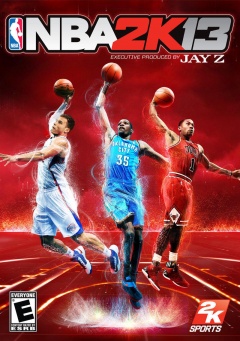 Visual Concepts’ NBA 2K series has been a heavy hitter in the basketball simulator game since the Dreamcast days, and in 2010 when Visual Concepts and 2K Sports became the first to grab the rights to feature Michael Jordan himself in their games, the 2K brand soon became the must-have in basketball sims. NBA 2K11 featured the ability gamers had only dreamt of, to soar and jump-shot like Jordan. As if sales weren’t evidence enough to display the 2K series’ dominance in the field, competitor EA soon sealed the 2K series’ role as the one to beat when they canceled their own NBA Live and NBA Elite. NBA 2K12 would soon be released, featuring even more NBA Legends and a new mode. Yet again, one year later NBA 2K13 is released with even more features, and completely Jay-Z-efied. Here is my review of NBA 2K13.
Visual Concepts’ NBA 2K series has been a heavy hitter in the basketball simulator game since the Dreamcast days, and in 2010 when Visual Concepts and 2K Sports became the first to grab the rights to feature Michael Jordan himself in their games, the 2K brand soon became the must-have in basketball sims. NBA 2K11 featured the ability gamers had only dreamt of, to soar and jump-shot like Jordan. As if sales weren’t evidence enough to display the 2K series’ dominance in the field, competitor EA soon sealed the 2K series’ role as the one to beat when they canceled their own NBA Live and NBA Elite. NBA 2K12 would soon be released, featuring even more NBA Legends and a new mode. Yet again, one year later NBA 2K13 is released with even more features, and completely Jay-Z-efied. Here is my review of NBA 2K13.
NBA 2K13 was released earlier this month and the Xbox 360 version provided to us by 2K Sports for review.
Read moreOctober 22, 2012 by Greg Noe
 As the release date for Borderlands 2 grew closer, I was surprised at how excited I was for the game. I loved the first Borderlands, its challenge, skill progression, and charm had obviously stuck with me, so the sequel was an obvious buy. But I decided to push purchasing it to the first major Steam sale, that couldn’t be too far off, right? Well, thanks to 2K Games coming through and sending me a review copy, I was back in Pandora much sooner than I thought.
As the release date for Borderlands 2 grew closer, I was surprised at how excited I was for the game. I loved the first Borderlands, its challenge, skill progression, and charm had obviously stuck with me, so the sequel was an obvious buy. But I decided to push purchasing it to the first major Steam sale, that couldn’t be too far off, right? Well, thanks to 2K Games coming through and sending me a review copy, I was back in Pandora much sooner than I thought.
Borderlands 2 was released last month on Windows, Xbox 360, and PlayStation 3. I played the original Borderlands on my Xbox 360, but since then I’ve built a gaming computer and my Xbox Live has expired, it was an easy decision to switch over to the PC. I’ve honestly enjoyed the experience even more on my PC, essentially no loading times certainly help, and the superior graphics don’t hurt either.
I wish I could have gotten this review done sooner, but I just finished the game for the first time and Steam reports I played for 50 hours! I completed every side quest I could find and helped a friend level up a few times, but this is a big game that is worth exploring. 50 hours of one game in a month though for me is pretty crazy. Here’s my review of Borderlands 2.
Read moreOctober 8, 2012 by Nate
 After playing Rayman Origins earlier this year, I was eager for more Rayman run-and-jump. Not long afterwards, Rayman Legends details started leaking out at E3, and the salivating began. Unfortunately for me, Legends looks to be a Wii U exclusive, and I'll probably have to miss out on Wii U at launch.
After playing Rayman Origins earlier this year, I was eager for more Rayman run-and-jump. Not long afterwards, Rayman Legends details started leaking out at E3, and the salivating began. Unfortunately for me, Legends looks to be a Wii U exclusive, and I'll probably have to miss out on Wii U at launch.
So I'll probably have to wait a while for the next big Rayman platforming adventure. But Rayman Jungle Run on my Android phone is a decent consolation prize.
In brief, it's the aesthetics and mechanics of Rayman Origins applied to Canabalt-style auto-running. Rayman charges through gorgeous hand-drawn environments, racing towards the goal and collecting Lums in thirty second stages. Its smartphone-simple design means Jungle Run sacrifices some of the creativity, variety, and exploration of Origins, but it's got a few advantages of its own.
Read moreOctober 3, 2012 by Greg Noe
 I read a complaint recently that most Android and iOS action games are just glorified quick time events, touching the screen at the right time to jump or fly or shoot. This is almost certainly true for a game like Temple Run, where your character auto-runs and you quickly flick the screen to react to obstacles and collect more coins. The same could probably also be said for Jetpack Joyride, where the game’s single input turns your character’s jetpack on, releasing turns it off. To some people, this isn’t compelling gaming at all, and I understand that, but for whatever reason, I get hooked on these little games with simple short term objectives but no real long term goals.
I read a complaint recently that most Android and iOS action games are just glorified quick time events, touching the screen at the right time to jump or fly or shoot. This is almost certainly true for a game like Temple Run, where your character auto-runs and you quickly flick the screen to react to obstacles and collect more coins. The same could probably also be said for Jetpack Joyride, where the game’s single input turns your character’s jetpack on, releasing turns it off. To some people, this isn’t compelling gaming at all, and I understand that, but for whatever reason, I get hooked on these little games with simple short term objectives but no real long term goals.
What do you do in Jetpack Joyride? Fly as far as you can? Yeah, I guess that’s maybe the point. Collect coins to buy more things? That’s always fun, sure. Complete objectives and achievements? Sometimes a nice diversion, okay. Now that you’ve done all those things for hours, are you any closer to “beating” the game? Probably not.
Someone more pessimistic than me may suggest the real point of the game is to bewitch you with expensive in-game upgrades to trick you into spending real money on fake coins to make a tidy profit. This is certainly a possibility, heck, app development usually isn’t very altruistic, but if I can have a fun without spending money, have I beaten the system, or simply enjoyed a video game?
Read moreOctober 1, 2012 by Greg Noe
 As the first Monkey Island game in nine years, fans had high expectations for Tales of Monkey Island. Not only is the series one of those coveted, highly nostalgialized, fan favorites from our youth, but the last game, Escape from Monkey Island, simply wasn’t that good. There were a lot of questions whether Guybrush Threepwood is even funny in three dimensions as it had been tried and failed once already.
As the first Monkey Island game in nine years, fans had high expectations for Tales of Monkey Island. Not only is the series one of those coveted, highly nostalgialized, fan favorites from our youth, but the last game, Escape from Monkey Island, simply wasn’t that good. There were a lot of questions whether Guybrush Threepwood is even funny in three dimensions as it had been tried and failed once already.
I certainly had my doubts, I had never played an episodic game before Tales of Monkey Island, so even the delivery method was questionable. I know that TellTale Games has had great success with season gaming, but would it work with Monkey Island? Would the episodes be too long? Too short? Too reliant on cliffhangers? Could a writing staff still capture Guybrush, Elaine, and Chuck?
Five episodes later, I have my definitive answer to all of these questions. Rise of the Pirate God serves as not only the finale for the season, but once again, could be the final chapter in Monkey Island’s 20 year history. Let’s talk first about the episode, and then the series as a whole.
Read moreSeptember 28, 2012 by Nate
 There’s a narrow alley tucked into a corner of the industrial castle town, hidden behind the bustling Arena Square. Armorsmiths and swordcrafts crowd the path, talking shop and hawking wares to passersby in a gaunt corridor of tiny workrooms. In the alley’s only empty corner, a lean brute presses an elderly shopkeep against the grimy concrete and slyly demands a cut of profit.
There’s a narrow alley tucked into a corner of the industrial castle town, hidden behind the bustling Arena Square. Armorsmiths and swordcrafts crowd the path, talking shop and hawking wares to passersby in a gaunt corridor of tiny workrooms. In the alley’s only empty corner, a lean brute presses an elderly shopkeep against the grimy concrete and slyly demands a cut of profit.
It’s a place foul with sweat and industry. It swelters with forge and struggle. A stroll from end to end offers a glimpse of the desperation that is life for these lower class tradesman. They fight for survival, crammed into a corner of the last thriving city on the last prospering island in a rotting world.
The locals call this slum strip Artisan’s Way. It has an effortless narrative density that's so refreshing to see in a JRPG. The Last Story could have been about this place. It’s not. The Last Story is about a vampiric meteor that shoots giant lasers.
Read moreSeptember 24, 2012 by Greg Noe
 After the excellent Lair of the Leviathan episode, I was totally expecting the quality to fall in back to Tales of Monkey Island’s previous levels, good comedy, but not Monkey Island comedy. Thankfully, The Trial and Execution of Guybrush Threepwood manages to sustain most of the momentum of Leviathan in a well written romp that sets out a few pretty unique puzzles for our hero.
After the excellent Lair of the Leviathan episode, I was totally expecting the quality to fall in back to Tales of Monkey Island’s previous levels, good comedy, but not Monkey Island comedy. Thankfully, The Trial and Execution of Guybrush Threepwood manages to sustain most of the momentum of Leviathan in a well written romp that sets out a few pretty unique puzzles for our hero.
So far I’ve really been enjoying Tales of Monkey Island, it isn’t as good as the first three games in the series, but is really well done as an episodic adventure. Breaking out the island hopping into their own chapter has always fit well with Monkey Island, and allows the writers to create more natural cliffhangers and mini-conclusions.
The Trial and Execution of Guybrush Threepwood features a few of its own surprises, which I’ll definitely spoil in the following few paragraphs, if you’re reading this far I guess I’m assuming you’ve either already played the season or don’t care about spoilers at this point.
Read moreSeptember 19, 2012 by Greg Noe
 Finally, a hilarious, superbly written, well-rounded entry into Tales of Monkey Island. The first two episodes felt like Monkey Island on the surface, but were lacking in key areas. Lair of the Leviathan may well be the smallest scoped chapter so far, but is highly focused and downright entertaining from beginning to end.
Finally, a hilarious, superbly written, well-rounded entry into Tales of Monkey Island. The first two episodes felt like Monkey Island on the surface, but were lacking in key areas. Lair of the Leviathan may well be the smallest scoped chapter so far, but is highly focused and downright entertaining from beginning to end.
Lair of the Leviathan is the middle child of the series, and TellTale Games could have certainly phoned the it in; most gamers playing this far are probably in it for the long haul, and with an explosive ending in mind, we would have forgotten the stuff in between point A and point B. But writer Sean Vanaman brought the goods and we got a memorable treat.
As I write this, The Walking Dead series from TellTale Games is receiving rave reviews for its own third episode, and while part of me wishes I was keeping up with that series instead of diving into Tales of Monkey Island, I’m very happy to finally be playing the three year old game in one of my favorite series of all time. Better late than never.
Read moreSeptember 14, 2012 by Greg Noe
 I’m not sure if we ever needed to return to Donkey Kong Country. The original series is so firmly a product of the Super Nintendo era, with its shiny, Toy Story look that is unique to Rareware, and pretty bad collision detection for a 2D platformer, I would have been okay with having rose-colored memories about my trips with DK, Diddy, and the rest of the forgotten gang.
I’m not sure if we ever needed to return to Donkey Kong Country. The original series is so firmly a product of the Super Nintendo era, with its shiny, Toy Story look that is unique to Rareware, and pretty bad collision detection for a 2D platformer, I would have been okay with having rose-colored memories about my trips with DK, Diddy, and the rest of the forgotten gang.
But Retro Studios, apparently bored with resurrecting Metroid moneybags every few years, was tasked with bringing back the old gorilla in Donkey Kong Country Returns. Surprisingly, this was not another 3D incarnation that Retro seemed to excel at (Remember DK64? No? Good.), but a pretty straight enhancement of the originals. The world was still 2D, but with a bit more depth, and all the old standbys were there: bananas and letters to collect, barrels to get shot out of, and obnoxious boss battles.
Released in 2010, Donkey Kong Country Returns has already earned a prestigious 10 from Jonathan Ramundi, and while I would have written a review no matter how much I agreed or disagreed, I have a rather differing opinion about the game.
Read moreSeptember 12, 2012 by Greg Noe
 Tales of Monkey Island is my first foray into episodic gaming, but considering the season was finished nearly three years ago, I’m not exactly playing the game as it was originally intended. But considering plenty of people see blockbusters for the first time outside the theater, television seasons are consumed in two or three sittings, and classic rock albums are downloaded one song at a time, it should be expected that good media is good media no matter how it’s delivered.
Tales of Monkey Island is my first foray into episodic gaming, but considering the season was finished nearly three years ago, I’m not exactly playing the game as it was originally intended. But considering plenty of people see blockbusters for the first time outside the theater, television seasons are consumed in two or three sittings, and classic rock albums are downloaded one song at a time, it should be expected that good media is good media no matter how it’s delivered.
Now that I’m used to the controls and inventory system, my experience with the second episode went a lot smoother. I’m still feeling a bit underwhelmed by the whole thing, however, but have come to the conclusion that the episodic delivery is a good mechanism for not only Monkey Island, but the point and click adventure genre as a whole.
Siege of Spinner Cay kicks off, unsurprisingly, right where Launch of the Screaming Narwhal ended. TellTale Games squeezed in a little cliffhanger at the end of episode one to remind you not everything is okay, and honestly, it immediately pays off.
Read moreSeptember 7, 2012 by Nate
 Last month, I realized that I haven’t taken my 3DS outside all year. Nearly every weekday of 2011, the little black system was in my pocket and transmitting StreetPass data any time I left the house.
Last month, I realized that I haven’t taken my 3DS outside all year. Nearly every weekday of 2011, the little black system was in my pocket and transmitting StreetPass data any time I left the house.
Not this year. Kid Icarus Uprising is just about impossible to play on the go. I finished New Super Mario Bros. 2 in a weekend, enjoyable as it was. And the StreetPass novelty died after I went months without an exchange. It just wasn’t a worthwhile use of pocket space.
But then something unexpected happened: a little-known Game Boy game put the 3DS back in my pocket.
Read moreSeptember 5, 2012 by Greg Noe, Steve
 Growing up, playing a game cooperatively usually meant sitting down with a friend in front of my NES playing Contra, Teenage Mutant Ninja Turtles, or Chip 'n Dale Rescue Rangers. The game was either made easier with a second player (twice as many bullets!), or twice as hard (fellow chipmunks can be used as weapons!). But as games have evolved from the living room to the internet, cooperative play has changed too.
Growing up, playing a game cooperatively usually meant sitting down with a friend in front of my NES playing Contra, Teenage Mutant Ninja Turtles, or Chip 'n Dale Rescue Rangers. The game was either made easier with a second player (twice as many bullets!), or twice as hard (fellow chipmunks can be used as weapons!). But as games have evolved from the living room to the internet, cooperative play has changed too.
Portal 2 was designed with two campaigns in mind, one for the single player and the other for multiplayer, specifically a cooperative experience with no traditional way to communicate available. Both sets of levels were brilliant in their own right, and excelled in creating a unique undertaking. On the other hand, the original Trine was made for local gaming only. Friends gathered in front of the TV or monitor and lead the trio of heroes on their adventure.
Trine 2 introduces online co-op for up to three gamers, fixes many complaints from the first game, and features some of the most gorgeous graphics I've ever seen in a video game. I finally got to tax my video card. Steve and I played through the entire game together online without voice communication, here are our thoughts.
Read moreSeptember 3, 2012 by Greg Noe
 After 2000’s somewhat disastrous Escape from Monkey Island, I was rather leery on returning to my beloved childhood point and click adventure series. Monkey Island 2: LeChuck’s Revenge was the first game I ever played in the genre, and The Curse of Monkey Island is still in my top 10 games of all time.
After 2000’s somewhat disastrous Escape from Monkey Island, I was rather leery on returning to my beloved childhood point and click adventure series. Monkey Island 2: LeChuck’s Revenge was the first game I ever played in the genre, and The Curse of Monkey Island is still in my top 10 games of all time.
LucasArts wasn’t too excited on bringing back Guybrush Threepwood either, but in 2009 thanks to TellTale Games, began publishing the five episodes of Tales of Monkey Island, beginning with Launch of the Screaming Narwhal. TellTale Games is the most successful episodic gaming developer around, and they seem to thrive when given an existing IP to adapt into their release format. Tales of Monkey Island would go on to become their best-selling series at the time.
I’ll be reviewing each episode individually as if they were being released one at a time. There’s a few reasons for this: if an episode really sucks, will I want to play on? I like the idea of being able to quit at any time. Plus, I’m a big fan of getting my ideas down on paper sooner than later, and feel like I can give each episode the time it deserves by reviewing it immediately.
Read moreAugust 29, 2012 by Tyler James Braatz
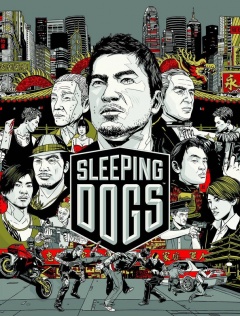 I like freedom in games. That being said, I love open world games-the ability to run around a virtual world, doing missions whenever I please, and I will give any open-world sandbox game a chance, from Toy Story to Saints Row. I fondly remember the “undercover cop” GTA rip-off True Crime series so ridiculous it was almost hard to take serious about ten years ago-yeah, the one that let you play as Snoop Dog. I soon found out that Sleeping Dogs, seemingly released out of nowhere this month, was the once-titled True Crime: Hong Kong, only having changed names due to legal reasons after switching publishers from Activision to Square Enix. While it may have once belonged in a line of True Crime games, TRUST ME- In no way, shape, or form is this anything like what I remember the True Crime series being like. (In a good way.)
I like freedom in games. That being said, I love open world games-the ability to run around a virtual world, doing missions whenever I please, and I will give any open-world sandbox game a chance, from Toy Story to Saints Row. I fondly remember the “undercover cop” GTA rip-off True Crime series so ridiculous it was almost hard to take serious about ten years ago-yeah, the one that let you play as Snoop Dog. I soon found out that Sleeping Dogs, seemingly released out of nowhere this month, was the once-titled True Crime: Hong Kong, only having changed names due to legal reasons after switching publishers from Activision to Square Enix. While it may have once belonged in a line of True Crime games, TRUST ME- In no way, shape, or form is this anything like what I remember the True Crime series being like. (In a good way.)
With Square Enix’s reboot, remastering and renaming of the True Crime franchise, now Sleeping Dogs, they have tooled what could prove to be one of the biggest surprise smash hits this year with tight gameplay all around and with a story more compelling than most of Rockstar or THQ’s gangster tales have ever felt. Here is my review of Sleeping Dogs for Xbox 360.
Read moreAugust 20, 2012 by Greg Noe
 Have there been any mainstream Jewish video games? Outside of Bible Adventures, I can’t think of a single religious game that even a small percentage of gamers might recognize. It’s interesting: there are quite a few popular religious films such as The Ten Commandments, and religious music and television has certainly found its niche, but there has never been a video game or developer that religious groups have rallied behind.
Have there been any mainstream Jewish video games? Outside of Bible Adventures, I can’t think of a single religious game that even a small percentage of gamers might recognize. It’s interesting: there are quite a few popular religious films such as The Ten Commandments, and religious music and television has certainly found its niche, but there has never been a video game or developer that religious groups have rallied behind.
I could personally rattle off a dozen reasons why this might be the case, but it raises the question: does religion have a place in video games outside of being the caricatured bad guy in a game like Final Fantasy Tactics? Dave Gilbert of Wadjet Eye Games thought the answer was “yes” with his first paid point and click adventure game, The Shivah.
The Shivah stars Rabbi Stone in his short quest to uncover the truth about a recently deceased friend. It takes place inside synagogues and features a decent dose of Hebrew and Jewish themes. It isn’t heavy-handed in anything it does, this is simply the character and settings Wadjet Eye Games wanted to tell. Here’s my review of The Shivah, built in Adventure Games Studio.
Read moreAugust 15, 2012 by Greg Noe
 Bastion made a huge splash last year when it was released on Xbox Live Arcade and Steam, reaping excellent critical reviews and huge sales, especially for an indie game. Developed by Supergiant Games and published by Warner Bros., the game’s iconic narrator and haunting soundtrack have cemented its place as one of the cornerstone independent games of this decade.
Bastion made a huge splash last year when it was released on Xbox Live Arcade and Steam, reaping excellent critical reviews and huge sales, especially for an indie game. Developed by Supergiant Games and published by Warner Bros., the game’s iconic narrator and haunting soundtrack have cemented its place as one of the cornerstone independent games of this decade.
I was impressed by its first hour last November, but reading my thoughts on Bastion’s start indicates a trend that would hold throughout the game: while the art, music, and voice acting is stellar, the gameplay is just sort of there. It’s solid, but didn’t stand out amongst the great presentation.
It took a few months and many, many games, but I returned to Bastion, restarted my adventure, and finished the game in a half-dozen sittings. Here’s my review of Bastion for the PC.
Read moreAugust 13, 2012 by Greg Noe
 I’ve been spoiled this year having just been introduced to the Blackwell series and publisher Wadjet Eye Games. Before Resonance, I bought four Blackwell games, Gemini Rue, and The Shivah. Point and click adventure gaming was one of my earliest gaming passions, but I ended up almost completely ignoring the genre for the last 12 years. Now it’s a passion again, and all courtesy of one publisher.
I’ve been spoiled this year having just been introduced to the Blackwell series and publisher Wadjet Eye Games. Before Resonance, I bought four Blackwell games, Gemini Rue, and The Shivah. Point and click adventure gaming was one of my earliest gaming passions, but I ended up almost completely ignoring the genre for the last 12 years. Now it’s a passion again, and all courtesy of one publisher.
Developed by Vince Twelve and published by Wadjet Eye Games, Resonance is a multi-character point and click adventure game featuring an engrossing story, unique interface, and thankfully, basically free of all the crappy genre trappings that pushed me away from games like this. It was one of the few games I allowed myself to hype up a bit this year, and the developers delivered.
If Resonance looks interesting to you, definitely check it out, it’s only $10 on Steam. Then play all the Blackwell games which can be grabbed in a four pack for $20. Not a bad deal at all. The best part about these games is that they were made in the free to use Adventure Games Studio, I’m scared to think about all the other awesome games out there that were made with this tool that I’m missing.
Here’s my spoiler free review of Resonance.
Read moreAugust 10, 2012 by Steve
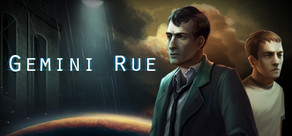 Gemini Rue. Duality + regret. A remarkably thoughtful and fitting name for this game (and certainly much more pleasing than the original Boryokudan Rue). Another entry in the monstrous Wadjet Eye Games adventure lineup and primarily the child of Joshua Nuernberger, Gemini Rue has been very well received since its release in early 2011. The game takes place in a futuristic sci-fi world with some touches of cyberpunk thrown in. As with other recent Wadjet games, it is a full experience complete with voice acting and attempts to push the underlying Adventure Game Studio engine as far as it can. As a whole, their efforts greatly pay off, riding on the strength of the characters and overarching story.
Gemini Rue. Duality + regret. A remarkably thoughtful and fitting name for this game (and certainly much more pleasing than the original Boryokudan Rue). Another entry in the monstrous Wadjet Eye Games adventure lineup and primarily the child of Joshua Nuernberger, Gemini Rue has been very well received since its release in early 2011. The game takes place in a futuristic sci-fi world with some touches of cyberpunk thrown in. As with other recent Wadjet games, it is a full experience complete with voice acting and attempts to push the underlying Adventure Game Studio engine as far as it can. As a whole, their efforts greatly pay off, riding on the strength of the characters and overarching story.
August 8, 2012 by Nate
 A few weeks ago, I acquired Breath of Death VII: The Beginning, Cthulhu Saves the World, and all three episodes of Penny Arcade Adventures for eight bucks on Steam. It seemed like a steal at the time: five brief RPG comedies for less than I spend on my daily commute.
A few weeks ago, I acquired Breath of Death VII: The Beginning, Cthulhu Saves the World, and all three episodes of Penny Arcade Adventures for eight bucks on Steam. It seemed like a steal at the time: five brief RPG comedies for less than I spend on my daily commute.
I dropped Breath and Cthulhu after a few hours. Zeboyd’s nutty tributes to ‘80s JRPGs had their moments, but not enough to excuse dull battles, random encounters, and big empty dungeons.
The first two Penny Arcade games weren’t much better. My disgust for their fetch quest campaign structure smothered my fondness for the Mario RPG-style battles.
So when I saw that Penny Arcade’s Whatever 3 was the result of a Zeboyd/Penny Arcade team-up, I braced myself for some whole new amalgam of repulsive game elements. It turned out to be a roundly enjoyable seven-hour adventure, one that almost excuses the twelve hours I slogged through the other four games in the bundle. Almost.
Read moreAugust 6, 2012 by Greg Noe
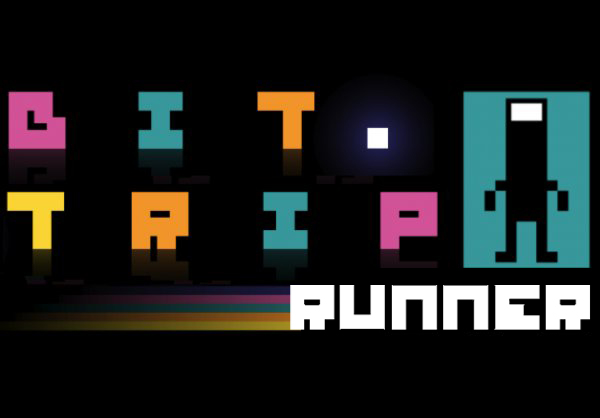 VVVVVV and NightSky both featured great musical soundtracks to back their platforming efforts, but Bit.Trip Runner is essentially a rhythm game with the platforms serving the soundtrack. Developed by Gaijin Games and released on WiiWare in 2010 and Windows in 2011, Bit.Trip Runner attempts to marry the sounds of Guitar Hero and the auto-running of Canabalt.
VVVVVV and NightSky both featured great musical soundtracks to back their platforming efforts, but Bit.Trip Runner is essentially a rhythm game with the platforms serving the soundtrack. Developed by Gaijin Games and released on WiiWare in 2010 and Windows in 2011, Bit.Trip Runner attempts to marry the sounds of Guitar Hero and the auto-running of Canabalt.
Nate originally reviewed Bit.Trip Runner last year and deemed it the “anti-rhythm game”, he awarded it an average score and went on to call it stressful. Steve chimed in in the comments section a few months ago and agreed with Nate’s assessment, but for whatever reason, I decided to play it myself.
I didn’t actually beat Bit.Trip Runner, but I made it to the third to last level before finally giving up, so I feel like writing a “full” review is still legitimate, either way, full disclosure.
Read moreJuly 30, 2012 by Greg Noe
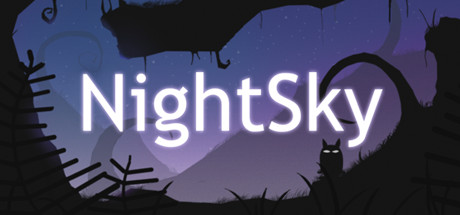 NightSky sells itself as an “ambient action-puzzle game”, which is an excellent description for this unique platformer. Most of the time you’re rolling a ball from the left to the right to reach the far side of the screen. Each level is typically three screens, with the third screen serving as a visual addendum to the previous puzzle. I’d like to say it’s a deceptively simple game, but there really isn’t much more to it than rolling a ball.
NightSky sells itself as an “ambient action-puzzle game”, which is an excellent description for this unique platformer. Most of the time you’re rolling a ball from the left to the right to reach the far side of the screen. Each level is typically three screens, with the third screen serving as a visual addendum to the previous puzzle. I’d like to say it’s a deceptively simple game, but there really isn’t much more to it than rolling a ball.
Outside of games like Eufloria and Dear Esther, few video games have delivered a truly relaxing experience. There’s very little urgency in NightSky with only a couple of timed puzzles, and if your ball rolls into the abyss, you’re simply plopped back to the beginning of the three screen set. You can save and quit at any time without losing progress, and there isn’t even really an acknowledgement that you beat the game. Everything is designed to elicit as little positive or negative emotions as possible, developer Nicklas Nygren would probably deem it a success if you instead drifted off to sleep in your chair.
Read moreJuly 25, 2012 by Nate
 Breakout and Arkanoid and similar paddle games never resonated with me. Maybe because their Atari heyday ended before I started playing games, or maybe because I disliked the loose shot control. Whatever the case, the genre’s most polished and inspired entries still manage only a passing fancy.
Breakout and Arkanoid and similar paddle games never resonated with me. Maybe because their Atari heyday ended before I started playing games, or maybe because I disliked the loose shot control. Whatever the case, the genre’s most polished and inspired entries still manage only a passing fancy.
So I’m flummoxed by my lingering affinity for Wizorb, a three-dollar, three-hour curiosity. I completed the brief game in a weekend fling and have no real desire to revisit it, yet it’s still on my mind. I do relish the lively lo-fi style and RPG window dressing, but the game is still a pretty standard brick breaker at its core.
I’m not terribly impressed by this new appstore era, this flood of amateur developments selling for less than a vending machine lunch and rarely lasting as long. But Wizorb is one of the few $3 games that’s more filling than its price tag and play time imply. A few thoughtful little gameplay functions that address the genre’s weaknesses are what make it shine among its Breakout-clone peers and its bottom-dollar indie competition both.
Read moreJuly 23, 2012 by Greg Noe
![]() I’ve been on an indie game kick this year, playing some really excellent platformer and adventure games. In a somewhat random string of events, I ended up playing three pretty different types of platformers over the course of a few weeks, and in preparation for our recent five year anniversary celebration, all full reviews were put on the back burner.
I’ve been on an indie game kick this year, playing some really excellent platformer and adventure games. In a somewhat random string of events, I ended up playing three pretty different types of platformers over the course of a few weeks, and in preparation for our recent five year anniversary celebration, all full reviews were put on the back burner.
The first of these three is VVVVVV, developed by Terry Cavanagh and released in early 2010, VVVVVV is a short but challenging open world platformer. Our hero, Captain Viridian, suffers some kind of accident to his spaceship and his crew is scattered across a new dimension. The controls are simple: all you can do is move left, right, and well, flip the gravity at your whim.
The next two platformers you’ll hear from me about are NightSky and Bit.Trip Runner, and while they’re all technically rather distinct, they can, after all, be boiled down to 2D platformers at the core.
Read moreJuly 20, 2012 by Nate
 I was never any good at The Incredible Machine. It was one of a handful of games available in my elementary school's computer lab, and it was the only one that stumped me every time. I knew the Oregon Trail like the back of my hand, and my SimCity could withstand any disaster, but the motors and pulleys and cheese-seeking mice never quite registered for me.
I was never any good at The Incredible Machine. It was one of a handful of games available in my elementary school's computer lab, and it was the only one that stumped me every time. I knew the Oregon Trail like the back of my hand, and my SimCity could withstand any disaster, but the motors and pulleys and cheese-seeking mice never quite registered for me.
So it was with some hesitation that I downloaded Amazing Alex, the next game by the Angry Birds folks. It has all the friendly colors and streamlining of Rovio's money-printing slingshot game, but Incredible Machine's spirit clearly lives within. And I didn't think I had the Rube Goldberg skills to finish it.
But I did. I finished all 112 stages and collected the three stars in each. And it was the most fun I've had with my smartphone yet.
Read moreJuly 2, 2012 by Nate
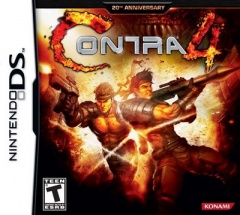 Casual observers must be baffled when they watch someone play through tough old-school games. They see the tense hands, the parched eyes, the tight scowl; they must wonder, why would anyone subject themselves to this? Is it a determination to succeed, or a desire to suffer?
Casual observers must be baffled when they watch someone play through tough old-school games. They see the tense hands, the parched eyes, the tight scowl; they must wonder, why would anyone subject themselves to this? Is it a determination to succeed, or a desire to suffer?
Sometimes, even the player doesn’t know. When the deaths start piling up, frustration can obscure the distinction between a worthy challenge and a cheap wringer. For some, it doesn’t matter: if the game can be beaten, they will beat it.
I once had that unshakable tenacity, but I won’t put up with cheap traps anymore. I’m learning how to spot the dirty tricks that games use to torture players. And Contra 4 is a hell of a teacher.
Read moreJune 27, 2012 by Ian M. Bagley
 I’ve played a fair amount of video games in my life, and I’ve been playing shooters since I was five or six. This isn’t a challenge of “Yeah, well, I started when I was four!” Don’t start, that’s just annoying. My point is, I’ve been around the block a few times. Here’s a list of the shooters I played online regularly in chronological order: Quake, Team Fortress Classic, Unreal Tournament, Counter-Strike: Source, America’s Army, Battlefield: Bad Company 2.
I’ve played a fair amount of video games in my life, and I’ve been playing shooters since I was five or six. This isn’t a challenge of “Yeah, well, I started when I was four!” Don’t start, that’s just annoying. My point is, I’ve been around the block a few times. Here’s a list of the shooters I played online regularly in chronological order: Quake, Team Fortress Classic, Unreal Tournament, Counter-Strike: Source, America’s Army, Battlefield: Bad Company 2.
That’s really not that much, but it became impossible to keep up with the audiences. You want to play the most popular games (or at least popular games) so you actually have other people to play against, but once there was a new shooter coming out every freakin’ year, I just gave up.
Until one night, when my friend came into town for a visit and explained to me he had another copy of Call of Duty: Modern Warfare 3, and said it was mine if I wanted it. I thanked him and declined at first, but finally caved and accepted the offer. What the hell, it’s a free game, right?
Read moreJune 22, 2012 by Steve
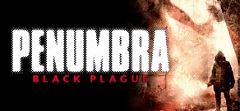 After playing Penumbra: Overture, everyone knew a sequel was on its way. The ending leaves scores of questions unanswered and perfectly prepares a follow-up. In 2008, Frictional Games released Penumbra: Black Plague, and in many ways, Black Plague does make the original feel like a mere overture. Frictional well heeded feedback following Overture's release and significantly tuned up their product in regards to pacing, controls, physics, and character interaction. All while continuing the fantastically creepy atmosphere and adding significant new elements to the story.
After playing Penumbra: Overture, everyone knew a sequel was on its way. The ending leaves scores of questions unanswered and perfectly prepares a follow-up. In 2008, Frictional Games released Penumbra: Black Plague, and in many ways, Black Plague does make the original feel like a mere overture. Frictional well heeded feedback following Overture's release and significantly tuned up their product in regards to pacing, controls, physics, and character interaction. All while continuing the fantastically creepy atmosphere and adding significant new elements to the story.
June 20, 2012 by Ian M. Bagley
 The Diablo series is the most important series in my life. While I missed Diablo, I caught its sequel by the throat on release day and was hooked for a good…well, I’m still off-and-on addicted. So sue me. Diablo II was everything I wanted. It was fast paced, exciting, the gathering of objects was awesome, leveling was fun, playing through the game more than once was fun.
The Diablo series is the most important series in my life. While I missed Diablo, I caught its sequel by the throat on release day and was hooked for a good…well, I’m still off-and-on addicted. So sue me. Diablo II was everything I wanted. It was fast paced, exciting, the gathering of objects was awesome, leveling was fun, playing through the game more than once was fun.
I love the Diablo series so much, that when Diablo III was announced, I called every friend I knew that ever played it and told them to check the website so they could experience the surprise. I was SO happy.
I waited 12 years for Diablo III. I got it at the midnight prerelease and tried playing the game, and we all know of the infamous Error 37. I thought about writing a first hour review of just “error 37” every minute for an hour. But anyway…
But I expected servers to be destroyed…I mean, it IS battle.net. But you know what? Despite being more than happy to wait for the servers to be available to me: I wish I had never bought it.
The truth is, this game disappointed me in almost every way possible. Let’s talk about why and what.
Read moreMay 31, 2012 by Greg Noe
 The whole “play the first hour of a video game and determine from that whether I’d keep playing” concept has its flaws, it’s certainly not perfect. Some great first hours fall short over time, and others give a bad first impression that they (sometimes) unknowingly recover from later on. But other times the first impression is right on, Infamous is one of those games.
The whole “play the first hour of a video game and determine from that whether I’d keep playing” concept has its flaws, it’s certainly not perfect. Some great first hours fall short over time, and others give a bad first impression that they (sometimes) unknowingly recover from later on. But other times the first impression is right on, Infamous is one of those games.
I had a great time with the first 60 minutes of Infamous, the gameplay was fast-paced and just felt.. right. Plus, I’m always looking for sandbox games that pull off the action genre better than Grand Theft Auto IV (ugh). The Saboteur had similar first hour pedigree, and was also a great success in the end, so I had quite high hopes for Infamous.
You can probably tell by my praise that I enjoyed the game, so if you care to read on why I enjoyed it, well, here you go. My full review of Infamous for the PlayStation 3.
Read moreMay 29, 2012 by Greg Noe, Steve
 A year ago I published my full review of Portal 2. I guess you could say it wasn't exactly complete since I never touched the co-op portion of it, but finding time to sit down and play a video game with another human being for a few hours is pretty difficult for me, so sacrfices had to be made. But last weekend, I had the opportunity to sit down with Steve and our gaming PCs for about 10 hours, and time for Portal 2 co-op was finally realized.
A year ago I published my full review of Portal 2. I guess you could say it wasn't exactly complete since I never touched the co-op portion of it, but finding time to sit down and play a video game with another human being for a few hours is pretty difficult for me, so sacrfices had to be made. But last weekend, I had the opportunity to sit down with Steve and our gaming PCs for about 10 hours, and time for Portal 2 co-op was finally realized.
Portal 2's co-op is pretty fantastic in that it is a completely different experience than the single player, in every aspect. The story is different, the characters are new, and the puzzles are two-player required. While many games that feature co-op, if they even bother, just toss both players together in the single player campaign, that would have been disastrous with a puzzler like Portal 2. So major props to Valve for developing this campaign, just for us.
This really isn't a proper review, but I wanted to present both Steve and mine opinions about just the cooperative portion of Portal 2. Enjoy, and give it a try if you find a few hours with a friend.
Read moreMay 25, 2012 by Greg Noe
 The Blackwell series hasn’t changed a lot over four games released across five years. The screen resolution and accompanying art still seems reminiscent of 1990s adventure games, the point and click gameplay is also rooted in the classics, and the story is still well polished and very entertaining. But none of this at all is a bad thing, it enables indie developer Wadjet Eye Games to release quality games at a manageable pace.
The Blackwell series hasn’t changed a lot over four games released across five years. The screen resolution and accompanying art still seems reminiscent of 1990s adventure games, the point and click gameplay is also rooted in the classics, and the story is still well polished and very entertaining. But none of this at all is a bad thing, it enables indie developer Wadjet Eye Games to release quality games at a manageable pace.
And I have certainly had it well off the last few months having just discovered the Blackwell series. Four games that I almost instantly fell in love with at my fingertips! But now that they’re done, I find myself playing the waiting game like the rest of the fans. Much like when I caught up with the A Song of Ice and Fire book series in 2008 or The Wheel of Time in 2007, waiting really can be the hardest part.
So I present my review for Blackwell Deception. You can also read my reviews for The Blackwell Legacy, Blackwell Unbound, and Blackwell Convergence, or just play the games. They’re great.
Read moreMay 21, 2012 by Greg Noe
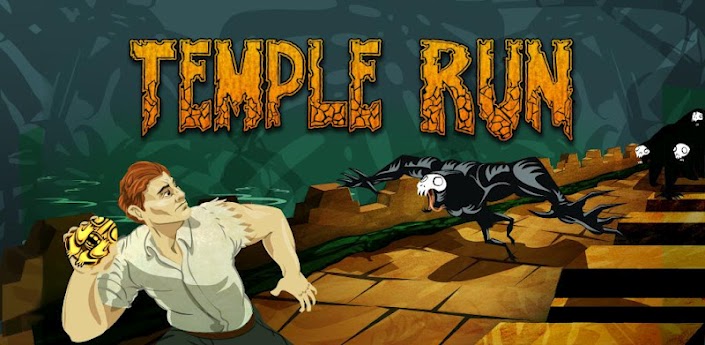 I wasn't planning on writing about Temple Run orginally. It's a 3D auto-running game where you swipe the screen of your phone or tablet to avoid obstacles. It's free and supported by micro-transcations. Basically a list of things I should find really wrong with a video game. But if I ever spent the time to wonder what mobile game I was playing in April and May 2012, without this review, I may never have the answer.
I wasn't planning on writing about Temple Run orginally. It's a 3D auto-running game where you swipe the screen of your phone or tablet to avoid obstacles. It's free and supported by micro-transcations. Basically a list of things I should find really wrong with a video game. But if I ever spent the time to wonder what mobile game I was playing in April and May 2012, without this review, I may never have the answer.
So yes, I've been rather addicted to this simple run-and-avoid-obstacles game. From the graphics on the title screen I gather you're making off with some idol from some cursed ruins and then a couple of devil monkeys start chasing after you. There's really no other lore to go on, and when you start unlocking different characters later on like a geisha and football player, all logic goes out the window. But that doesn't really matter because you're in a desperate struggle for points.
Read moreMay 18, 2012 by Nate
 My Club Nintendo coins are finally going to good use, now that I can exchange them for games instead of cheap memorabilia. Fluidity was well worth zero dollars. And last month, I checked out Art Style: Cubello and found an interesting puzzle/lightgun hybrid.
My Club Nintendo coins are finally going to good use, now that I can exchange them for games instead of cheap memorabilia. Fluidity was well worth zero dollars. And last month, I checked out Art Style: Cubello and found an interesting puzzle/lightgun hybrid.
Another month, another Art Style game to grab from the Club. Pictobits (called Picopict in other territories) is my fourth from the series, all of them quite different from one another. Of the four, Pictobits is the closest to a traditional puzzle game, falling blocks and all. As someone who tends to burn out quickly on those competitive block-movers, I kept my expectations low.
But Pictobits surprised me. It gets frantic, no doubt, but the bite-size challenges and uncommon variety pulled me over the speedbumps in the difficulty curve. The retro Nintendo style didn't hurt, either.
Read moreMay 14, 2012 by Nate
 I never quite bought into the whole Achievements deal this generation. It's nice to have a (rather arbitrary) tally of "gamerness" on record, and I do like to occasionally check my friends' progress. But the achievements themselves tend to make a goal out of lengthy tedium, a checklist asking the player to kill X enemies using Y weapon, in a way that mimics the worst parts of grind-dependent MMOs. It's far from the creative metagame that I'd hoped would evolve through the generation.
I never quite bought into the whole Achievements deal this generation. It's nice to have a (rather arbitrary) tally of "gamerness" on record, and I do like to occasionally check my friends' progress. But the achievements themselves tend to make a goal out of lengthy tedium, a checklist asking the player to kill X enemies using Y weapon, in a way that mimics the worst parts of grind-dependent MMOs. It's far from the creative metagame that I'd hoped would evolve through the generation.
As a result, my PSN trophy list accounted for 65 games long but lacked a platinum trophy. I had ambitions to 100% my very first PS3 game, Uncharted 2, until I saw that the majority of the trophies were based on finding "treasures" in the game, essentially an overgrown pixel hunt. I don't regret giving up that chase shortly after it began, and it kind of soured me on trophies in general. Still, there has always been this nagging feeling that, having played so many PS3 games, I should get one platinum trophy before the next generation arrives. Some people aspire to run one marathon in their lives. I figured I should have one pointless digital knickknack.
Now I have one. It's a bit underwhelming, actually. Maybe that's because it only took about fifteen hours of game time to achieve. Or maybe it's because Rayman Origins is fun enough that, even if the game lacked trophies, I would have finished all the requirements anyway.
Read moreMay 9, 2012 by Greg Noe
 All good things must come to an end: I just finished the first Kairosoft game I would call bad. I’ve played a few Kairosoft sims that were unbalanced or boring, but never both. Epic Astro Story is the official low bar among a great series of games that range from training a soccer team to running a game design studio.
All good things must come to an end: I just finished the first Kairosoft game I would call bad. I’ve played a few Kairosoft sims that were unbalanced or boring, but never both. Epic Astro Story is the official low bar among a great series of games that range from training a soccer team to running a game design studio.
Epic Astro Story is a space colony sim where you build up an industrial/tourism complex on an empty planet while sending out away-parties to explore the darkness around you. While traveling through caves, mountains, and deserts, your team will fight against local bad guys for the right to the land.
I’ve had great success with Kairosoft games so far, most of them have clicked really well with me and my tastes, but from the start I had issues with Epic Astro Story. Here’s my review.
Read moreMay 4, 2012 by Jonathan Ramundi
 Nearly two years after its initial Japanese release, and eight months after finding its way to Europe and Australia, Nintendo of America finally saw fit to grace North American Wiis with the critically acclaimed Xenoblade Chronicles (though not without a lot of pestering it would seem). Debuting at E3 2009 under the title Monado: Beginning of the World, Monolith Soft's latest immediately captured the attention of RPG-starved Wii owners with its large, open environments, colourful atmosphere, and intriguing storyline.
Nearly two years after its initial Japanese release, and eight months after finding its way to Europe and Australia, Nintendo of America finally saw fit to grace North American Wiis with the critically acclaimed Xenoblade Chronicles (though not without a lot of pestering it would seem). Debuting at E3 2009 under the title Monado: Beginning of the World, Monolith Soft's latest immediately captured the attention of RPG-starved Wii owners with its large, open environments, colourful atmosphere, and intriguing storyline.
Probably most intriguing, however, was the gameplay. Xenoblade—its title a tribute to Monolith's flagship franchise, Xenosaga—deviates considerably from traditional JRPGs, doing away with random encounters and turn-based combat. Instead, players do battle on the very map they explore, without a transition to a battle screen, and with the ability to see enemies long in advance, as many are simply animals going about their business in the game world. Battles themselves are much more tactical, seeing players manoeuvring about the battlefield for ideal position and using abilities at advantageous times.
Never mind that I'd been craving some decent RPG action for a while, I definitely wanted to see what Xenoblade had to offer, and was more than a little disappointed when it first looked as if I wouldn't get the chance. Better late than never, I guess. At least my Wii has something to do now besides collecting dust.
Read moreMay 2, 2012 by Nate
In Super Smash Bros, Director Masahiro Sakurai stripped the fighting game genre of its finger-tangling combos and built a new style from the core sensation he enjoyed the most: the dynamic "ad lib" nature of the fights. It was arguably the Nintendo 64's best game. In Kirby Air Ride, Sakurai boiled down the racing game to drifting and acceleration, then layered that core with Kirby flair and garish extras. It wasn't exactly the next Smash Bros.
Now, Sakurai's "disassembly and reassembly" approach takes on the shooter in Kid Icarus: Uprising. The father of Kirby and Smash Bros has transformed a quirky NES action platformer into half corridor shooter and half third-person shooter. It's no Smash success, but it's far from Air Ride's mediocre curiosity as well.
Read moreApril 23, 2012 by Greg Noe
 I love the Mass Effect franchise. Mass Effect 3 is the first console game I bought new in over two years (previous new purchase was Mass Effect 2). I beat the first game six times. I’ve read the novels and comics that accompany the games. I own two Commander Shepard action figures and a mini Normandy SR2. I have a one year old son named Shepard.
I love the Mass Effect franchise. Mass Effect 3 is the first console game I bought new in over two years (previous new purchase was Mass Effect 2). I beat the first game six times. I’ve read the novels and comics that accompany the games. I own two Commander Shepard action figures and a mini Normandy SR2. I have a one year old son named Shepard.
So you could say with some confidence that I was really looking forward to Mass Effect 3. I made the day one Collector’s Edition purchase and popped up my first hour review of the game immediately. The game doesn’t start with as much energy as Mass Effect 2, but it’s hard to argue that there’s anything more powerful than beginning with the Reapers invading Earth.
Mass Effect 3 has received a huge amount of controversy regarding its ending. Do you know how hard it is to take two weeks to beat a game you’ve been waiting for two years while seemingly everyone on the internet is talking about its conclusion? Ugh. I’ll say right now that I certainly didn’t hate the ending, but didn’t love it either.
Now for my review on the other 99.5% of Mass Effect 3. I also have my review of the first DLC available, From Ashes.
Read moreApril 20, 2012 by Greg Noe
 Blackwell Convergence follows The Blackwell Legacy and Blackwell Unbound in Wadjet Eye Games’ story-driven adventure game series. I found Unbound to be a stunning entry that rectified many of Legacy’s issues while building on the series’ mysteries. It also had a ton of style that is sadly absent in many games today.
Blackwell Convergence follows The Blackwell Legacy and Blackwell Unbound in Wadjet Eye Games’ story-driven adventure game series. I found Unbound to be a stunning entry that rectified many of Legacy’s issues while building on the series’ mysteries. It also had a ton of style that is sadly absent in many games today.
So I had high expectations for Convergence, as the story was brought back to present day with our original heroine Rosangela Blackwell. The detour Unbound took to the past was engrossing and informative, and gave the series that much more emotional weight. I knew it would be tough for Convergence to keep up the momentum, but I promised myself that if it did, I’d be waving the Blackwell flag for many years to come.
Released in 2009 for Windows and once again built in Adventure Game Studios, here’s my review for Blackwell Convergence.
Read moreApril 18, 2012 by Greg Noe
 Three of my favorite mobile series recently received updates, so it’s time to revisit them. Angry Birds Space is the new Super Mario Galaxy inspired spinoff of the original bird-flinging game, and Cut the Rope: Experiments expands upon the original Cut the Rope concept with new ideas and 125 levels. Finally, the genius Where’s My Water? has received some new levels since my original review, so I’ll touch on that too.
Three of my favorite mobile series recently received updates, so it’s time to revisit them. Angry Birds Space is the new Super Mario Galaxy inspired spinoff of the original bird-flinging game, and Cut the Rope: Experiments expands upon the original Cut the Rope concept with new ideas and 125 levels. Finally, the genius Where’s My Water? has received some new levels since my original review, so I’ll touch on that too.
Laugh if you want, but I really love these games for their quintessential mobile experiences. Levels are short and sweet, difficulty ramps up slowly, and gameplay variety is injected constantly. Each of them have fun with physics and benefit greatly from the touchscreen. Plus, they’re dirt cheap.
My thoughts will hopefully be short and efficient, just like the games I’m reviewing. I played each game on my Android EVO 4G phone.
Read moreApril 13, 2012 by Nate
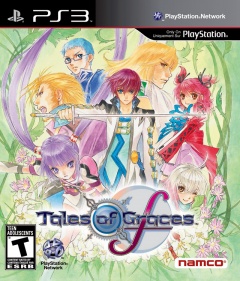 It was four minutes into Tales of Graces f that I met the amnesiac with the impossible purple pigtails. She didn't know who she was, or where she came from, or anything really. She was a deadly martial artist, but nearly walked right off a cliff. Later she asked the meaning of the word "friend." I threw up in my mouth a little and realized that Graces f would be a tale quickly forgotten. In hindsight, I guess the cover art should have served as warning.
It was four minutes into Tales of Graces f that I met the amnesiac with the impossible purple pigtails. She didn't know who she was, or where she came from, or anything really. She was a deadly martial artist, but nearly walked right off a cliff. Later she asked the meaning of the word "friend." I threw up in my mouth a little and realized that Graces f would be a tale quickly forgotten. In hindsight, I guess the cover art should have served as warning.
But if the whole game boiled down to waiting for the kid in the Elvis getup to realize that the king is possessed by a demon, I wouldn't have played it for almost ninety hours. Yes, a lot of time is wasted running errands through copy-paste corridors while the characters say how they feel and explain magical jargon. But then you run into a giant spider, and the kids' anime story melts away for a few seconds of glorious battle.
I'll even say that Tales of Graces f has my favorite RPG combat, taking the crown from predecessor Tales of Symphonia. Graces f layers new abilities and limitations onto Symphonia's melee-and-magic arena skirmishes, and the end result is a more dynamic structure that makes earlier games in the series look like button mashing. It's also complicated as hell.
Read moreApril 11, 2012 by Steve
 Fresh on the heels of the well-received The Blackwell Legacy arrives Blackwell Unbound. After playing and thoroughly enjoying the first for our Indie Impression feature, continuing was an inevitability. For reference, Legacy was released in 2006, and Unbound in 2007. There have since been two more releases in the semi-episodic series, so I'm still a bit behind. I am playing the re-released versions in the Blackwell Bundle, which offer improved voice acting as well as bug fixes and some extras. The Blackwell series (as well The Shivah) were primarily developed by Dave Gilbert and his studio, Wadjet Eye Games.
Fresh on the heels of the well-received The Blackwell Legacy arrives Blackwell Unbound. After playing and thoroughly enjoying the first for our Indie Impression feature, continuing was an inevitability. For reference, Legacy was released in 2006, and Unbound in 2007. There have since been two more releases in the semi-episodic series, so I'm still a bit behind. I am playing the re-released versions in the Blackwell Bundle, which offer improved voice acting as well as bug fixes and some extras. The Blackwell series (as well The Shivah) were primarily developed by Dave Gilbert and his studio, Wadjet Eye Games.
For ease of writing, I'm just going to assume that you don't mind to be aware of mild spoilers in the first act of the first game. After all, it's printed everywhere, including the covers of these very games. Essentially, the Blackwell series is about the generational history of this family who has been "blessed" to be mediums to the restless spirit world. In the case of the Blackwells, they have been assigned by the powers that be to a ghost detective named Joey Malone. He is forced to stay with his medium at all times and guide them towards restless ghosts in the world who have, for one reason or another, been unable to pass on into the afterlife.
During Legacy, we played as Rosangela, the newest medium in the Blackwell family. She has to fight through a bit of family history as well as her own personal weaknesses, before encountering her family's legacy. In Unbound, we travel back to her aunt, Lauren, who has already met and come to terms with Joey.
Read moreApril 9, 2012 by Greg Noe
 As I reflect on Mass Effect 3 before I attempt to write its full review, I’ve been catching up on games in mobile land. Angry Birds Space and Cut the Rope: Experiments were just released, but I’ve sort of grown into a Kairosoft fanboy over the last few years so they beckon even stronger. Mega Mall Story is my latest go at their games after Pocket League Story, and it brings some new ideas to the “Story” series and merges some of their existing ones, as well.
As I reflect on Mass Effect 3 before I attempt to write its full review, I’ve been catching up on games in mobile land. Angry Birds Space and Cut the Rope: Experiments were just released, but I’ve sort of grown into a Kairosoft fanboy over the last few years so they beckon even stronger. Mega Mall Story is my latest go at their games after Pocket League Story, and it brings some new ideas to the “Story” series and merges some of their existing ones, as well.
In Mega Mall Story you run, well, a mall. In lots of ways it feels like SimTower, the Maxis published simulation where building up was just as important as fattening your wallet. But it also feels like a traditional Kairosoft title, with all the charm and number crunching seen in some of their more sportier titles, plus the layout challenge founded in Hot Springs Story.
Mega Mall Story is available for both Android and iOS for a few bucks, I played it on my HTC EVO 4G phone.
Read moreApril 4, 2012 by Nate
 It's understandable that a hardware manufacturer like Nintendo would condemn app gaming. The company makes its fortune on dedicated video game machines and the traditional $30+ software pricing; the $1 mobile alternative is a serious threat to the viability of that strategy, especially in the handheld market. You won't see the House of Mario endorsing Angry Birds and its ilk any time soon (until it comes to 3DS, anyway).
It's understandable that a hardware manufacturer like Nintendo would condemn app gaming. The company makes its fortune on dedicated video game machines and the traditional $30+ software pricing; the $1 mobile alternative is a serious threat to the viability of that strategy, especially in the handheld market. You won't see the House of Mario endorsing Angry Birds and its ilk any time soon (until it comes to 3DS, anyway).
It's a shame that a Nintendo-branded smartphone is so unlikely, because gaming's biggest name already has a series perfectly suited for the bite-size mobile market. The little known Art Style franchise on WiiWare and DSiWare emphasizes "elegant design, polished graphics, and pick-up-and-play controls." Having played the gravity-manipulating Orbient on WiiWare and cardboard-factory simulator Boxlife on DSiWare, I can definitely see the Art Style brand as a viable and profitable iPhone series.
Last month I picked up Cubello, one of the earlier Art Style games on WiiWare, from the Club Nintendo rewards program. It looks like the offspring of Tetrisphere and a Rubik's Cube got caught in a light gun game. I like it better than either of those things, though.
Read moreMarch 28, 2012 by Greg Noe
 Having just finished The Blackwell Legacy a few days ago, I decided to waste no time in jumping into its sequel, Blackwell Unbound. These aren’t long games by any stretch of the imagination, clocking in at just a few hours each, but they don’t waste any time spinning their wheels or forcing you through gameplay hoops that aren’t essential to the plot.
Having just finished The Blackwell Legacy a few days ago, I decided to waste no time in jumping into its sequel, Blackwell Unbound. These aren’t long games by any stretch of the imagination, clocking in at just a few hours each, but they don’t waste any time spinning their wheels or forcing you through gameplay hoops that aren’t essential to the plot.
Developed by Wadjet Eye Games, Blackwell Unbound was released in 2007, less than a year after Legacy. The game tells the story of Rosa’s aunt, Lauren Blackwell, the previous medium in the family and former detective of all ghostly things.
Unbound was originally intended to just be a short flashback sequence in what is now the third game, Blackwell Convergence, but was fleshed out into a standalone title as development progresses. Let’s see if the game manages to stand on its own in the adventure gaming genre.
Read moreMarch 23, 2012 by Greg Noe
 I played a lot of point and click adventures growing up, from the Monkey Island series to King’s Quest, but I figured the genre for dead over the last decade. What a pleasant surprise to find that it’s alive, well, and kicking in the indie community. Ben There, Dan That and Time Gentleman, Please! have been covered here before, and now I’ve discovered the delightful Blackwell series.
I played a lot of point and click adventures growing up, from the Monkey Island series to King’s Quest, but I figured the genre for dead over the last decade. What a pleasant surprise to find that it’s alive, well, and kicking in the indie community. Ben There, Dan That and Time Gentleman, Please! have been covered here before, and now I’ve discovered the delightful Blackwell series.
The Blackwell Legacy is the first game in an ongoing series of point and click adventures from Wadjet Eye Games. Set in modern day New York City, the game already sets itself apart from most of the fantasy elements Lucasarts and Sierra raised the genre in, except for one thing: the main character is accompanied by a ghost.
Recently featured in our Indie Impression column, The Blackwell Legacy was well received by all participants, and knowing it was a relatively short game, I had no qualms in playing on. Here are my thoughts on The Blackwell Legacy.
Read moreMarch 21, 2012 by Greg Noe
 In the last few years, I’ve had trouble focusing on beating games. This isn’t necessarily a bad thing, but I’ve built up such a huge backlog from Steam sales and Humble Bundles, that I was getting closer to owning more games that I hadn’t conquered that had. This was personally my big reason for green-lighting the new Indie Impression feature: it would give me an easy way to at least try out lots of games without necessarily committing even an entire hour.
In the last few years, I’ve had trouble focusing on beating games. This isn’t necessarily a bad thing, but I’ve built up such a huge backlog from Steam sales and Humble Bundles, that I was getting closer to owning more games that I hadn’t conquered that had. This was personally my big reason for green-lighting the new Indie Impression feature: it would give me an easy way to at least try out lots of games without necessarily committing even an entire hour.
Having recently featuring Cave Story+, I quickly plowed through it after finishing up my impressions. It is one of those games you hear about for years as being great, and it keeps getting re-released with newer graphics on more platforms, once Cave Story+ hit Steam the time was right.
My initial impressions were positive, viewing the game as a pretty solid Metroidvania with tight controls, let’s see if I found the rest of the game as appealing.
Read moreMarch 9, 2012 by Greg Noe
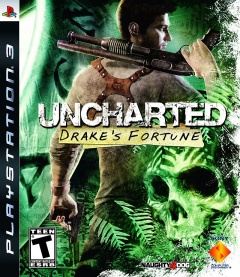 I was disappointed in Uncharted: Drake’s Fortune, I’ll just put that out there right away. The game received near universal acclaim upon release (it scores an 88 on Metacritic), but I’ve heard rumblings in the recent years that the game has problems. This isn’t uncommon, Uncharted 2: Among Thieves was released two years later to even higher scores (96 average!), so people discover things to gripe about as time passes. But I haven’t played any other Uncharteds, though the game is over four years old, maybe I’ve just soured on it in other ways.
I was disappointed in Uncharted: Drake’s Fortune, I’ll just put that out there right away. The game received near universal acclaim upon release (it scores an 88 on Metacritic), but I’ve heard rumblings in the recent years that the game has problems. This isn’t uncommon, Uncharted 2: Among Thieves was released two years later to even higher scores (96 average!), so people discover things to gripe about as time passes. But I haven’t played any other Uncharteds, though the game is over four years old, maybe I’ve just soured on it in other ways.
Released in 2007 and quickly labeled as the year old PlayStation 3’s best game, Drake’s Fortune kicks off the Uncharted series that has gone on to sell millions of copies on both the PS3 and PSP, and is headlining the recent Vita launch. It stars Nathan Drake as the supposed ancestor to real treasure hunter Francis Drake, and combines cover-system firefights with Assassin’s Creed-like climbing.
I recently published my first hour review on Uncharted, along with the complete video of its opening. If you watch it, you should definitely be able to see why I was so excited to keep playing: it has action, intrigue, and witty writing, along with a cast you can’t help but love. But problems eventually plague all aspects of the game, let’s get into them.
Read moreMarch 5, 2012 by Nate
 Thanks to the indie uprising, we have a heightened visibility for games that might have gone unnoticed just five years ago. A garage developer's labor of love can now share front page headlines with the AAA behemoths of the industry. Many fine media outlets even make a special effort to cover these smaller productions. Indie games have become the punk rockers of the industry, offering a lean alternative to overproduced AAA formulas, often with rebellious verve and spunk that resonates with us ninety-nine percenters (and at a price we ninety-nine percenters can afford).
Thanks to the indie uprising, we have a heightened visibility for games that might have gone unnoticed just five years ago. A garage developer's labor of love can now share front page headlines with the AAA behemoths of the industry. Many fine media outlets even make a special effort to cover these smaller productions. Indie games have become the punk rockers of the industry, offering a lean alternative to overproduced AAA formulas, often with rebellious verve and spunk that resonates with us ninety-nine percenters (and at a price we ninety-nine percenters can afford).
But even in this new era, where the little guys yield as many pageviews as their big budget competition, an indie game needs to have some innovative hook or bombastic message in order to rise to the top. I can think of no other reason why Fluidity, a brilliant puzzle platformer with Metroidvania elements, has gone largely unnoticed. (Except that the game is marooned on Wii's invisible WiiWare digital distribution service, that is.)
It makes sense, though, doesn't it? So many indie darlings that went big had some kind of divergent aura about them. Limbo and Braid made their names with artsy themes and visuals that you just don't see in big money productions. The cheery brutality of Super Meat Boy, Magicka, and Castle Crashers upgraded them from mere mechanical joys to acclaimed game experiences. Fluidity, on the other hand, lifts its style and mood from airline safety manuals, of all things.
Read moreFebruary 29, 2012 by Greg Noe
 I find soccer boring. It has its exciting moments, but those usually happen when I’m getting a snack. On the other hand, I’ve thoroughly enjoyed lots of soccer video games over the years, starting with Nintendo World Cup for the NES and peaking with the insane Sega Soccer Slam on the GameCube. There’s just something so simplistic and fun about kicking a ball into a goal, especially when that ball is on fire.
I find soccer boring. It has its exciting moments, but those usually happen when I’m getting a snack. On the other hand, I’ve thoroughly enjoyed lots of soccer video games over the years, starting with Nintendo World Cup for the NES and peaking with the insane Sega Soccer Slam on the GameCube. There’s just something so simplistic and fun about kicking a ball into a goal, especially when that ball is on fire.
So truthfully, I like arcade soccer, the kind of stuff displayed in the movie Shaolin Soccer. But when I discovered I was four games behind on Kairosoft’s Android releases, I decided to start with the soccer simulator: Pocket League Story.
In the same vein as Game Dev Story and Grand Prix Story, Pocket League Story has you guiding a soccer team from the dirt pile in your backyard to the top of the world. There are lots of numbers and tons of crunching, but most refreshing, every soccer game plays out in front of your eyes. If you thought watching your cars race in Grand Prix Story got me excited, well, you should have seen me when my first 11 versus 11 match played out. Here’s my review of Pocket League Story.
Read moreFebruary 27, 2012 by Nate
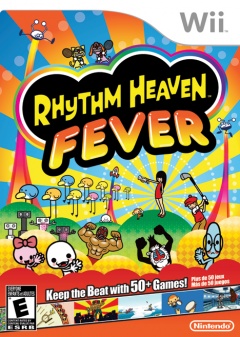 Rhythm Heaven Fever is a procession of adorable cartoon situations. A boy kicks away stray footballs that threaten to ruin his date. A quartet of baby seals tilt back-and-forth in marching-style unison. A tiny monkey taps a tambourine, its big brown eyes gleaming with joy as you repeat its patterns. The game's energetic sweetness is the antithesis of this console generation's characteristic gravelly machismo and brooding drama. It's pure joy.
Rhythm Heaven Fever is a procession of adorable cartoon situations. A boy kicks away stray footballs that threaten to ruin his date. A quartet of baby seals tilt back-and-forth in marching-style unison. A tiny monkey taps a tambourine, its big brown eyes gleaming with joy as you repeat its patterns. The game's energetic sweetness is the antithesis of this console generation's characteristic gravelly machismo and brooding drama. It's pure joy.
And yet, it wracks my nerves like a Counter-Strike match. My palms sweat as I constrict the Wii remote in a boa's death grip. My heart races before I even select a song. Like a tiger crouched in the brush, I await the right moment to strike each note with parched eyes. Even with the peppy rhythms as a constant guide, relaxation is a shortcut to failure.
You can't get careless because the game demands total precision. Guitar Hero understands that you have five frets to manage and cuts you some slack if you're a split-second early on the downbeat. Rhythm Heaven Fever scrutinizes to your timing to the millisecond: near the end of the following video, the song approaches 180 beats per minute and splits each beat into 23 blocks; I am tasked with hitting only the center column. There is no room for error.
The smiles and rainbows are a front, as the cute chimps and happy cheerleaders of Rhythm Heaven Fever know exactly how well your internal metronome is running. And they are judging you. Harshly.
Read moreFebruary 20, 2012 by Greg Noe
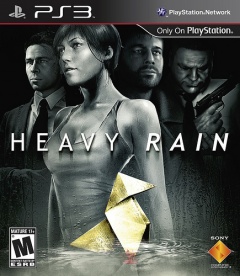 I am willing to give every video game genre a try, including what Wikipedia describes Heavy Rain as an “interactive drama” and “psychological thriller.” To the traditional gamer, those probably rank right up with the dating sim and train simulators of the world. Why play an interactive drama when I could just watch a movie?
I am willing to give every video game genre a try, including what Wikipedia describes Heavy Rain as an “interactive drama” and “psychological thriller.” To the traditional gamer, those probably rank right up with the dating sim and train simulators of the world. Why play an interactive drama when I could just watch a movie?
But this is a valid question that can be used to juxtapose any type of media. Movies are an excellent format at telling a story in about two hours, while many games take a two hour story and stretch it across 12 hours with bits of action padding the time. Heavy Rain was created from the ground up to challenge the idea that not only can a video game tell a compelling story, but that it can deliver the same emotional punches that a movie can too.
Released in February 2010 by French developer Quantic Dream, Heavy Rain tells the story of a father, a journalist, a detective, and an FBI profiler all tracking down an elusive serial killer who targets young boys. As one of the PlayStation 3 exclusives I’ve wanted to play the most, I was very excited to get my hands on the game after two years. You can see my first hour review here, or read on for spoiler-free thoughts on Heavy Rain.
Read moreFebruary 13, 2012 by Greg Noe
 I started playing Super Meat Boy for our new Indie Impression feature, planning on maybe putting in a half hour with the meat and then heading off to write down my thoughts. Two weeks later and 10 hours of gaming in the can, I beat all of Super Meat Boy’s light world levels, rescued Bandage Girl over a hundred times, and died 2,345 times (to be exact). And even though poor Meat Boy splattered every 15 seconds, I still had an awesome time.
I started playing Super Meat Boy for our new Indie Impression feature, planning on maybe putting in a half hour with the meat and then heading off to write down my thoughts. Two weeks later and 10 hours of gaming in the can, I beat all of Super Meat Boy’s light world levels, rescued Bandage Girl over a hundred times, and died 2,345 times (to be exact). And even though poor Meat Boy splattered every 15 seconds, I still had an awesome time.
It’s a testament to developer Team Meat’s ability that they can make a platformer not only crazy hard, but also very fun. Almost nothing is harder in game development than properly ramping the challenge up for every kind of gamer, but they pull it off with Super Meat Boy.
Released on Windows, Linux, OSX, and Xbox Live Arcade (a WiiWare release was planned and then scrapped when the game exceeded the platform’s size limits) in 2010, it has since sold over one million copies, not bad for an indie release. Here’s my review.
Read moreFebruary 8, 2012 by Jonathan Ramundi
 Riding on the excitement of The Binding of Isaac, I decided to dive right into another roguelike, this time from indie developer Gaslamp Games. But unlike Binding of Isaac, Dungeons of Dredmor is a more traditional, turn-based dungeon crawler, complete with character classes, skill trees, item forging, and the hack and slash-style fun one would expect from classic franchises like Diablo or Baldur’s Gate. Well, maybe not that traditional. Dungeons of Dredmor is perhaps best described as a spoof of classic computer roll-playing games; nothing takes itself seriously...
Riding on the excitement of The Binding of Isaac, I decided to dive right into another roguelike, this time from indie developer Gaslamp Games. But unlike Binding of Isaac, Dungeons of Dredmor is a more traditional, turn-based dungeon crawler, complete with character classes, skill trees, item forging, and the hack and slash-style fun one would expect from classic franchises like Diablo or Baldur’s Gate. Well, maybe not that traditional. Dungeons of Dredmor is perhaps best described as a spoof of classic computer roll-playing games; nothing takes itself seriously...
Three other writers here posted their impressions of Dungeons of Dredmor last week in our new series: Indie Impression. You may consider these my extended impression that turned into a complete review.
Read moreJanuary 20, 2012 by Greg Noe
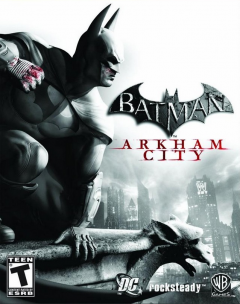 I beat Batman: Arkham City well over a week ago, but due to a weekend vacation, work, and the flu hitting my entire family, I’m only now getting to its review. This has given me time to think heavily about the game, and in some ways find as many flaws as ways to praise it, not sure if this is a healthy game reviewing technique or not.
I beat Batman: Arkham City well over a week ago, but due to a weekend vacation, work, and the flu hitting my entire family, I’m only now getting to its review. This has given me time to think heavily about the game, and in some ways find as many flaws as ways to praise it, not sure if this is a healthy game reviewing technique or not.
As the sequel to Arkham Asylum, one of the most successful and highly regarded licensed games ever, expectations were through the roof. Arkham City was released in October of last year to brisk sales and excellent reviews, skyrocketing creatorRocksteady Studios among the upper echelon of developers.
Nate covered the game’s first hour when it was released, and later named it his Game of the Year. I just named Arkham Asylum my Game of the (Other) Year as I beat it early 2011. As I’m still ailing from the effects of the flu and its corresponding medicine, I’m going to try and keep this shorter than usual.
Read moreJanuary 13, 2012 by Steve
 If someone tells you they're going to do a "reverse" something, odds are the result will be terrible. The concept sounds similarly cheesy for games, evoking memories of bad minigames and multiplayer modes. However, for some genres it actually could be a fresh take on the concept, and 11-Bit Studios tries to prove this with their "reverse tower defense" game, Anomaly: Warzone Earth. 11-Bit is a brand new developer out of Poland, powered by a small team of industry veterans. It appears that they've taken an independent mindset towards publishing and distributing, releasing Anomaly directly to Steam and the Mac Store. Thus far, they seem to be having a good deal of success and are proving capable in quickly porting their game to new platforms, including iOS, Kindle Fire (!) and an upcoming XBLA release.
If someone tells you they're going to do a "reverse" something, odds are the result will be terrible. The concept sounds similarly cheesy for games, evoking memories of bad minigames and multiplayer modes. However, for some genres it actually could be a fresh take on the concept, and 11-Bit Studios tries to prove this with their "reverse tower defense" game, Anomaly: Warzone Earth. 11-Bit is a brand new developer out of Poland, powered by a small team of industry veterans. It appears that they've taken an independent mindset towards publishing and distributing, releasing Anomaly directly to Steam and the Mac Store. Thus far, they seem to be having a good deal of success and are proving capable in quickly porting their game to new platforms, including iOS, Kindle Fire (!) and an upcoming XBLA release.
January 11, 2012 by Greg Noe
 I played quite a few mobile games in 2011, and I don't expect that to change much in 2012. Where's My Water? was available as a Free App of the Day on the Amazon Android store a few weeks ago, and I picked it without much thought and tucked it in the mobile queue. Free games are great, especially on a pick-up-and-play platform like a phone. It's pretty amazing how the ideas behind a First Hour Review can be boiled down from 60 minutes to 30 seconds.
I played quite a few mobile games in 2011, and I don't expect that to change much in 2012. Where's My Water? was available as a Free App of the Day on the Amazon Android store a few weeks ago, and I picked it without much thought and tucked it in the mobile queue. Free games are great, especially on a pick-up-and-play platform like a phone. It's pretty amazing how the ideas behind a First Hour Review can be boiled down from 60 minutes to 30 seconds.
Where's My Water? passed my immediate test of being playable and having an interesting concept; a few days later with every rubber ducky collected and all the challenge levels defeated, I'm ready to declare it a triumphant mobile game along the lines of Angry Birds and Cut the Rope, here are my thoughts.
Read moreJanuary 3, 2012 by Nate
 Upon starting Super Mario 3D Land, I was placing internal bets on whether the game would be filed with the 2D or the 3D Mario experiences. Miyamoto and the team say they combined the approachability of 2D Mario with the freedom of the third dimension, but one of the two styles must win out, right?
Upon starting Super Mario 3D Land, I was placing internal bets on whether the game would be filed with the 2D or the 3D Mario experiences. Miyamoto and the team say they combined the approachability of 2D Mario with the freedom of the third dimension, but one of the two styles must win out, right?
Exactly fourteen hours of playtime later, the answer still eludes me. There's bits of Super Mario Galaxy and pieces of New Super Mario Bros in the game, and it leans heavily towards the former. What's keeping me from committing 3D Land to the 2D Mario pile is all the Sonic Adventure mucking things up.
Despite the disappointment, elation, and outright disdain that those three names likely bring up, they ultimately mean little for the actual quality of the game. It would be difficult to argue that Super Mario 3D Land is anything other than the Nintendo 3DS' most compelling purchase to date. But it's also the first Mario title in several years that I can't just rave about.
Read moreDecember 30, 2011 by Greg Noe
 We have time to slip one more review into 2011, right? Let's talk about Recettear: An Item's Shop Tale, a quirky Japanese RPG released last year. Blending traditional dungeon crawling with running an RPG item shop, Recettear is unlike any game I have ever played, and probably ever play again.
We have time to slip one more review into 2011, right? Let's talk about Recettear: An Item's Shop Tale, a quirky Japanese RPG released last year. Blending traditional dungeon crawling with running an RPG item shop, Recettear is unlike any game I have ever played, and probably ever play again.
I played the first hour of Recettear in October, determining that the opening was interesting enough to go on. This was probably a fair decision, as it is a rich game full of dungeons, companions, and items, but it is not without issues. If the review intrigues you, look for it on Steam sale in the next day or so, it was about $5 a few days back and may be available again.
Recettear is made up of two distinct game types: the classic dungeon crawler with randomized floor layouts, spawning bad guys, and big bosses; and an item shop where you lay out equipment, haggle with customers, and even buy items from them. Let's talk about what each type did right and wrong.
Read moreDecember 28, 2011 by Greg Noe
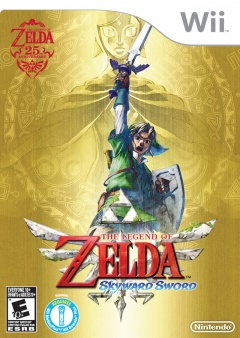 The Legend of Zelda: Twilight Princess was my primary reason for buying a Wii at launch. It left me feeling disappointed and greatly annoyed. Five years later, beating The Legend of Zelda: Skyward Sword on my second Wii (after selling my first just days after beating Twilight Princess) leaves me with nearly the opposite effect: I loved it and am slightly giddy to write a review about it before the end of the year.
The Legend of Zelda: Twilight Princess was my primary reason for buying a Wii at launch. It left me feeling disappointed and greatly annoyed. Five years later, beating The Legend of Zelda: Skyward Sword on my second Wii (after selling my first just days after beating Twilight Princess) leaves me with nearly the opposite effect: I loved it and am slightly giddy to write a review about it before the end of the year.
I was definitely not feeling the game a few hours in. Twilight Princess’ first hour is awful and Skyward Sword’s is arguably worse, and the ramp up feels tedious. My list of annoyances was longer than any kind of enjoyment I was getting out of the game, but once the game does ramp up, it does it incredibly successfully.
So as the Wii’s last hurrah, Skyward Sword leaves a great impression, here’s my review of the latest Legend of Zelda game, released in November. This is our second full review of the game, following Nate’s from last week. I re-read his review in preparation for my own, and have to say I agree on basically every point. So hopefully this review won’t be longer than it needs to be, but if you have some time, do read his write-up.
Read moreDecember 23, 2011 by Nate
 The lasting impression from my recent introduction to the original Legend of Zelda was its unstructured progression. With only a ghost of a narrative driving the action and few barriers to limit wanderlust, the course of my trip through Hyrule was almost entirely up to me. Having played Ocarina of Time before any other Zelda game, I was surprised to see just how hands-off the original was.
The lasting impression from my recent introduction to the original Legend of Zelda was its unstructured progression. With only a ghost of a narrative driving the action and few barriers to limit wanderlust, the course of my trip through Hyrule was almost entirely up to me. Having played Ocarina of Time before any other Zelda game, I was surprised to see just how hands-off the original was.
In contrast, last month's Skyward Sword may be the most linear Zelda experience yet. The newest quest sees Link flying from one compact landmass to the next with hardly any room for side trips. The vast sky of islands is sparser than Wind Waker's nearly endless ocean, and even the surface world below is but three masses of land separated by impenetrable mountain ranges and deserts and forests. This is a Zelda where the path to the next waypoint is often the only path.
Every game in the series since the eighties original has trended towards structure and direction as story progression and ability acquisition gained a greater share of the Zelda spirit. Aesthetic similarities and recurring tropes aside, The Legend of Zelda and Skyward Sword could be mistaken for two wholly separate franchises. For better or worse, Skyward Sword feels like the end state of a slow evolution that Nintendo has been cooking for twenty-five years.
Read moreDecember 7, 2011 by Jonathan Ramundi
 Following in the wake of the widely popular Super Meat Boy, Edmund McMillen’s latest entry, The Binding of Isaac, takes its name and narrative from a story in the Book of Genesis. In that tale, Abraham is called to sacrifice his son, Isaac, as a proof of his devotion to God. Isaac is bound by his father and placed upon an altar on top of Mount Moriah, where an angel appears to stop Abraham just before the slaughter.
Following in the wake of the widely popular Super Meat Boy, Edmund McMillen’s latest entry, The Binding of Isaac, takes its name and narrative from a story in the Book of Genesis. In that tale, Abraham is called to sacrifice his son, Isaac, as a proof of his devotion to God. Isaac is bound by his father and placed upon an altar on top of Mount Moriah, where an angel appears to stop Abraham just before the slaughter.
The Binding of Isaac has players taking control of the titular character, whose mother is called to kill her son as a sacrifice to God. In this story, however, there is no angel to stop the fanatic parent; it’s up to Isaac to survive, fleeing the clutches of his murderous mother in the basement of their house.
The artwork and style are synonymous with that of McMillen’s other works, such as Super Meat Boy and Gish (both of whom make cameo appearances), but, taking a break from platforming, level design and gameplay share similarities with The Legend of Zelda. The interface also shares a resemblance. However, unlike the series from which it seemingly draws inspiration, The Binding of Isaac features fully randomized levels, items, enemies, and even bosses. Another key feature is the aspect of permanent death. You have one and only one life to clear the dungeon-like levels and defeat the final boss, which serves to make The Binding of Isaac a very challenging and nerve-racking experience.
Read moreNovember 18, 2011 by Ian M. Bagley
 It's been awhile since I've written anything for First Hour; between marriage, work, college and some gaming, there isn't much time for writing. But this is a special month, a month that I've been looking forward to for a long time.
It's been awhile since I've written anything for First Hour; between marriage, work, college and some gaming, there isn't much time for writing. But this is a special month, a month that I've been looking forward to for a long time.
Last Friday, November 11th, 2011, was the release of Skyrim, possibly the most anticipated game of this year, right next to Call of Duty: Modern Warfare 3. So today, I am reviewing The Elder Scrolls IV: Oblivion.
I had played Morrowind religiously for roughly six months. In fact, it was the second game I bought for the original Xbox. It was an incredible experience, to face a giant world with so many dangers, and so much customizing, I became massively invested. I played at least six hours a day during the school week and twelve during Saturday and Sunday.
So after years of playing The Elder Scrolls III: Morrowind, my sophomore self was surprised to see Oblivion on the cover of a Game Informer in the high school library. I was in awe at the graphics, the hope for a better combat system. But the most amazing thing, that reportedly happened at Bethesda as well, was seeing what was once thought impossible: they had forests. Real, bustling forests with bushes and shrubbery and groups of trees.
I couldn't stop thinking about it, and then it was finally released. I was amazed at the game. Now, let's take and nice overview about some of the feelings and thoughts of the game before and after Oblivion's release.
Read moreNovember 7, 2011 by Paul Abbamondi
 Evidently, I’ve been coddled by stealth-based videogames for far too long. Metal Gear Solid gives players a large radar on their HUD showcasing soldiers’ cones of vision, allowing me to know just how far they saw and when to make my move; it only jammed now and then, leaving Solid Snake feeling clothed yet naked, but otherwise the radar remained a constant and vital companion during the fall of FOXHOUND. The Tenchu franchised handed out safe rooftops like candy. The Sly Cooper games, no matter what locale, always offered a number of places to hide or grapple on or tip-toe across; it also taught me how to pickpocket with a cane. Assassin’s Creed: Brotherhood had so many ways to hide and blend in with the public that it almost seemed like the point of the game was to be a commoner and not a kick-ass, hidden blade-wielding Casanova—actually, that’s how their online multiplayer does it. Sneaking through the massive cities was never terribly tricky, and if you messed up, there always seemed to be a way to quickly erase your footprints and try again. While certainly some skill is needed, most videogames involving stealth are pretty forgiving.
Evidently, I’ve been coddled by stealth-based videogames for far too long. Metal Gear Solid gives players a large radar on their HUD showcasing soldiers’ cones of vision, allowing me to know just how far they saw and when to make my move; it only jammed now and then, leaving Solid Snake feeling clothed yet naked, but otherwise the radar remained a constant and vital companion during the fall of FOXHOUND. The Tenchu franchised handed out safe rooftops like candy. The Sly Cooper games, no matter what locale, always offered a number of places to hide or grapple on or tip-toe across; it also taught me how to pickpocket with a cane. Assassin’s Creed: Brotherhood had so many ways to hide and blend in with the public that it almost seemed like the point of the game was to be a commoner and not a kick-ass, hidden blade-wielding Casanova—actually, that’s how their online multiplayer does it. Sneaking through the massive cities was never terribly tricky, and if you messed up, there always seemed to be a way to quickly erase your footprints and try again. While certainly some skill is needed, most videogames involving stealth are pretty forgiving.
But then came Deus Ex: Human Revolution, a game I tried to play stealthily, but failed miserably, eventually throwing in the towel and just shooting enemies until they breathed no more. The first hour should’ve been a clear indication of what was to come, but I’m stubborn and continued to drop Praxis point after Praxis point into perks like “see through walls” and “hack computers up to level 5.” No points were ever devoted to fixing Jensen’s shooting ability or giving him more backpack space. All I needed—or so I thought—was my tranquilizer rifle, some darts, and the smarts to crack every keypad and computer this side of future Detroit. Turns out, I needed a lot more than that.
Read moreNovember 2, 2011 by Nate
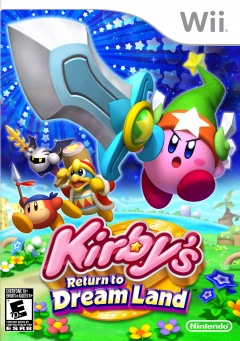 For the longest time, all I wanted from Nintendo was a new Kirby game with awesome copy abilities like in Kirby Super Star. No franchise has a track record like Kirby when it comes to spinoffs and experiments, but the SNES classic that boasted "8 games in one" is the series' greatest feat. For over a decade, my wish went unfulfilled.
For the longest time, all I wanted from Nintendo was a new Kirby game with awesome copy abilities like in Kirby Super Star. No franchise has a track record like Kirby when it comes to spinoffs and experiments, but the SNES classic that boasted "8 games in one" is the series' greatest feat. For over a decade, my wish went unfulfilled.
But hey, we finally got one, appropriately dubbed Kirby's Return to Dream Land! It's exactly what I wanted: the twenty standard copy abilities are the series' best, with strong debuts and enhanced returns counted among Kirby's repertoire. It's amazing how many tricks you have up your sleeve with just a D-pad and a single button.
You have to be careful what you wish for, though. When dealing with a genie or blowing out your birthday candles, always make sure to choose your words deliberately and plan for stipulations and potential fallouts. Otherwise, you might end up with Kirby's Return to Dream Land, a game with tons of cool attacks and not much worth attacking.
Read moreSeptember 28, 2011 by Greg Noe
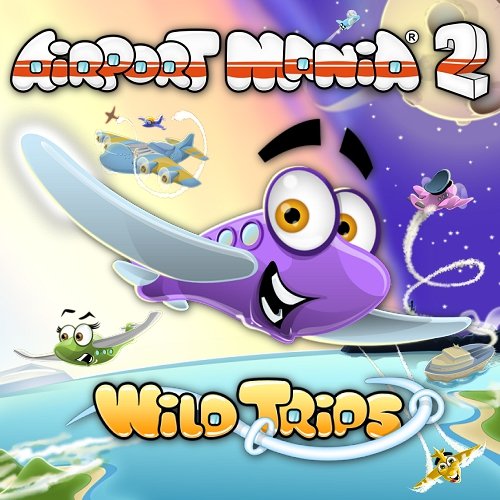 Wikipedia says Airport Mania 2: Wild Trips' genre is "Click Management", which sounds like the category Microsoft Excel would also be filed under. But trust me, Airport Mania 2 is infinitely more fun. In the same vein as Diner Dash, Sally Spa, and all the hundreds of other click management, strategy, time management clones out there, the goal is to efficiently do something with limited resources. But Airport Mania 2 stands above the rest with high polish and attractive graphics.
Wikipedia says Airport Mania 2: Wild Trips' genre is "Click Management", which sounds like the category Microsoft Excel would also be filed under. But trust me, Airport Mania 2 is infinitely more fun. In the same vein as Diner Dash, Sally Spa, and all the hundreds of other click management, strategy, time management clones out there, the goal is to efficiently do something with limited resources. But Airport Mania 2 stands above the rest with high polish and attractive graphics.
Developed by Reflex Entertainment and South Wind Games, the original Airport Mania: First Flight, was a mild success for Windows and OSX in 2008. Re-released on nearly every portable platform since then (including DSiWare), they've slowly been building their airport simulator empire. Airport Mania 2, released earlier this year, is an upgrade of the original but still carries all the charm.
Airport Mania 2 is less of an airport simulator and more of an air-traffic control strategy game. Let's take a quick look at the Android version released a few weeks ago.
Read moreSeptember 26, 2011 by Nate
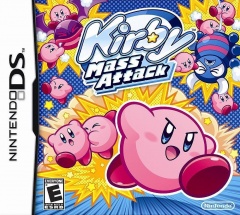 Like the titular pink puff, the Kirby series has worn many hats in its nineteen years. Almost every 2D action-platformer has been partnered with an experimental pinball sim or an arcade racer or some amazing miniature golf mutation. As much as I enjoy each iteration of the main Dream Land style, the spinoffs are what really intrigue me, even when they fail. Sure, Kirby Tilt 'n Tumble may be unplayable with the Game Boy Color's dark screen and restrictive viewing angle, but it broke ground for motion controls six years before Wii Sports taught us to waggle.
Like the titular pink puff, the Kirby series has worn many hats in its nineteen years. Almost every 2D action-platformer has been partnered with an experimental pinball sim or an arcade racer or some amazing miniature golf mutation. As much as I enjoy each iteration of the main Dream Land style, the spinoffs are what really intrigue me, even when they fail. Sure, Kirby Tilt 'n Tumble may be unplayable with the Game Boy Color's dark screen and restrictive viewing angle, but it broke ground for motion controls six years before Wii Sports taught us to waggle.
It's a good season for Kirby fans, as we get a bit of both sides in under two months. Kirby's Return to Dream Land in October looks like the long-awaited Super Star successor, and September sees Kirby get multiplied in Kirby Mass Attack. Revisiting the stylus-centrism of Canvas Curse, Mass Attack tasks players with flicking, dragging, and leading up to ten Kirbys at a time through a puzzle platforming adventure. It's not the most eye-opening Kirby spinoff -- the concept is essentially a pared-down Pikmin -- but it makes the most of a middling concept.
Kirby Canvas Curse was widely dubbed the Nintendo DS's first worthy purchase. Kirby Mass Attack may be its last.
Read moreSeptember 23, 2011 by Greg Noe
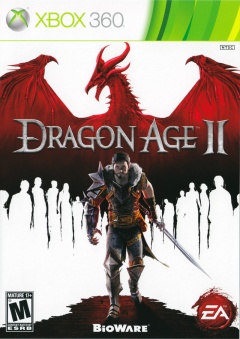 I was a bit worried going into my playthrough of Dragon Age 2. The first screenshots revealed a depressingly gray world with curiously pointy polygons, and reader reviews of the game blasted it for a variety of reasons. But my first hour review of the title cemented me firmly in the “I’m going to enjoy this game” category, and 40 hours later I emerged with some sore fingers and a smile on my face.
I was a bit worried going into my playthrough of Dragon Age 2. The first screenshots revealed a depressingly gray world with curiously pointy polygons, and reader reviews of the game blasted it for a variety of reasons. But my first hour review of the title cemented me firmly in the “I’m going to enjoy this game” category, and 40 hours later I emerged with some sore fingers and a smile on my face.
It’s understandable why some gamers didn’t enjoy Dragon Age 2, in some ways it’s quite a departure from the stable, Western RPG tropes that Dragon Age: Origins employed, but deep down, it really is the first game’s sequel. Some aspects have been streamlined, for better and worse, but I always felt like I was in the Dragon Age universe I spent 50 hours in last time around.
Dragon Age 2 was released for Xbox 360, PlayStation 3, Windows, and OSX. I played a used copy on the Xbox 360, meaning I didn’t have access to any downloadable content that was provided for first-time buyers.
Read moreSeptember 14, 2011 by Greg Noe
 I didn’t play a whole lot of Enix games growing up. I rented a few titles for the Super Nintendo, including E.V.O.: The Search for Eden, Ogre Battle, and 7th Saga, but it wasn’t until I beat Star Ocean 2 during college that I could poke out the Enix notch in my belt. Their merger with Squaresoft in 2003 blew my mind, but I had grown up in the world where publishers were like armies, constantly battling it out with each other for supremacy; but in the real world it was all business, and the merger made sense.
I didn’t play a whole lot of Enix games growing up. I rented a few titles for the Super Nintendo, including E.V.O.: The Search for Eden, Ogre Battle, and 7th Saga, but it wasn’t until I beat Star Ocean 2 during college that I could poke out the Enix notch in my belt. Their merger with Squaresoft in 2003 blew my mind, but I had grown up in the world where publishers were like armies, constantly battling it out with each other for supremacy; but in the real world it was all business, and the merger made sense.
Illusion of Gaia was released during the time when Enix was in a heated battle (business and fanboy-wise) with Squaresoft on the Super Nintendo platform. In its six year lifespan, both publishers released over 30 games each, many competing directly in sub-genres that seem too similar to be considered a coincidence. One of these face-offs was Secret of Mana from Squaresoft against Illusion of Gaia from Enix. Released in 1993, both games were action RPGs that happily broke the mold of the Final Fantasies and Dragon Quests.
But in the end, Squaresoft easily won the action RPG battle and the Super Nintendo war. Secret of Mana was an engrossing, multiplayer tale with a huge variety of weapons and magic, Illusion of Gaia was a rather rote, singleplayer, cobbled-together adventure with little variety. Here’s its review.
Read moreSeptember 12, 2011 by Nate
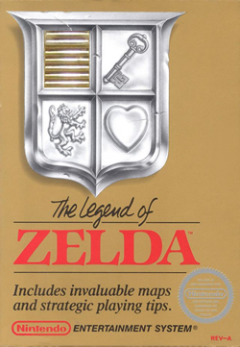 Achievement Unlocked: Review a game older than you.
Achievement Unlocked: Review a game older than you.
Zelda may be the most beloved video game franchise, but I've never counted myself among series super-fans. Since cutting my teeth on the series with Ocarina of Time, I've merely enjoyed all but a handful of games in the series. Don't get me wrong, they're all great, but I wouldn't put any in my top ten.
That said, I like checking out each title and comparing it with the rest of its ilk. Other than the experimental black sheep Zelda II: Adventure of Link, the first Legend of Zelda may be the series' most divisive game. Fans can't seem to agree whether the game's old school difficulty and unguided progression make it dated or just different. Lacking an in-game overworld map and never funneling players away from difficult areas, the NES original certainly requires more of its players than any Zelda since.
Nintendo recently launched its 3DS Ambassador program, giving the system's early adopters ten free NES games. I had been meaning to check out several of the ambassador titles, but none more so than The Legend of Zelda. Fifteen hours and a princess rescue later, I'm ready to weigh in on the Dated vs. Different debate.
Read moreSeptember 7, 2011 by Steve
 Plants vs. Zombies is a game I've been eyeing for a while. It regularly tempted me at $10 Steam with even cheaper sale prices. This summer's sale finally put me over the edge. Every so often you need some good tower defense action, and PvZ seemed like a unique yet highly praised take on the genre. Its cartoonish, Popcap/flash feel and simple five-lane setup makes things perfect for beginners. And it has enjoyed massive success over a huge variety of platforms. Originating on PC, PvZ has since expanded to every modern platform imaginable, both traditional and mobile. Popcap is undeniably a casual gaming powerhouse. The Bejeweled and Feeding Frenzy creators certainly know how to make products and pricing that clicks with the average consumer. They've been so successful that EA recently purchased the company for ~$750 million.
Plants vs. Zombies is a game I've been eyeing for a while. It regularly tempted me at $10 Steam with even cheaper sale prices. This summer's sale finally put me over the edge. Every so often you need some good tower defense action, and PvZ seemed like a unique yet highly praised take on the genre. Its cartoonish, Popcap/flash feel and simple five-lane setup makes things perfect for beginners. And it has enjoyed massive success over a huge variety of platforms. Originating on PC, PvZ has since expanded to every modern platform imaginable, both traditional and mobile. Popcap is undeniably a casual gaming powerhouse. The Bejeweled and Feeding Frenzy creators certainly know how to make products and pricing that clicks with the average consumer. They've been so successful that EA recently purchased the company for ~$750 million.
For the most part, PvZ exemplifies this success. It creates a casual-friendly atmosphere with calculated progressive learning combined with enough longevity and a tad of optional difficulty to round out the complete package. The game starts slowly, at first holding your hand with only a couple plant options (towers) available to defend your house from a weak zombie horde on a completely barren level. With only five lanes to defend, beginners will learn quickly what it takes to operate. In case they make mistakes, the game includes a get-out-of-jail-free card, in the form of zombie-clearing machines that activate and clear the lane should a zombie make it past the plants. For a while, the game introduces a new plant on almost every level, encouraging the player to try them out and discover what they're worth. Soon enough, juggling several plant types on more obnoxious levels will be a requirement.
Read moreAugust 19, 2011 by Greg Noe
 I’m pretty new to the tower defense genre, I missed out on the first few waves of games including the massively popular Desktop Tower Defense, and first experienced it with Plants vs. Zombies, which is probably a sub-genre of its own. But since buying my Android phone, I’ve been exposed to a lot of games I couldn’t imagine myself playing even a few months ago. Two of those are tower defense games.
I’m pretty new to the tower defense genre, I missed out on the first few waves of games including the massively popular Desktop Tower Defense, and first experienced it with Plants vs. Zombies, which is probably a sub-genre of its own. But since buying my Android phone, I’ve been exposed to a lot of games I couldn’t imagine myself playing even a few months ago. Two of those are tower defense games.
Fieldrunners HD and GRave Defense HD are great examples of two distinct approaches at the tower defense genre. Both are easy to pick up and play for 10 minutes, but are amazingly effective at grabbing you in for over an hour. However, that is where the similarities end, and it is their differences that really define them.
Both titles are available right now for under $3 on the Android Market, and Fieldrunners is also available on a wide variety of devices including iOS and the Nintendo DS. Here’s my short reviews of Fieldrunners HD and GRave Defense HD.
Read moreAugust 17, 2011 by Greg Noe
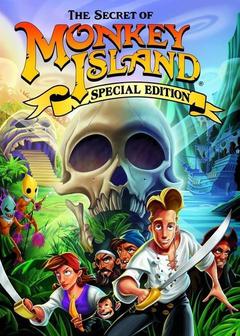 I first played The Secret of Monkey Island about 20 years ago. This was an era of launching games from DOS, Commander Keen, and wheel spinning copy protection. I played the game with my cousin, who would frequently lose the Dial-a-Pirate code wheel forcing us to wildly guess at the game’s opening question.
I first played The Secret of Monkey Island about 20 years ago. This was an era of launching games from DOS, Commander Keen, and wheel spinning copy protection. I played the game with my cousin, who would frequently lose the Dial-a-Pirate code wheel forcing us to wildly guess at the game’s opening question.
The Special Edition released in 2009 thankfully does not have any code wheels (or even worse: always-on internet connection), but does feature completely redone high resolution art, a full voice cast, and the same brand of humor fans of the game know and love.
I’m personally a huge fan of the Monkey Island series, with the second holding a very special place in my heart and the third (gasp!) being my favorite. And while I beat the original when I was younger, I never held a lot of nostalgia for it, so this review is actually coming from a fan of the series who likes the first one the least in the trilogy And no, there is no fourth game.
Paul Eastwood originally reviewed the Special Edition two years ago when it was new, I finally got around to beating it this weekend after having it sit in my Steam library since release. Here is my review of The Secret of Monkey Island: Special Edition.
Read moreAugust 12, 2011 by Greg Noe
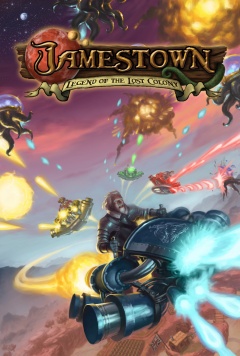 It’s been years since I played a shoot ‘em up. I bought Ikaruga during college basically as a blind buy, and Steve and I played a ton of four player Giga Wing 2 on the Dreamcast, but since then? Well, I played the first hour of Pocky & Rocky... that’s about it. I partially blame this on my system of choice being the DS for the last few years, and also because I’m not very good at the genre. Bullet hell is a term for a reason.
It’s been years since I played a shoot ‘em up. I bought Ikaruga during college basically as a blind buy, and Steve and I played a ton of four player Giga Wing 2 on the Dreamcast, but since then? Well, I played the first hour of Pocky & Rocky... that’s about it. I partially blame this on my system of choice being the DS for the last few years, and also because I’m not very good at the genre. Bullet hell is a term for a reason.
But I was gifted Jamestown: Legend of the Lost Colony during the Steam Summer Sale (thanks Rowan Kaiser, writer at The A.V. Club), so I had the obligation to return to the shmup, essentially kicking and screaming. I knew very little about the just released indie shooter, so here are the quick details: Jamestown is an alternate history story of early American settlers on Mars. Suspension of belief required. Just imagine 17th century Europeans had spaceships and decided to settle Mars instead of North America.
Also know this: Jamestown is a great game, here’s my review.
Read moreAugust 5, 2011 by Nate
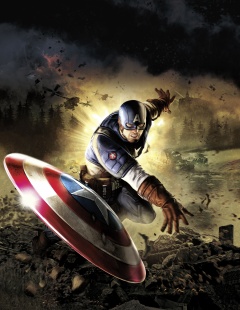 Aww yeah, it's a SHOVELWARE SHOWDOWN!
Aww yeah, it's a SHOVELWARE SHOWDOWN!
In the last two weeks, I started Captain America: Super Soldier for both the PS3 and Wii. At hour's end, I decided to keep playing each game, but with the expectation that I wouldn't actually finish either. As it turns out, I stuck with both through the credits. And I didn't do it solely for masochism's sake: movie license hex be damned, neither version of Captain America is mere shovelware. They won't be gunning for any Game of the Year awards, but they are games worth playing for the right price.
Okay, so they're not bad. But which version of Captain America: Super Soldier is the not baddest? The choice isn't as simple as HD versus SD, like in many Wii port afterthoughts: the parallels are there, but these are two very different games. In classic head-to-head style, check out how each of the versions stacks up against each other in their major elements.
Read moreAugust 1, 2011 by Greg Noe
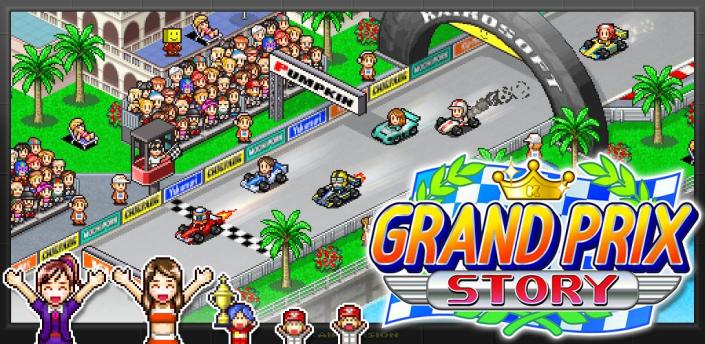 Kairosoft has quickly become my favorite developer on mobile platforms. With the English release of Game Dev Story last year, Kairosoft has placed themselves as the premier simulation creator on iOS and Android. Game Dev Story was followed up by the SimCity-esque Hot Springs Story, and then Android received the exclusive Grand Prix Story a few months back (Pocket Academy, a high school simulation was released exclusively for iPhone and iPad).
Kairosoft has quickly become my favorite developer on mobile platforms. With the English release of Game Dev Story last year, Kairosoft has placed themselves as the premier simulation creator on iOS and Android. Game Dev Story was followed up by the SimCity-esque Hot Springs Story, and then Android received the exclusive Grand Prix Story a few months back (Pocket Academy, a high school simulation was released exclusively for iPhone and iPad).
Kairosoft has been a very active developer the last few years in Japan, with over 20 releases, including already released sequels to some of their English titles. Their lineup of games ranges from the ordinary to bizarre to simply inspired, with Game Dev Story serving as a catalyst for new markets.
I reviewed Hot Springs Story a few weeks ago, and quite enjoyed both the similarities and differences it had to Game Dev Story. From the games released outside of Japan, there appears to be two types of gameplay: the straight up numbers game like Game Dev Story, and the Hot Springs style layout designer/builder. Grand Prix Story falls under the former, Pocket Academy under the latter. Here's my review of Grand Prix Story for Android, played on an EVO 4G. I hope to have a Pocket Academy review soon.
Read moreJuly 20, 2011 by Steve
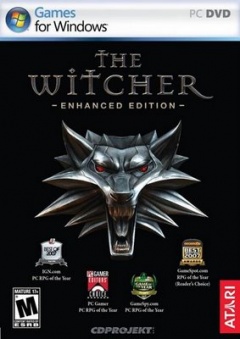 Very rarely do developers aim to make AAA PC exclusives anymore. As one of the most well regarded action-rpgs in recent history and aided by numerous recommendations, I felt it was my duty to try The Witcher. Its developer, CD Projekt, is a Polish firm who's been translating and publishing PC games since the mid-90s. Recently they've been spending money to expand, opening up the RED STUDIO for game development and creating Good Old Games as a DRM-free retro gaming service for modern computers.
Very rarely do developers aim to make AAA PC exclusives anymore. As one of the most well regarded action-rpgs in recent history and aided by numerous recommendations, I felt it was my duty to try The Witcher. Its developer, CD Projekt, is a Polish firm who's been translating and publishing PC games since the mid-90s. Recently they've been spending money to expand, opening up the RED STUDIO for game development and creating Good Old Games as a DRM-free retro gaming service for modern computers.
So far, only The Witcher and its sequel have been released by the studio, with Witcher coming out in October 2007 and Assassins of Kings hitting just two months ago (in May 2011). These projects are large in scope, using source material from a Polish novel series and brought to life by large development teams. The Witcher immediately brings a fresh start to the tale as our hero Geralt mysteriously reappears with amnesia, after apparently being killed by an angry mob. So let's see how this story goes. I'm playing the latest version, the Enhanced Edition Director's Cut.
Read moreJuly 18, 2011 by Greg Noe
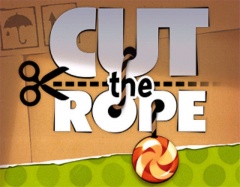 I apologize for writing more about mobile games lately than general mainstream console titles. I’m in the middle of moving and sitting down for 15 minutes with Hot Springs Story, Angry Birds, or Cut the Rope is a lot easier than an hour or two with Dragon Age II.
I apologize for writing more about mobile games lately than general mainstream console titles. I’m in the middle of moving and sitting down for 15 minutes with Hot Springs Story, Angry Birds, or Cut the Rope is a lot easier than an hour or two with Dragon Age II.
So I’ve been tearing through a series of cheap or free games on the Android, taking advantage of Amazon’s free app of the day and sales on the Market. The great thing about mobile games, even over DS titles, is that they’re so darn cheap, if you don’t like the game, delete it and move on. While I could write a few paragraphs on a game I only gave 15 minutes then promptly deleted, I’d rather focus my energy on games I really enjoyed and believe are worth even their minor asking price.
Cut the Rope recently landed on the Android platform after a successful run on Apple’s iOS, and after first hitting the indie market GetJar for free (supported by ads), it is now on the official Market and Amazon ad-free for a dollar. Here’s my review of Cut the Rope on Android.
Read moreJuly 11, 2011 by Greg Noe
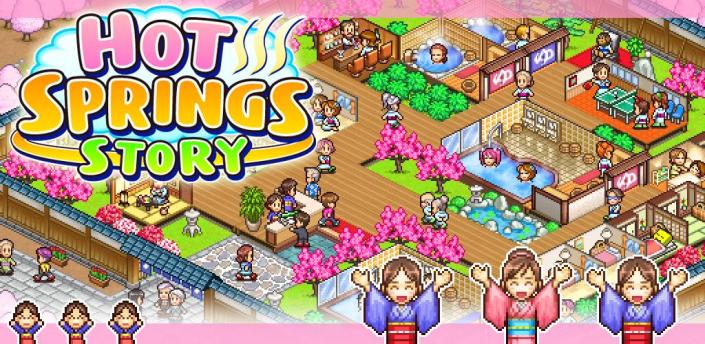 Game Dev Story was kind of a perfect storm video game for me. It combined my love for deep simulations with game development and threw in some lovely pixel art to top it all off. Hot Springs Story is Game Dev’s successor, and while I have been in hot springs in Japan, I had little interest in managing one. But since this is Kairosoft and knowing how much I enjoyed developing games within a game, I had to jump at it.
Game Dev Story was kind of a perfect storm video game for me. It combined my love for deep simulations with game development and threw in some lovely pixel art to top it all off. Hot Springs Story is Game Dev’s successor, and while I have been in hot springs in Japan, I had little interest in managing one. But since this is Kairosoft and knowing how much I enjoyed developing games within a game, I had to jump at it.
While I originally played Game Dev Story on an iPod Touch, I played Hot Springs Story on an Android EVO 4G. It has a much larger and better looking screen, which is great because Hot Springs Story does a much grander job taking advantage of all the screen real estate available.
Let’s get into my review of Hot Springs Story, developed by Kairosoft for Android and iOS.
Read moreJune 29, 2011 by Nate
 One of the fun attributes of film noir is that, while often filmed in a stark black and white style, the characters and situations aren't so easily sorted. Good guys can keep bad habits, damsels in distress can turn femme fatale, and the line between cop and crook gets muddy. Black and white is the look, but gray is the tone.
One of the fun attributes of film noir is that, while often filmed in a stark black and white style, the characters and situations aren't so easily sorted. Good guys can keep bad habits, damsels in distress can turn femme fatale, and the line between cop and crook gets muddy. Black and white is the look, but gray is the tone.
L.A. Noire, Rockstar's latest critical smash, pays tribute to film noir's unclear nature not only in style but also in its design. A vast open world is the stage for a linear story. Modern gunfights and street races play nice with adventure game relics and intuition simulation that should prove to be the game's lasting legacy. And, given the task, I'd place L.A. Noire somewhere in the spectrum between pretty good and almost great.
But to be honest, that's not really what this piece turned out to be. It's not quite a review, but not really just a critique, either. Want a review? Here: "L.A. Noire isn't a bad game by any standard, but it's more an interesting experiment than it is a great experience." I'll even throw a number at you. "7." Bam, reviewed.
With that addressed, the following is a look at a few of the ways L.A. Noire straddles many seemingly opposite design elements. Sometimes this leads to nagging issues, others to surprise delights. But more often than not, it's hard to say either way.
Read moreJune 10, 2011 by Greg Noe
 About a month and a half ago I bought my first smartphone, the EVO 4G. It's an excellent phone with a huge screen and lovely graphics. Being a device paid for and intended for work, the first thing I did with it was download a bunch of games. I gave my wife an iPod Touch a year and a half ago so I was pretty familiar with the mobile gaming scene and have posted reviews on various games including Plants vs. Zombies, Dead Panic, and Bad Cube.
About a month and a half ago I bought my first smartphone, the EVO 4G. It's an excellent phone with a huge screen and lovely graphics. Being a device paid for and intended for work, the first thing I did with it was download a bunch of games. I gave my wife an iPod Touch a year and a half ago so I was pretty familiar with the mobile gaming scene and have posted reviews on various games including Plants vs. Zombies, Dead Panic, and Bad Cube.
Right now I would say that the Android gaming scene is doing just okay. Most of the games are simply ports from iOS and the original games aren't incredibly original. The platform doesn't really have that single iconic gem that is Android's and Android's alone. I'm sure it will come in the future, but for now, we'll have to be satisfied with seconds.
Today I'll just be covering the Angry Birds games, but I plan to write more about the Android gaming platform in the future.
Read moreJune 8, 2011 by Nate
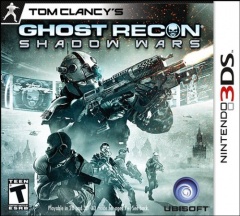 Very few titles available at a system's launch are ever worth the price of admission. Thing is, they don't have to be: early adopters don't have any other choices, and they certainly aren't taking home that shiny new box with nothing to play. If a launch window game isn't a glitchy, feature-stripped port of a last-gen game, then it may just be the best of the bunch.
Very few titles available at a system's launch are ever worth the price of admission. Thing is, they don't have to be: early adopters don't have any other choices, and they certainly aren't taking home that shiny new box with nothing to play. If a launch window game isn't a glitchy, feature-stripped port of a last-gen game, then it may just be the best of the bunch.
Ubisoft in particular doesn't have a great track record when it comes to launch games. They were the first third party to reveal their Wii hand with the ambitious and roundly disappointing Red Steel, threw straight up shovelware at the DS, and didn't exactly set any precedents at the dawn of the HD era, either. For the 3DS, Ubi's launch day contributions took the forms of Rayman 3D, Asphalt 3D, Combat of Giants: Dinosaurs 3D, and Ghost Recon: Shadow Wars.
It doesn't surprise me, then, that Ghost Recon: Shadow Wars is a technical mess. The visuals wouldn't turn heads on PSP, slowdown is common, and everything just feels rough around the edges. Oh, and then the game freezes every now and then. Sometimes you'll get the black screen of death, other times the audio will stop and the display will just fade out. In the time I was playing, Shadow Wars crashed on me a grand total of ten times.
What surprises me is that, despite these glaring technical issues, I will still recommend the game to 3DS early adopters.
Read moreJune 1, 2011 by Nate
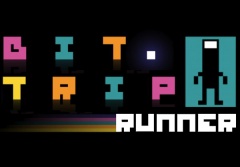 The era of digital distribution has been good to many smaller developers. One needs to look no further than the Minecraft success story to see just how fruitful the budget game market can be.
The era of digital distribution has been good to many smaller developers. One needs to look no further than the Minecraft success story to see just how fruitful the budget game market can be.
Even on Nintendo's meager WiiWare service, some have found the opportunity to shine. Gaijin Games, a small studio founded by a former LucasArts employee, has found acclaim with its Bit.Trip series. With six games in the series released within two years, each Bit.Trip title is built on the same foundation of rhythm and psychedelic retro aesthetics but offers a different gameplay hook. Beat, the first title, is like the love child of Pong and a laser show. Core is more like a tricky Guitar Hero with a D-pad. Void is an avoid-and-collect using the nunchuk's control stick. Fate is a rail shooter utilizing the Wii remote's pointer. And Flux, the final chapter in the Bit.Trip saga, returns to an experience similar to the choreographed Pong performance that birthed the series in Beat.
I recently acquired Bit.Trip Runner, the fourth game released (and the third I've played, after Void and Beat). It happens to be the one that generates the most buzz in the gaming community. Runner certainly sounded appealing to me when I was introduced to it as a "rhythm-based platformer." My experience with the game, however, came somewhat short of my high hopes.
Read moreMay 30, 2011 by Greg Noe
 As the sequel to my 2007 Game of the Year, I had high expectations of Portal 2, and so did the developers Valve, and everyone else mildly interested in video games. This was a milestone release, and Valve has been rewarded with many accolades and undoubtedly excellent sales numbers. I was able to sit down with Portal 2 for Windows and beat it in three extended gaming sessions over a few weeks.
As the sequel to my 2007 Game of the Year, I had high expectations of Portal 2, and so did the developers Valve, and everyone else mildly interested in video games. This was a milestone release, and Valve has been rewarded with many accolades and undoubtedly excellent sales numbers. I was able to sit down with Portal 2 for Windows and beat it in three extended gaming sessions over a few weeks.
That last sentence might be rather revealing, yes, the game took me weeks to beat. I took on the original Portal in one sitting. Of course, Portal 2 is longer than the original, and I have two kids now instead of none, but I’ll say right off the bat I felt like some kind of spark was missing.
So let’s just dive right into my review of Portal 2. This review will probably be shorter than usual simply because of my personal pact to spend less time writing full reviews this year, so hopefully I can more succinctly say what needs to be said.
Read moreMay 9, 2011 by Steve
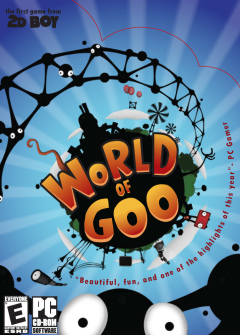 As one of the forerunners of the modern indie game movement (along with Braid), World of Goo demands to be played. Created almost entirely by two individuals on a miniscule budget (2D Boy), it has since gone on to spawn several ports while receiving numerous accolades. I'm a bit late to this party, but its resumé speaks for itself. With incredibly high 90%+ aggregate scores, it has been universally praised as a near-flawless game. Greg has given it a similarly stellar 9/10. PC and Wii first claimed the game in October 2008, followed by OSX in November, Linux in early 2009 and iOS in 2010.
As one of the forerunners of the modern indie game movement (along with Braid), World of Goo demands to be played. Created almost entirely by two individuals on a miniscule budget (2D Boy), it has since gone on to spawn several ports while receiving numerous accolades. I'm a bit late to this party, but its resumé speaks for itself. With incredibly high 90%+ aggregate scores, it has been universally praised as a near-flawless game. Greg has given it a similarly stellar 9/10. PC and Wii first claimed the game in October 2008, followed by OSX in November, Linux in early 2009 and iOS in 2010.
All that's left to do is try it out for myself, two-plus years after the fact. Could my personal thoughts and feelings for the game live up to its lofty accolades?
Read moreMay 6, 2011 by Greg Noe
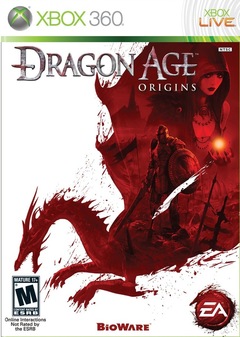 I don't like to give up on a game I'm invested in. I'm fine with quitting after an hour, and maybe even a few hours after that I can safely move on without second thought. But when the clock strikes double digit hours, I'm in for the long haul, or I have to make the usually difficult decision to stop for my own sanity. Back in January 2010, I made the bizarre decision to start playing Dragon Age: Origins immediately after I finished Knights of the Old Republic and just three weeks before Mass Effect 2 was released. Suffice it to say, I didn't get very far, and the call of Commander Shepard was too strong.
I don't like to give up on a game I'm invested in. I'm fine with quitting after an hour, and maybe even a few hours after that I can safely move on without second thought. But when the clock strikes double digit hours, I'm in for the long haul, or I have to make the usually difficult decision to stop for my own sanity. Back in January 2010, I made the bizarre decision to start playing Dragon Age: Origins immediately after I finished Knights of the Old Republic and just three weeks before Mass Effect 2 was released. Suffice it to say, I didn't get very far, and the call of Commander Shepard was too strong.
Almost exactly a year later, I finally returned to Ferelden to finish job. I booted up my old mage and rediscovered the hilarity of my party members and utter deepness of the gameplay. I'll admit right here and now, the first thing I did was crank the difficulty down to Casual. I wasn't playing again to make some sort of statement to nobody that I was any good at this type of game, I just wanted to experience everything Dragon Age: Origins had to offer... in terms of story and world building.
I was actually pretty hyped for Dragon Age before it was released, I read the first book, The Stolen Throne, and Grant and I checked out the web-based spinoff, Dragon Age Journeys. My first hour review of the game went decently well, but the origin story of the Dalish Elf was kind of dull which encouraged me to try another origin when I was ready to play for real. And while it took way too long to finally beat the game, it was well worth the wait in the end.
Here's my review of Dragon Age: Origins on the Xbox 360. While I would normally write a many thousands of words on a BioWare game, I'm going to try and move at a bit swifter pace. If you're interested, Ian also reviewed this game a few months ago, this is strictly my opinion.
Read moreApril 18, 2011 by Steve
![]() Not often will games come along and surprise you these days. In our age of information, developers and publishers go to great lengths to push their products. Specifically, they hope to get fans hyped enough to buy the game day 1 as well as keeping the title in the public mind for continued spontaneous purchases of their product. This is why we're rarely surprised and blown away by a game. For me, VVVVVV was that type of game.
Not often will games come along and surprise you these days. In our age of information, developers and publishers go to great lengths to push their products. Specifically, they hope to get fans hyped enough to buy the game day 1 as well as keeping the title in the public mind for continued spontaneous purchases of their product. This is why we're rarely surprised and blown away by a game. For me, VVVVVV was that type of game.
April 8, 2011 by Greg Noe
 I love genre mashing, and Monster Tale is certainly a special case of mixed, but excellent heredity. We have the popular and super combination of Metroid and Castlevania, plus monster training that mixes Pokemon, Tamagotchi, and E.V.O.: Search for Eden. Excellent genes also bears the burden of high expectations, however, can Monster Tale possibly meet them?
I love genre mashing, and Monster Tale is certainly a special case of mixed, but excellent heredity. We have the popular and super combination of Metroid and Castlevania, plus monster training that mixes Pokemon, Tamagotchi, and E.V.O.: Search for Eden. Excellent genes also bears the burden of high expectations, however, can Monster Tale possibly meet them?
Released on the Nintendo DS late last month, Monster Tale was developed by DreamRift and published by Majesco. It pairs up a young girl and her monster that evolves and grows throughout the game. Trapped in a world ran by children who think themselves royalty, our young heroine is a bit like Dorothy in Oz, just with Chomp for companionship.
I originally meant to write at least a half-hour handheld review of Monster Tale, but I kept playing and before I knew it, the game was over. Here is my review of Monster Tale for the Nintendo DS.
Read moreApril 4, 2011 by Greg Noe
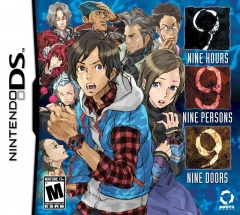 For the last few years, I’ve been attempting to answer the question “would I keep playing?” after finishing the first hour of a video game. It is kind of a loaded question, as I’m trying to answer for just myself, but also consider the millions of readers out there who might be wondering the same thing. I enjoy genres many people don’t, and I also have wildly varying opinions on a lot of games, so if I’m on the fence, I’ll generally give the game in question the thumbs up. In the end, the wording is important: I would keep playing if I had the time and energy to do so, but chances are I’m still chugging through Dragon Age: Origins.
For the last few years, I’ve been attempting to answer the question “would I keep playing?” after finishing the first hour of a video game. It is kind of a loaded question, as I’m trying to answer for just myself, but also consider the millions of readers out there who might be wondering the same thing. I enjoy genres many people don’t, and I also have wildly varying opinions on a lot of games, so if I’m on the fence, I’ll generally give the game in question the thumbs up. In the end, the wording is important: I would keep playing if I had the time and energy to do so, but chances are I’m still chugging through Dragon Age: Origins.
After a half-hour with the Nintendo DS game 999: Nine Hours, Nine Persons, Nine Doors, I was emphatically done (we sometimes give portable games just the 30 minute treatment with the assumption that being a portable game, they might get things rolling quicker). It was a bizarre experience, to say the least. But then its fans started to comment. Commenters arrive in many forms, sometimes they’re offended that I seemingly insulted their game as if it was their mother, but sometimes they come as defenders of justice. 999 fans appeared as the latter.
So I gave the game another shot, replayed the beginning and on from there. I beat 999 three times in total to achieve the true ending, and in the end, I enjoyed my experience. My final score for the game was hard to pin down, so pay more attention to the text than the number.
Read moreMarch 23, 2011 by Greg Noe
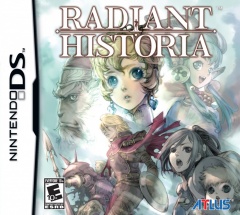 A year ago I vented how Persona 3 and Odin Sphere had destroyed my love for Japanese RPGs, one of my favorite video game genres growing up. I might have been a bit dramatic about the situation, but the two games left such bad tastes in my mouth I had to take a break from the genre. This lasted about six months before I ventured back into the land of turn-based rising sun with Sega’s Infinite Space, a game that has all the trappings of crappy JRPGs but turned out to be pretty great in the end.
A year ago I vented how Persona 3 and Odin Sphere had destroyed my love for Japanese RPGs, one of my favorite video game genres growing up. I might have been a bit dramatic about the situation, but the two games left such bad tastes in my mouth I had to take a break from the genre. This lasted about six months before I ventured back into the land of turn-based rising sun with Sega’s Infinite Space, a game that has all the trappings of crappy JRPGs but turned out to be pretty great in the end.
Since then I’ve beaten Golden Sun 3: Dark Dawn, Black Sigil: Blade of the Exiled, and Radiant Historia. It’s been a mixed bag and a reminder that I’m not back in love with the genre, but one game in particular pretty much brought me back into the fold: Atlus’ newest Nintendo DS title, Radiant Historia.
Released in February, Radiant Historia chewed up more portable gaming time than anything I’ve played in recent memory. The idea that a 50 hour game should be imposing to someone with limited gaming time like myself didn’t matter, I plowed through it and the game was worth every minute. Here’s my review of Radiant Historia.
Read moreMarch 14, 2011 by Nate
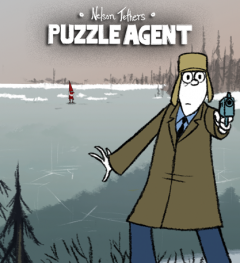 Nintendo has made a killing packaging classic pen-and-paper activities into DS games. Picross, Sudoku, Crosswords...but one of the major successes is the Professor Layton series. Developed by Level 5 and published by Nintendo outside of Japan, the franchise tasks players with solving puzzles and riddles in order to explore a storyline brimming with mystery. The puzzling travels of Professor Layton and his apprentice Luke are a hit with casuals and hardcore alike, selling over ten million units worldwide between the series' five titles.
Nintendo has made a killing packaging classic pen-and-paper activities into DS games. Picross, Sudoku, Crosswords...but one of the major successes is the Professor Layton series. Developed by Level 5 and published by Nintendo outside of Japan, the franchise tasks players with solving puzzles and riddles in order to explore a storyline brimming with mystery. The puzzling travels of Professor Layton and his apprentice Luke are a hit with casuals and hardcore alike, selling over ten million units worldwide between the series' five titles.
Of the three titles available outside Japan, I've only played the first, Curious Village. It's certainly full of cranium-crunching riddles, but I wasn't as taken by the rest of the package as many were. Decent production values aside, there wasn't much that impressed me from the strange story of Layton, Luke, and the peculiar villagers. I'd almost wished the game was a more sterile package, like so many other brainy DS productions. Most would probably disagree, seeing the worth in framing these teasers within a narrative.
Enter Nelson Tethers: Puzzle Agent. I bought this budget PC title in -- what else? -- a Steam bundle during the holiday season. Nelson clearly took notes from one of the Professor's lectures, because Puzzle Agent's premise is very similar to Curious Village, having the player explore a mysterious little town by solving riddles for its puzzle-obsessed populace. But unlike Curious Village, I actually enjoyed the overall experience even more than the puzzles that pervade it.
February 28, 2011 by Greg Noe
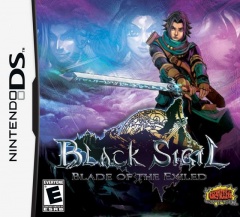 During the Super Nintendo era, Squaresoft was peaking with Secret of Mana, Final Fantasy VI, and Chrono Trigger. The developer defined the Japanese RPG genre with those titles and also completely owned the marketplace for years to come. It’s easily arguable that Square has since lost the JRPG title to other developers such as Atlus (with its recent bit of awesomeness titled Radiant Historia in particular), but they’ll never have their triumphant 16-bit period taken away from them.
During the Super Nintendo era, Squaresoft was peaking with Secret of Mana, Final Fantasy VI, and Chrono Trigger. The developer defined the Japanese RPG genre with those titles and also completely owned the marketplace for years to come. It’s easily arguable that Square has since lost the JRPG title to other developers such as Atlus (with its recent bit of awesomeness titled Radiant Historia in particular), but they’ll never have their triumphant 16-bit period taken away from them.
Black Sigil: Blade of the Exiled is a love letter to that era. With sprites and animations seemingly ripped straight out of Chrono Trigger and Final Fantasy VI, and a story that sounds by-the-formula familiar to fans of the genre, this 2009 Nintendo DS release appears to be just another Japanese RPG title. But surprisingly, Black Sigil was developed in Montreal, so yes, this is one of those rare Canadian Japanese RPGs.
Developed by Studio Archcraft and published by Graffiti Entertainment, Black Sigil is also a bit of an indie title. The credits listed the same eight names over and over while the title was so long in development that it was originally targeted for the Game Boy Advance.
Unfortunately, the team had their goals so loftily set that I believe they lost sight of what made Squaresoft’s games so great: they were fun. Black Sigil is plagued by some major issues that most people will find the game unplayable beyond a few hours. I stuck it out though, and here’s my review.
Read moreFebruary 25, 2011 by Nate
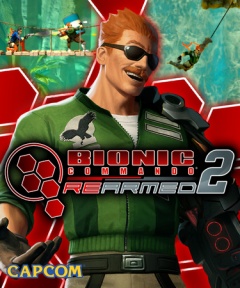 One of my favorite activities in college was brainstorming ideas with my roommates. When bored, we would gather in the living room, get out the whiteboard, and come up with some imaginative business idea or a get-rich-quick scheme or an outline of a blockbuster screenplay. The ambitiousness of our outlandish dreams was matched only by our enthusiasm to start making them a reality.
One of my favorite activities in college was brainstorming ideas with my roommates. When bored, we would gather in the living room, get out the whiteboard, and come up with some imaginative business idea or a get-rich-quick scheme or an outline of a blockbuster screenplay. The ambitiousness of our outlandish dreams was matched only by our enthusiasm to start making them a reality.
Then, after disagreeing for a few hours about what the title should be for our Atlantis-set romantic comedy, we'd give up and play Smash Bros. For the record, though, I still think "Mermaid for Each Other" is just brilliant.
I get the feeling that Fatshark, the small Swedish developer given the reigns to Bionic Commando after its previous steward was dissolved, had similarly lofty goals and equally tragic work ethic for the series' first 2-D sequel. The result is Bionic Commando Rearmed 2, a sequel that I suspect was conceived with a drive to do it big but produced with a reluctance to do it at all.
Read moreFebruary 14, 2011 by Nate
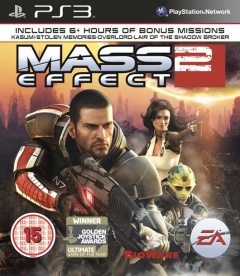 Some games are just so damn popular and beloved that you can't ignore them, no matter how hard you try.
Some games are just so damn popular and beloved that you can't ignore them, no matter how hard you try.
When Mass Effect invaded my world in 2007, I couldn't have cared less. Sure, it was from the same BioWare that produced the excellent Knights of the Old Republic, and seducing blue women sounded like a pretty good time, but it definitely wasn't enough to put a 360 in my life. I'd grown weary of shooters of all kinds since burning out on Halo 2, and with RPG elements mashed in, it only seemed less enticing. I even gave the game a try last year on a friend's machine and didn't make it off the Citadel before losing interest.
The hype hasn't fallen on deaf ears, though. The rave reviews, rave first hour reviews, GOTY awards, and FOX News scare tactic hilarity all kept me up at night, wondering if I was missing out. EA was intent on making me give the series another shot, as they recently completed a PS3 port of Mass Effect 2. Because one of the series' bullet points is importing player-dictated narrative choices from the first game into the second, Dark Horse Comics was called in to help create a short interactive comic that fills in PS3 owners on some of the events that they missed out on from Commander Shepard's first adventure, even allowing the player to make some of the more important decisions to impact their experience with the full sequel.
As it turns out, that comic is DLC, unlockable either by a code included in the game's box or for $15. I rented the game and didn't plan on shelling out fifteen bucks for a fifteen minute comic, so I ended up going into the sequel without much knowledge from the first game. From that starting point aboard the exploding Normandy to the final trip through the Omega 4 relay, I've experienced just about everything included on the PS3 disc of Mass Effect 2 -- as much as you can in one playthrough, anyway -- as Elmer Shepard, a Vanguard of equal parts paragon and renegade, lover and fighter, savior and failure. And sometimes he forgets to feed his fish, and they die.
Greg has already written about the Mass Effect series extensively, having played both games and plenty of extra content on the 360. With that in mind, I'll try (but likely fail) to keep this brief. If you need a primer or refresher for the series, check out one of his excellent writeups. An avid fan of the series, he does a much better job of explaining the core elements of Mass Effect than I could.
February 9, 2011 by Greg Noe
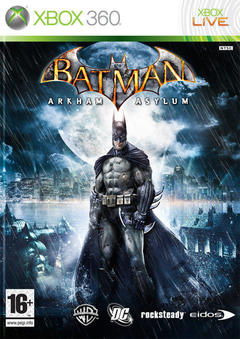 A year ago I played the first hour of Batman: Arkham Asylum. The conclusion was that I would keep playing “for a while,” and much of that decision rested on what percentage of the game would the stealth gameplay take up. I had to give the game back to who I was borrowing it from, however, and Arkham Asylum started burning a hole in my brain. I began to really want to play it again, but the opportunity never came up the rest of the year. When Christmas rolled around I said I wanted one game, and one game only: Batman.
A year ago I played the first hour of Batman: Arkham Asylum. The conclusion was that I would keep playing “for a while,” and much of that decision rested on what percentage of the game would the stealth gameplay take up. I had to give the game back to who I was borrowing it from, however, and Arkham Asylum started burning a hole in my brain. I began to really want to play it again, but the opportunity never came up the rest of the year. When Christmas rolled around I said I wanted one game, and one game only: Batman.
I received the game but forced myself to beat Fable II before I moved on to something bigger and better (if I play more than one game at a time I’m bound to never play one of them again). The moment after I saved Albion again I switched over to Arkham Asylum and went to town.
Released in mid-2009, Arkham Asylum seemed to spring out of nowhere from absolute nobody Rocksteady Studios. Why and how these guys received the criminally under performing Batman license and then went out and made one of the best games of the year is a bit mind boggling, but a story for another day.
Here’s my full review of Batman: Arkham Asylum.
Read moreFebruary 2, 2011 by Greg Noe
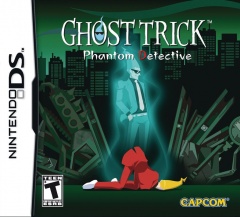 I've been anticipating Ghost Trick: Phantom Detective for a while now. As a big fan (but totally burned out) of the Ace Attorney series, I was excited for Phoenix Wright's creator's next vision. It's an odd one, that's for sure, but holds on to the humor, great cast of characters, and overwhelming charm that made the Ace Attorney series so great.
I've been anticipating Ghost Trick: Phantom Detective for a while now. As a big fan (but totally burned out) of the Ace Attorney series, I was excited for Phoenix Wright's creator's next vision. It's an odd one, that's for sure, but holds on to the humor, great cast of characters, and overwhelming charm that made the Ace Attorney series so great.
In Ghost Trick, you unsurprisingly play as a ghost. The idea is you can manipulate objects from the ghostly dimension to save people's lives and ultimately, find out who you are and why you were killed. The Phoenix Wright-like mystery is present throughout the game and many of the questions aren't answered until the last action is taken, but it's a fun and original ride all the way there.
Phantom Detective shouldn't be a game that can be explained easily, but its first half-hour managed to do a pretty bang-up job. Check that out for an early walkthrough of all the concepts and in-depth gameplay elements the game explains to you quickly and efficiently.
Read moreFebruary 1, 2011 by Jonathan Ramundi
 The Nintendo DS is easily the go-to console this generation when it comes to RPGs. As a developer, you'd be hard-pressed to have your title stand out in a library already rife with role-playing goodness. There are exceptions however, and Camelot's Golden Sun franchise is certainly one of them. The series' notoriety on the Game Boy Advance was enough to perk people's ears when Golden Sun: Dark Dawn was first announced. The sequel comes to us 7 years after the The Lost Age, with 30 years having passed in the game's universe. The original GBA games were hits. Does the sequel live up to the legacy they left behind?
The Nintendo DS is easily the go-to console this generation when it comes to RPGs. As a developer, you'd be hard-pressed to have your title stand out in a library already rife with role-playing goodness. There are exceptions however, and Camelot's Golden Sun franchise is certainly one of them. The series' notoriety on the Game Boy Advance was enough to perk people's ears when Golden Sun: Dark Dawn was first announced. The sequel comes to us 7 years after the The Lost Age, with 30 years having passed in the game's universe. The original GBA games were hits. Does the sequel live up to the legacy they left behind?
If you take a glance at the beginning of my First Hour review, you'll see that I've listed what, I feel, makes a damn good Golden Sun game. I thought I'd keep this review simple and basically go through each of the points I already made and comment on what's changed and whats been added or subtracted from the core experience.
Read moreJanuary 31, 2011 by Ian M. Bagley
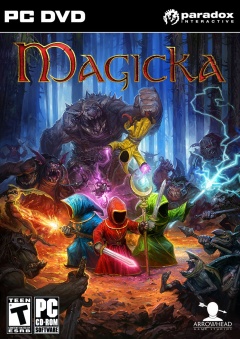 Indie games. I love indie games. Many are free, and those that aren't are usually still cheap enough to buy virtually regardless of your budget. Another reason I am a fan of the Indie market is that they're very good at listening to their fans. A great example is Mount and Blade: Warband. After the first game was introduced, fans wailed and screamed for multiplayer, and you know what? They got it. Mount and Blade: Warband features multiplayer that many people find sufficient, and if not, you can modify the game to hit your sweet spot.
Indie games. I love indie games. Many are free, and those that aren't are usually still cheap enough to buy virtually regardless of your budget. Another reason I am a fan of the Indie market is that they're very good at listening to their fans. A great example is Mount and Blade: Warband. After the first game was introduced, fans wailed and screamed for multiplayer, and you know what? They got it. Mount and Blade: Warband features multiplayer that many people find sufficient, and if not, you can modify the game to hit your sweet spot.
But that isn't what I love most about indie games. No, no, no...I much prefer the fact that indie developers have much less to lose, so much more to gain and that means they push the envelope. Hell, they don't push it, they light the sucker on fire and piss on the ashes, developers Arrowhead Game Studios and publishers Paradox Interactive that is.
The game I'm talking about today is a fantastic example of a developer unleashed, and how fantastic it can truly be to see true geniuses able to work they way they want to. That result is Magicka, an action game based on Magic and its elements.
Read moreJanuary 25, 2011 by Ian M. Bagley
 I enjoy medieval RPGs. I mean, the majority of games I play - fantasy or not - are based in that setting. There's just something about slicing my enemies up with swords that's just completely satisfying. So when I got to play a few minutes of Mount and Blade: Warband, I knew I'd desperately want more.
I enjoy medieval RPGs. I mean, the majority of games I play - fantasy or not - are based in that setting. There's just something about slicing my enemies up with swords that's just completely satisfying. So when I got to play a few minutes of Mount and Blade: Warband, I knew I'd desperately want more.
What? You haven't heard of this masterpiece from Taleworlds? That's okay, there wasn't a whole lot of advertising, and the original Mount and Blade was made by a married couple virtually by themselves. It's not exactly common that things like this happen.
I played the original briefly, and it was fun, but the overhauled Warband made vast improvements over its predecessor.
So, what is it? Well, it's massive and somewhat complicated, but I shall attempt to explain. Mount and Blade: Warband is a medieval role-playing game that puts you into the world of Calradia, a land filled with several kingdoms, all wanting to unify the land under their rule.
Read moreJanuary 21, 2011 by Greg Noe
 The Golden Sun series and I go back to 2001 when the original Golden Sun was released. I played through the game slowly, and forced myself to finish it when Golden Sun: The Lost Age was on the cusp of its release. This was one of those rare titles that let you import data from its prequel via a very (very) long code. This code contained all your party’s information, ready to continue on in their next adventure.
The Golden Sun series and I go back to 2001 when the original Golden Sun was released. I played through the game slowly, and forced myself to finish it when Golden Sun: The Lost Age was on the cusp of its release. This was one of those rare titles that let you import data from its prequel via a very (very) long code. This code contained all your party’s information, ready to continue on in their next adventure.
I spent more time inputting that code than actually playing The Lost Age, and that was that, I forgot about Golden Sun from 2003 until 2010 when Nintendo announced Golden Sun: Dark Dawn at E3. Since my progress had stalled for months on Dragon Quest IX and I was finished with Infinite Space, I decided to pick it up when the game was released in late November.
The reviews have been pretty solid for Dark Dawn and I’m sure sales are swift (almost every Nintendo published title is successful), but how would my return to Weyard fare? It’s been seven long years and my interest in the series is minimal. Here’s my full review of Golden Sun: Dark Dawn for the Nintendo DS.
For those interested, we also have a first hour review of Dark Dawn written by a huge Golden Sun fan, Jonathan Ramundi.
Read moreJanuary 18, 2011 by Greg Noe
 This was not a great way to kick off 2011, Fable II is a below average action RPG that exhibits all the same qualities of nearly every other Peter Molyneux game: far too much ambition in a totally lackluster package.
This was not a great way to kick off 2011, Fable II is a below average action RPG that exhibits all the same qualities of nearly every other Peter Molyneux game: far too much ambition in a totally lackluster package.
Fable II was released in October of 2008 to much hype, praise, and handfuls of cash. I'm apparently in the critic minority by not enjoying Fable II as it has a Metacritic rating of 89 and received Game of the Year award honors from outlets X-Play and Joystiq in a year that featured Fallout 3, Grand Theft Auto IV, and Metal Gear Solid 4 (if my respect for G4 could have gone any lower, it just has). But that is their opinion, and this is mine.
I'm going to try and keep my full reviews a bit shorter this year, I spent an extraordinary amount of time writing them in 2010 (what with there being about 30 of them and all), and I would like to focus my efforts back to the first hour reviews where it belongs. Speaking of first hour reviews, here's Fable II's.
Read moreJanuary 14, 2011 by Jonathan Ramundi
 In case you hadn't noticed, in the last couple of years, the Nintendo Wii has been subject to the revival of a number of key franchises in the company's portfolio; franchises that have either strayed far from their humble beginnings or simply haven't been seen in many years, if not both. The beloved Donkey Kong franchise is the latest to follow this trend—in the footsteps of New Super Mario Bros. Wii, Kirby's Epic Yarn, and even, to some extent, Metroid: Other M—with its newest incarnation, Donkey Kong Country Returns. Interestingly, the game's developer, Retro Studios, is the same company responsible for the reimagination of another classic Nintendo franchise, in the form of the Metroid Prime saga. However, this time—as mentioned—the company was tasked with bringing a series back to its roots, rather than taking it (quite literally) to another dimension. It's been 13 years since we've seen the Kong family in 2D platforming fashion. In fact, the game's titular character hasn't been played in this form since Donkey Kong Land for the Gameboy back in 1995. Well, as the name suggests, he makes a return in DKCR. And what a triumphant return it is.
In case you hadn't noticed, in the last couple of years, the Nintendo Wii has been subject to the revival of a number of key franchises in the company's portfolio; franchises that have either strayed far from their humble beginnings or simply haven't been seen in many years, if not both. The beloved Donkey Kong franchise is the latest to follow this trend—in the footsteps of New Super Mario Bros. Wii, Kirby's Epic Yarn, and even, to some extent, Metroid: Other M—with its newest incarnation, Donkey Kong Country Returns. Interestingly, the game's developer, Retro Studios, is the same company responsible for the reimagination of another classic Nintendo franchise, in the form of the Metroid Prime saga. However, this time—as mentioned—the company was tasked with bringing a series back to its roots, rather than taking it (quite literally) to another dimension. It's been 13 years since we've seen the Kong family in 2D platforming fashion. In fact, the game's titular character hasn't been played in this form since Donkey Kong Land for the Gameboy back in 1995. Well, as the name suggests, he makes a return in DKCR. And what a triumphant return it is.
I previously wrote a first hour review of the game, and now, after spending much more time with it (and considering Retro's history with Metroid), I'm of the opinion that Retro should be given full responsibility over all major Nintendo IPs henceforth. This game is—and I'm trying really hard not to oversell it—perfect. Okay, well, maybe not perfect, but about as close as you can get. I kind of had trouble writing a review because of this. I didn't know exactly how to convey the sheer brilliance of this game, but, at the same time, I know words can only go so far. Only after playing will you understand why everyone's going ape over this—and hopefully, if nothing else, this review will get you to do so.
Read moreJanuary 12, 2011 by Nate
 "Some of this game is fun...is that enough for me to keep playing?"
"Some of this game is fun...is that enough for me to keep playing?"
Ever had that feeling? Maybe you trudged through an RPG with a terrible battle system just because you liked a few of the characters. Perhaps you put up with a broken sports game just because the presentation was TV-true. Or maybe you played any of the open-world Spider-Man games recently, swinging joyously through the boxy Manhattan skyline, full of texture pop-in and framerate dips.
Final Fantasy Crystal Chronicles: The Crystal Bearers is kind of like that. Except where the fun elements of these previous examples are woven into the overall progression of the game, FFCCTCB never actually shines the spotlight on its best feature throughout the otherwise lackluster adventure, leaving it merely as a side attraction.
I was hoping the game would improve after its first hour, and it did...but was it too little, too late?
Read moreDecember 27, 2010 by Greg Noe
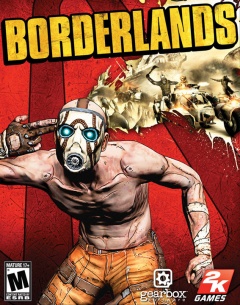 In my December blitz of full reviews, this is my last one of the year. I'm not going to say I saved the best for last, because that falls to either Super Mario Galaxy 2 or Mass Effect 2 at this point, but Borderlands is certainly way up there. Like Mirror's Edge, Borderlands paves its own genre and does it beautifully. The mash-up of first person shooter and RPG with a zillion guns tacked on for extra destruction gels perfectly. The classes feel distinctly different, four player online co-op just works super well, and the game features over 30 hours of content on just your first playthrough (and you will play more than once).
In my December blitz of full reviews, this is my last one of the year. I'm not going to say I saved the best for last, because that falls to either Super Mario Galaxy 2 or Mass Effect 2 at this point, but Borderlands is certainly way up there. Like Mirror's Edge, Borderlands paves its own genre and does it beautifully. The mash-up of first person shooter and RPG with a zillion guns tacked on for extra destruction gels perfectly. The classes feel distinctly different, four player online co-op just works super well, and the game features over 30 hours of content on just your first playthrough (and you will play more than once).
Borderlands was released in October of 2009, so it's been out a while and is very cheap if you want to get into it now. The team is currently developing Duke Nukem Forever so there's no fear of Borderlands 2 coming out for at least a year and a half, I would think. I plan to continue writing about Borderlands well into next year as I still have three sets of downloadable content to review after just covering the first one, The Zombie Island of Dr. Ned. But as the end of the year is imminent, I really feel like I need to get my thoughts on the main game out on the table.
Mike has gone into great detail already on what makes Borderlands so great, and after re-reading his review, I honestly don't have a lot to add. This is one of my favorite games of the year and I'll detail why I personally liked it so much below, but if you're looking for an in depth review I would recommend you check out Mike's.
Read moreDecember 22, 2010 by Greg Noe
 Think about your favorite part of any platformer game, it probably has something to do with excellent level designed coupled with you being in the zone and cruising through the stage on a perfect run. Like in Super Mario Bros. 3 where you bounce from goomba to goomba and take off in flight as Raccoon Mario.
Think about your favorite part of any platformer game, it probably has something to do with excellent level designed coupled with you being in the zone and cruising through the stage on a perfect run. Like in Super Mario Bros. 3 where you bounce from goomba to goomba and take off in flight as Raccoon Mario.
Now think about the worst part in any platformer, for me, it's when a platformer stops being a platformer and tries its hand at something... less than adequate. This might mean boss fights that require more luck than skill or high action sequences that seem better at home in a much different genre.
Mirror's Edge is a prime example of a game where excellent platforming level design collides with obnoxiously out of place non-platforming. Thankfully, the highs outweigh the lows in this ambitious first person platformer. The game was released on the Xbox 360, PlayStation 3, and Windows in 2008 and was planned to be the first game in planned trilogy. Sales apparently weren't good enough for Electronic Arts and no word of a sequel has been announced. Though in classic industry PR, they "haven't not not" announced Mirror's Edge 2.
This is the First Hour's second opinion on Mirror's Edge along with my conclusion after playing its first hour earlier this month. Here's my full review of Mirror's Edge.
Read moreDecember 20, 2010 by Greg Noe
 I don't think I've been this disappointed in a video game since Assassin's Creed. Zack and Wiki started off great, but then some realizations start to sink in, and then everything falls off the track. To say I didn't have fun with Zack and Wiki would be a lie, but there are some major problemms with this game.
I don't think I've been this disappointed in a video game since Assassin's Creed. Zack and Wiki started off great, but then some realizations start to sink in, and then everything falls off the track. To say I didn't have fun with Zack and Wiki would be a lie, but there are some major problemms with this game.
Before we get into the review proper, Zack and Wiki: Quest for Barbaros' Treasure was released in 2007 by Capcom. I admitted in my first hour review of the game that this was the first non-Nintendo published title I was actually interested in playing. Super Mario Galaxy 1 and 2 are incredible, but I was having a lot of trouble finding something that interested me on the Wii beyond those. Zack and Wiki had been nagging at me for a while and received great reviews, seemed like it was the right way to go.
I understand that my opinion probably differs quite a bit from the normal reviewer, it makes me question whether they actually played the entire game or if expectations of Wii gameplay has really changed this much over three years? But if I wasn't honest in my review, what's the point in writing?
Read moreDecember 16, 2010 by Greg Noe
 I've been on a puzzle kick lately. I attribute that to playing the 60 hour epic Infinite Space and having to take just as many hours coming down from that high. What I love about the Nintendo DS is its instant on/off and games like Harvest Moon: Frantic Farming or Picross 3D are perfect for jumping in and out quickly. Next up on my list of puzzlers to try was Mario vs. Donkey Kong: Mini-Land Mayhem!, the fourth game in the Mario vs. Donkey Kong series that began on the Game Boy Advance.
I've been on a puzzle kick lately. I attribute that to playing the 60 hour epic Infinite Space and having to take just as many hours coming down from that high. What I love about the Nintendo DS is its instant on/off and games like Harvest Moon: Frantic Farming or Picross 3D are perfect for jumping in and out quickly. Next up on my list of puzzlers to try was Mario vs. Donkey Kong: Mini-Land Mayhem!, the fourth game in the Mario vs. Donkey Kong series that began on the Game Boy Advance.
I actually thought that this was the second Mario vs. Donkey Kong game, believing that the DSiWare game, Minis March Again, was the first. Surprise surprise, there were two previous: Mario vs. Donkey Kong on the GBA and March of the Minis on the DS. I think I missed out on all these due to me not reading Nintendo Power for a few years, how else do you hear about these curious yet under-the-radar kind of games?
Mini-Land Mayhem pits, just like the name says, Mario against Donkey Kong in an epic struggle to rescue Pauline, Mario's original crush. Mario doesn't feel like getting his hands dirty though (being a plumber and all), so he sends a bunch of robot mini Marios to do his bidding. But they're dumb, like Lemmings, and simply walk in a straight line until they hit something and then turn around. They'll climb the first ladder they run into or trod up stairs, but that's about it.
Can Nintendo really publish four titles with this basic premise in the span of just six years? (haha, of course they can, they're Nintendo) Here's my full review of my first experience with the Mario vs. Donkey Kong series in Mini-Land Mayhem.
Read moreDecember 14, 2010 by Greg Noe
 Once a series becomes too large for its own good, spin-offs and genre breaking games are inevitable. The success of these tangents rests on many factors, including the potential new genre and charisma of side characters now carrying their own game (Wario did this particularly well). When someone thinks Harvest Moon, their mind is probably drawn to the obvious farming or dating aspects. The pace of the games are slow and require hours upon hours of playing for the player to feel immersed in their new agriculture world. When the series is focused on this, the games can be very good. They even managed to spin off the Rune Factory series successfully after injecting some action RPG elements into the somewhat stale formula.
Once a series becomes too large for its own good, spin-offs and genre breaking games are inevitable. The success of these tangents rests on many factors, including the potential new genre and charisma of side characters now carrying their own game (Wario did this particularly well). When someone thinks Harvest Moon, their mind is probably drawn to the obvious farming or dating aspects. The pace of the games are slow and require hours upon hours of playing for the player to feel immersed in their new agriculture world. When the series is focused on this, the games can be very good. They even managed to spin off the Rune Factory series successfully after injecting some action RPG elements into the somewhat stale formula.
What you can't imagine them spinning off though is a fast-paced puzzle game set in the Harvest Moon world, but they've tried twice already. Natsume's first attempt was Puzzle de Harvest Moon in 2007, a game I played for about 20 minutes before getting bored. The game was received poorly, I guess there just aren't a lot of gamers begging for a mediocre puzzle game based on crops.
Well, they tried again in 2009, this time with Harvest Moon: Frantic Farming. From what I can tell, it seems to be almost the exact same puzzle game as we played a few years prior, but this time wrapped in a text heavy story featuring the brain dead characters of Sunshine Islands. Yay... Here's my full review of Harvest Moon: Frantic Farming on the Nintendo DS.
Read moreDecember 9, 2010 by Greg Noe
 Few games on the iOS platform get me excited. There's just such a surplus of bad that even when you hear about Super Popular Game X, you wonder if the masses are just falling for more of the same. When Plants vs. Zombies was announced early this year as a port of the PC/Mac release, I didn't think twice about picking it up. The $3 price tag didn't even make me think twice.
Few games on the iOS platform get me excited. There's just such a surplus of bad that even when you hear about Super Popular Game X, you wonder if the masses are just falling for more of the same. When Plants vs. Zombies was announced early this year as a port of the PC/Mac release, I didn't think twice about picking it up. The $3 price tag didn't even make me think twice.
I had watched my brother in law play the full version on his Mac last year, and was intrigued by its porch defense gameplay. I had never even played a tower defense game before Plants vs. Zombies. A genre virgin so to speak. It was easy to see without even playing it why the game was so popular. The zombies would walk slowly from right to left and it's your job to fend them off with some bizarre garden variety plants.
This review will just be on the iOS version (played on a second generation iPod Touch). I have no experience with any other version (though I'm secretly planning to replay it on the Nintendo DS).
Read moreDecember 6, 2010 by Steve
 Alan Wake has been a long time coming. After Max Payne 2 released in 2003, Remedy has used the majority of their resources for this game. Originally announced in 2005, it has naturally undergone significant revisions. Once a freeroaming affair, Alan Wake is now almost entirely linear. Instead of releasing on consoles and PC, Remedy ended up partnering with Microsoft for an exclusive 360 release. As one would expect from a partnership, the game got bigger and bigger and eventually ended up being a high-profile, big-budget release when it finally hit in May 2010. Such a big game for a small company would carry with it many risks and increasingly impatient onlookers. Is the survival-horror tale worth the wait in the end? Is the Alan Wake concept still relevant and contemporary enough several years later? Most importantly, is the game good and does it work? Let's take a dive into the darkness...
Alan Wake has been a long time coming. After Max Payne 2 released in 2003, Remedy has used the majority of their resources for this game. Originally announced in 2005, it has naturally undergone significant revisions. Once a freeroaming affair, Alan Wake is now almost entirely linear. Instead of releasing on consoles and PC, Remedy ended up partnering with Microsoft for an exclusive 360 release. As one would expect from a partnership, the game got bigger and bigger and eventually ended up being a high-profile, big-budget release when it finally hit in May 2010. Such a big game for a small company would carry with it many risks and increasingly impatient onlookers. Is the survival-horror tale worth the wait in the end? Is the Alan Wake concept still relevant and contemporary enough several years later? Most importantly, is the game good and does it work? Let's take a dive into the darkness...
November 29, 2010 by Greg Noe
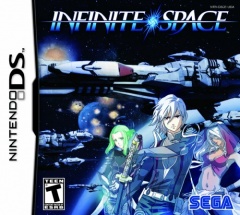 There is no reason I should have enjoyed Infinite Space.
There is no reason I should have enjoyed Infinite Space.
Infinite Space is a 60 hour Japanese RPG released on the Nintendo DS earlier this year. This is exactly the kind of game I didn’t want to play anymore, but somehow found myself drawn into. I played, and I played, and I played some more until the end credits ran. Then I closed my DS and smiled.
It’s hard to quickly describe Infinite Space. Yes, it’s an RPG in space, which means lots of dialogue and battles. And yes, it was developed by a Japanese studio, called Nude Maker nonetheless (and slightly more amazing, published by Sega, who seemingly haven’t had a successful game in ages). I’ve had a recent aversion to JRPGs (which I documented extensively in April), but looking back, Infinite Space isn’t very Japanesey. The character art is drawn in the distinctive manga style, and there are random battles, but that’s about it. The story is actually comprehensible, and while heavy on the politics at times, features many identifiable and memorable characters.
Infinite Space is also kind of the epitome of what the First Hour is all about. It's a super long game that got the thumbs up after an hour from Paul Eastwood. I took his advice and went all the way.
Read moreNovember 24, 2010 by Ian M. Bagley
 Since I built my new PC in October, I've been playing games that I had not had a chance to in quite some time. My brother in law had come into ownership of a few games I had really wanted to play, and while in the mess of mediocrity, one game stood out as a gem that ended up sucking my time away. That game was Dragon Age: Origins.
Since I built my new PC in October, I've been playing games that I had not had a chance to in quite some time. My brother in law had come into ownership of a few games I had really wanted to play, and while in the mess of mediocrity, one game stood out as a gem that ended up sucking my time away. That game was Dragon Age: Origins.
Let me begin this review by saying I am a big fan of Bioware fantasy RPGs. I loved Baldurs Gate, Icewind Dale, and Neverwinter Nights. I love the DND based RPGs. These types of games, these fantasy RPGs with choices are fantastic and end up taking hours away.
However, despite me loving these past titles, I never finished a single one. I always ended up failing to complete the main story line, so when I installed Dragon Age, I was worried I wouldn't finish it.
Dragon Age: Origins was released by Bioware, the makers of Mass Effect, on November 3rd, 2009. It was well received, and it was announced months ago that Dragon Age 2 would be released in March, 2011. It's the first time Bioware has made a fantasy RPG that does not include DND rules. Many people were upset at this, but honestly, the DND elements are still there. You can still intimidate or persuade folks, or randomly kill them in conversation, making for some hilarious conversations.
Read moreNovember 22, 2010 by Jonathan Ramundi
 Attendees of the 2010 Electronic Entertainment Expo were witness to many exciting announcements on June 15th during Nintendo’s press conference—one of them being the highly awaited return of Kirby to home consoles. This would mark Kirby’s first appearance on a home console since 2003’s Kirby Air Ride for the Gamecube, and his first platforming adventure since 2000’s Kirby 64: The Crystal Shards. It clearly had a lot to live up to. But alongside roaring applause, the announcement was met with many raised eyebrows regarding our pink hero’s return—for he had undergone a change the likes of which a Nintendo mascot hasn’t seen since Paper Mario. Kirby was made of yarn. Yes, yarn. And his new game, Kirby’s Epic Yarn, would see him battle across a world of felt and fabric against a new foe, and with a new friend. Nevertheless, everyone was excited and anxiously awaiting its release. So, did Nintendo weave the world a masterpiece (yes, I just said that)?
Attendees of the 2010 Electronic Entertainment Expo were witness to many exciting announcements on June 15th during Nintendo’s press conference—one of them being the highly awaited return of Kirby to home consoles. This would mark Kirby’s first appearance on a home console since 2003’s Kirby Air Ride for the Gamecube, and his first platforming adventure since 2000’s Kirby 64: The Crystal Shards. It clearly had a lot to live up to. But alongside roaring applause, the announcement was met with many raised eyebrows regarding our pink hero’s return—for he had undergone a change the likes of which a Nintendo mascot hasn’t seen since Paper Mario. Kirby was made of yarn. Yes, yarn. And his new game, Kirby’s Epic Yarn, would see him battle across a world of felt and fabric against a new foe, and with a new friend. Nevertheless, everyone was excited and anxiously awaiting its release. So, did Nintendo weave the world a masterpiece (yes, I just said that)?
Editor's Note: If you're interested to see how Kirby's Epic Yarn starts, check out Nate's first hour review of the game (and his overall conclusions at the end of the article).
Read moreNovember 18, 2010 by Steve
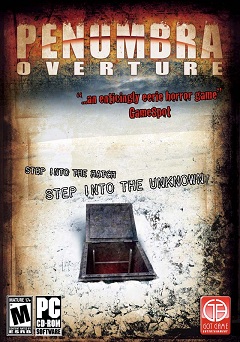 Atmosphere. Danger. Environment. Expectation. These words are integral to any sort of horror-based media, and yet many have seemingly forgotten all about the reasons behind fear and instead rely on cheap tactics to do the job. Penumbra: Overture shows a much more sophisticated ability to keep players on edge without relying on grotesque visuals and cheap 'jump moments' to elicit responses. I was particularly curious as to how this game could effect me since I'm not easily frightened and cheap attempts at fear usually seem more humorous than scary. And overall, the game does a fairly good job at its goals. Let me explain.
Atmosphere. Danger. Environment. Expectation. These words are integral to any sort of horror-based media, and yet many have seemingly forgotten all about the reasons behind fear and instead rely on cheap tactics to do the job. Penumbra: Overture shows a much more sophisticated ability to keep players on edge without relying on grotesque visuals and cheap 'jump moments' to elicit responses. I was particularly curious as to how this game could effect me since I'm not easily frightened and cheap attempts at fear usually seem more humorous than scary. And overall, the game does a fairly good job at its goals. Let me explain.
Overture almost takes advantage of those modern media shortcuts to create a fully engrossing experience with the capability to be legitimately frightening. As a response to these movies, shows, and games, your mind now expects something to happen when you travel down a dark hallway, into a new room, or when encountering an enemy. Instead, nothing typically happens in Penumbra. In fact, very little "happens" throughout the whole game. Almost all of the happenings and story events involve Phillip sorting out the past of his forgotten surroundings instead of building the story himself or primarily creating a story. At heart, Overture is a first-person adventure game, with the atmosphere as really the only major demarker to the survival-horror tag. I can recall only a handful of actual "events" Phillip was directly involved in. And yet this feels perfectly fine in the context of the game.
Read moreNovember 15, 2010 by Jonathan Ramundi
 The original Sin & Punishment was released in late 2000 for the N64. Due to developer Treasure's cancellation of its North American release, the game never made it outside of Japan until its rerelease for the Wii's Virtual Console seven years later. Its success, combined with the prospect of creating an all new experience utilizing the Wii's motion controls prompted the Treasure team to make a sequel; Sin & Punishment: Star Successor.
The original Sin & Punishment was released in late 2000 for the N64. Due to developer Treasure's cancellation of its North American release, the game never made it outside of Japan until its rerelease for the Wii's Virtual Console seven years later. Its success, combined with the prospect of creating an all new experience utilizing the Wii's motion controls prompted the Treasure team to make a sequel; Sin & Punishment: Star Successor.
Control in Star Successor is done via the Wii Remote and Nunchuck by default. Motion controls are implemented perfectly, allowing for smooth, precise targeting, though I found my wrist getting strained after long periods (there's a joke in there somewhere). You can also use the Classic Controller, GameCube Controller, or Wii Zapper, but I feel the standard setup works best.
Editor's Note: Sin & Punishment: Star Successor is Jonathan's second review here at The First Hour. This review was previously posted at IGN and Destructoid. Nate has previously written a first hour review of the game also.
Read moreNovember 10, 2010 by Jonathan Ramundi
 The gaming world first learned of Sonic the Hedgehog 4 back in September of 2009, under the code name “Project Needlemouse”. Sega declared a return to the franchise’s 2D roots, promising the Sonic game old-school fans have been anxiously awaiting for years. Well, there’s no doubt that if you spent the better part of your Saturday mornings as a child dashing through shuttle loops, this is definitely the Sonic game for you.
The gaming world first learned of Sonic the Hedgehog 4 back in September of 2009, under the code name “Project Needlemouse”. Sega declared a return to the franchise’s 2D roots, promising the Sonic game old-school fans have been anxiously awaiting for years. Well, there’s no doubt that if you spent the better part of your Saturday mornings as a child dashing through shuttle loops, this is definitely the Sonic game for you.
Sonic 4 picks up where the blue blur left off 16 years ago in Sonic & Knuckles, for the Sega Genesis. Dr. Eggman (or Robotnik, if you prefer) is up to his old tricks, and it’s up to none other than the fastest thing alive, Sonic the Hedgehog, to stop him; chasing the evil scientist through 4 zones (3 acts each, plus a boss battle) before a final showdown against the doctor’s ultimate creation...
Editor's Note: Jonathan is a brand new writer and contributer to The First Hour. Please welcome him! This review was originally posted at IGN.
Read moreNovember 1, 2010 by Greg Noe
 Remember that big game from late last year? The one with all the controversy where you shot civilians in an airport, defended America's cities against direct attack, and weren't allowed to run your own multiplayer dedicated server? Yeah, that one. Call of Duty: Modern Warfare 2. In my circle of gaming friends this game came and went. I beat it and pretty much put it away for good. Apparently it is still really popular though, and I like to keep track of every game I beat now, so I present my full review of Modern Warfare 2.
Remember that big game from late last year? The one with all the controversy where you shot civilians in an airport, defended America's cities against direct attack, and weren't allowed to run your own multiplayer dedicated server? Yeah, that one. Call of Duty: Modern Warfare 2. In my circle of gaming friends this game came and went. I beat it and pretty much put it away for good. Apparently it is still really popular though, and I like to keep track of every game I beat now, so I present my full review of Modern Warfare 2.
The game was released on the Xbox 360, PlayStation 3, and Windows, and is the direct sequel to Call of Duty: Modern Warfare, a game that features what I believe to be one of the best first hours I have ever played (so good, in fact, that I went on to beat the game in one sitting). The game as a whole was also very good, so I had high expectations for Modern Warfare 2. The first hour of it was impressive and pressed me to play on (but across multiple sittings this time), but in the end, it wasn't able to hold my attention as much as the original.
Here's my impression on the single player campaign, I did not play enough multiplayer to properly grade or judge it, in my opinion.
Read moreOctober 27, 2010 by Greg Noe
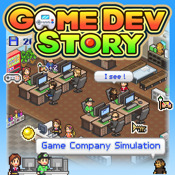 I’ve played a few iOS games this year, mostly just picked stuff up from word of mouth or something a friend developed. I started hearing about this little simulation title called Game Dev Story, and after reading up on the premise and reading about some crazy sounding experiences on Twitter, I had to check it out.
I’ve played a few iOS games this year, mostly just picked stuff up from word of mouth or something a friend developed. I started hearing about this little simulation title called Game Dev Story, and after reading up on the premise and reading about some crazy sounding experiences on Twitter, I had to check it out.
In a way, it’s basically in the genre of games my wife loves on her iPod Touch: the simple yet addictive management simulator. She loves Sally’s Spa and Diner Dash (and I’ll admit, I tried them both out and while I could easily recognize why someone would like them, they quickly became stale), and on the surface, Game Dev Story isn’t much different.
But it is different, and that’s why I’m bothering to write about it. Warning: Game Dev Story is extremely addictive, deep, and funny. Read on for my review.
Read moreOctober 22, 2010 by Greg Noe
 Rock Band 3 is due out very soon and I just read that there will be a Nintendo DS port of the game. Unlike Guitar Hero: On Tour, there will be no bonus peripherals used to control the game, just the regular buttons. If this sounds odd to you, well, the experience is already available! Harkening all the way back to Harmonix's first game, Frequency, released in 2001.
Rock Band 3 is due out very soon and I just read that there will be a Nintendo DS port of the game. Unlike Guitar Hero: On Tour, there will be no bonus peripherals used to control the game, just the regular buttons. If this sounds odd to you, well, the experience is already available! Harkening all the way back to Harmonix's first game, Frequency, released in 2001.
After Frequency and Ampltude grew a cult following, the rhythm music game world exploded with Guitar Hero and Rock Band. No more would we press mere buttons on a controller, but now we will press buttons on a plastic guitar (not hating, I love the Rock Band series)! I thought we would never see the classic button pressing gameplay ever again, but gaming history likes to repeat itself, and I recently discovered that Harmonix has brought it back with Rock Band: Unplugged and LEGO Rock Band DS.
Seeing as I don't own a PSP, I sat down to the odd combination of LEGO and Rock Band. Released about a year ago alongside its PS3/Wii/Xbox 360 big brothers, the DS version was hampered with a smaller soundtrack and no downloadable content, but it is available on the go. And of course, if you're a fan of Frequency and Amplitude, then it might be time to return home.
Read moreOctober 20, 2010 by Steve
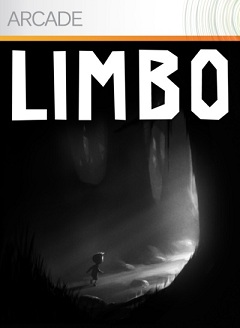 Theologically, limbo exists as a state of divine neutrality, a residence between heaven and hell. Limbo by Playdead Studios displays this fuzzy pseudo-reality in its presentation, but with a sinister twist. This limbo can be cruel, grewsome and even downright evil. Bear traps randomly lie on the ground, forever waiting just for you alone to trigger them. Giant spiders hide in caves, hoping you'll wander close enough for them to skewer with their giant legs. In Limbo, ghost children satisfy their concept of play by settingup guilottines and buzzsaws to shred you. This game is in no way particularly kind.
Theologically, limbo exists as a state of divine neutrality, a residence between heaven and hell. Limbo by Playdead Studios displays this fuzzy pseudo-reality in its presentation, but with a sinister twist. This limbo can be cruel, grewsome and even downright evil. Bear traps randomly lie on the ground, forever waiting just for you alone to trigger them. Giant spiders hide in caves, hoping you'll wander close enough for them to skewer with their giant legs. In Limbo, ghost children satisfy their concept of play by settingup guilottines and buzzsaws to shred you. This game is in no way particularly kind.
However, that cruel nature only adds to the atmosphere as the player must remain constantly aware of the presense of death in this bizarre, mysterious minimalist world. In this world and state of existence, death is the norm. Beginning as a stylistic proof of concept by a disgruntled game artist named Arnt Jensen, the concept soon flourished into a full game as Jensen subsequently co-founded Playdead Studios with Dino Patti to develop his idea. Originally planned for a PC release, Playdead was able to procure Dutch government grants and investor support while eventually deciding on an Xbox Live Arcade release, likely to avoid piracy worries and possibly for 360 exclusivity bonuses provided by Microsoft. The game eventually released this summer on July 21st during the 360's "Summer of Arcade." So, how does the final product match atmosphere and action? Does the constant presence of death help or hurt player mood and motivation? Let's take a deeper look and try to decide.
Read moreOctober 18, 2010 by Greg Noe
 Having just finished Split/Second last night at the midnight hour, I’m ready to talk about the experience. It was an intense, blister inducing ride that brought great joy and frustration to this veteran gamer. As I mentioned in my first hour review of the game, I’m not a fan of realistic racing games, but arcade racers like this and the Burnout series have a very special place in my heart (and on my game shelf). The first hour of the game blew me away, even though I played it almost two months ago, I remember the evening vividly. Split/Second was going to rock.
Having just finished Split/Second last night at the midnight hour, I’m ready to talk about the experience. It was an intense, blister inducing ride that brought great joy and frustration to this veteran gamer. As I mentioned in my first hour review of the game, I’m not a fan of realistic racing games, but arcade racers like this and the Burnout series have a very special place in my heart (and on my game shelf). The first hour of the game blew me away, even though I played it almost two months ago, I remember the evening vividly. Split/Second was going to rock.
I just reread Ian’s full review of Split/Second (we received a copy of the game from Disney, the publishers, and have been passing it around the writers here - look at the perks for writing for this site!) and I really have to agree with almost every single point he made. It’s a really fun game but can be incredibly frustrating at times. I wouldn’t go as far to say as there’s all out NFL Blitz style rubber band A.I., but the computer is a very challenging opponent, and there are seven of them out there on the track with you.
There’s a list of things I found wrong with the game, but I’d really like to start off by saying that this is a really good game. If you like arcade racers like Burnout, you will enjoy Split/Second. If you like unique genre-mashing experiences, this game might be worth a try. Here’s my full review of Split/Second for the Xbox 360.
Read moreOctober 13, 2010 by Mike in Omaha
 So it's been a while since I've written about games. It's actually been a while since I've played more than a few minutes of one. A crazy summer of children in the hospital, surgery, putting our dog to sleep after a nasty month-long illness, and planning a family reunion has meant that gaming has taken a back seat to lots of other things the last few months. My wife and I have made a name for the summer of 2010. It is, “The Summer of Suck”.
So it's been a while since I've written about games. It's actually been a while since I've played more than a few minutes of one. A crazy summer of children in the hospital, surgery, putting our dog to sleep after a nasty month-long illness, and planning a family reunion has meant that gaming has taken a back seat to lots of other things the last few months. My wife and I have made a name for the summer of 2010. It is, “The Summer of Suck”.
So that explains where I've been. But what is the reason I'm back? Well, to write a Beyond the First Hour review of course! But what game could be significant enough to get me out of my pitiful stupor of gamelessness? That game would be a little FPS that takes place on a planet called Pandora. That game would be Borderlands.
If you've been around The First Hour long enough, odds are good you've seen me comment on Borderlands, either from my First Hour review of the game, or via the comments section where we've discussed it several times. If you haven't, let me get you up to speed; I really enjoyed it. Ok, sure, that's a bit of a spoiler of the review you're about to read, but at this point in my life, I'm willing to do that. The reason is because the fourth and final DLC installment was just released on Sept. 28th.
I've been waiting for this ever since I finished the 3rd DLC back in March. So enough about me, let's get to the review.
Read moreOctober 8, 2010 by Greg Noe
 Here we are back for the third year in a row with another Professor Layton game. The series has definitely become an annual event that I look forward to as the games are enjoyable to play and chock full of challenging puzzles. I’ve compared the Professor Layton series to the Phoenix Wright series before, as both sets of games offer unusual types of gameplay on an annual basis. But some other similarities are starting to creep in, and that’s the feeling of staleness.
Here we are back for the third year in a row with another Professor Layton game. The series has definitely become an annual event that I look forward to as the games are enjoyable to play and chock full of challenging puzzles. I’ve compared the Professor Layton series to the Phoenix Wright series before, as both sets of games offer unusual types of gameplay on an annual basis. But some other similarities are starting to creep in, and that’s the feeling of staleness.
The series hasn’t evolved a lot in three games, this isn’t necessarily a bad thing as the puzzles are great and the stories always intriguing, but it’s starting to feel like I’m playing expansion packs instead of brand new games. I awarded the first game, Curious Village, a 9/10 and its sequel, Diabolical Box, an 8/10, and I’m about to hand out a 7/10 to Unwound Future. I put a lot of value in mixing things up and trying something new, and the Professor Layton series just isn’t going anywhere. This isn’t to say I didn’t enjoy my 20 hours with Unwound Future, but I’d really love for something more.
If this is your first Professor Layton game, you can expect a point and click style story-driven game with tons of unrelated puzzles to keep you interested. There isn’t any prior knowledge required to play Unwound Future, so it’s definitely a series someone can jump into at any point. Here’s my full review of Professor Layton and the Unwound Future. If you’re curious, I also have a half-hour handheld review up too.
Read moreSeptember 27, 2010 by Steve
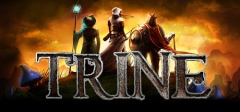 Trine is the kind of game you can't help but wish came along more often, as a rare legitimate platformer. Frozenbyte (along with certain notable indie developers) shows us that 2d platforming is in fact not dead and can be pushed as far as you'll willing to take it. Perhaps most impressively, Trine is in elite company as one of the few download-centric titles that could be mistaken as a traditional retail release.
Trine is the kind of game you can't help but wish came along more often, as a rare legitimate platformer. Frozenbyte (along with certain notable indie developers) shows us that 2d platforming is in fact not dead and can be pushed as far as you'll willing to take it. Perhaps most impressively, Trine is in elite company as one of the few download-centric titles that could be mistaken as a traditional retail release.
For example, check a screenshot of some random game. You likely see an area with a background, or maybe walls or repeating buildings. Perhaps an enemy or two are in the frame and an interactive objects of note. Now take a look at random screenshot of Trine. You see a struggling forest that has been encroached on by both technology and a plague of death. The foreground partially hides you in sparse blades of grass, a handful of flowers, and a large warped tree root. In the background, multiple metallic gears are encrusted into the hill, which is itself overlooked by a towering mountain. The sunlight beaming from above onto wild mushrooms is nothing but welcoming as your knight just escaped from the cave and is heading to a well-constructed but still wobbly bridge up ahead. While one could say such lush descriptions could be extrapolated out of any image; to me, the difference is clear. Trine tries to feed your imagination and create an organic, living environment. While the experience does not stay fully fresh the entire way, Trine has more than enough creativity and character to deserve a second look, as noted in our earlier first hour playthrough.
Read moreSeptember 17, 2010 by Nate
 Metroid has never been one of Nintendo's big money-makers, but that hasn't stopped the franchise from garnering some very devoted fans. It's not uncommon to see Super Metroid or Metroid Prime sitting atop the list of favorites from hardcore gamers, and for good reason. Super Metroid provided a sprawling, interlacing realm of disquieting alien dangers and secrets, and Metroid Prime translated that experience into 3D with incredible audio-visual design and some interesting world-building mechanics built right into the gameplay.
Metroid has never been one of Nintendo's big money-makers, but that hasn't stopped the franchise from garnering some very devoted fans. It's not uncommon to see Super Metroid or Metroid Prime sitting atop the list of favorites from hardcore gamers, and for good reason. Super Metroid provided a sprawling, interlacing realm of disquieting alien dangers and secrets, and Metroid Prime translated that experience into 3D with incredible audio-visual design and some interesting world-building mechanics built right into the gameplay.
Though there's certainly a base blueprint from these two trailblazers, no two Metroid games feel exactly alike. Even so, I've found something to love in each and every one of them (except for the antiquated debut NES game, which admittedly I just played for the first time days before Other M's release). The tension of being hunted in Fusion, the sudden shifts in power at Zero Mission's final hour, the thousands of text logs scattered through the Prime series...as far as I'm concerned, it's all great stuff.
It's only natural that the formula would see some alterations and evolutions over a quarter of a century, and Metroid: Other M is the latest and most radical experiment to come out of Nintendo's R&D labs in quite some time. Featuring third-person 3D action gameplay and a heavy emphasis on cinematic storytelling, the curiously-subtitled Other M certainly feels very different from its predecessors. It seems to take after Metroid Fusion the most, with a bit of Metroid Prime in there as well, but Other M's additions and adaptations certainly make it feel distinct, for better or worse.
Read moreSeptember 13, 2010 by Steve
 What would you think when told of a game combining elements of pachinko, Arkanoid and Puzzle Bobble? Like me, you'd probably be a bit confused. Probably something involving balls being shot and bounced around. The concept was interesting enough to try when we received a request to review the Caelum by ApGames. The upstart Swedish developers recently released their self-proclaimed "addictive physics-based arcade game." So let's get right into it and see how the unique gameplay combinations measure up.
What would you think when told of a game combining elements of pachinko, Arkanoid and Puzzle Bobble? Like me, you'd probably be a bit confused. Probably something involving balls being shot and bounced around. The concept was interesting enough to try when we received a request to review the Caelum by ApGames. The upstart Swedish developers recently released their self-proclaimed "addictive physics-based arcade game." So let's get right into it and see how the unique gameplay combinations measure up.
September 8, 2010 by Greg Noe
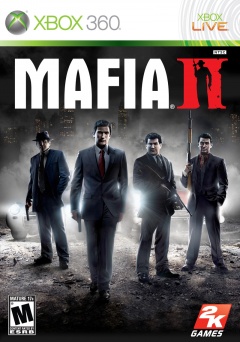 Since Grand Theft Auto III was released in 2001, there has been a new expectation of open world video games. Along with a story, there needs to be dozens of extra things to do that usually have little to do with the actual plot, such as driving a taxi cab, delivering pizzas, or putting out fires (that you started!). Now what if we had a game that featured an open world, but was story driven and linear? Seems like a bit of an oxymoron, but that’s exactly what Mafia II is.
Since Grand Theft Auto III was released in 2001, there has been a new expectation of open world video games. Along with a story, there needs to be dozens of extra things to do that usually have little to do with the actual plot, such as driving a taxi cab, delivering pizzas, or putting out fires (that you started!). Now what if we had a game that featured an open world, but was story driven and linear? Seems like a bit of an oxymoron, but that’s exactly what Mafia II is.
Mafia II was released in August on the Xbox 360, PlayStation 3, and Windows. Reception has been good but for a game in development for over half a decade, some gamers and analysts were expecting better. Mafia II is all about recreating that favorite mobster movie of yours and putting control into your hands. While it isn’t my favorite genre of film, I can appreciate a good mob tale when I see one.
Our copy of Mafia II was provided to us by 2K Games, this review is for the Xbox 360 version.
Read moreAugust 16, 2010 by Greg Noe
 There's a bit of a parallel with the games I've been playing lately. Super Mario Galaxy 2 and Gears of War 2 are both sequels to games released this generation, and at first glance, appear to be essentially re-releases of the first game with a new shine. Where the parallels end though is that while Super Mario Galaxy 2 has a ton of new features, Gears of War 2... does not.
There's a bit of a parallel with the games I've been playing lately. Super Mario Galaxy 2 and Gears of War 2 are both sequels to games released this generation, and at first glance, appear to be essentially re-releases of the first game with a new shine. Where the parallels end though is that while Super Mario Galaxy 2 has a ton of new features, Gears of War 2... does not.
I'm honestly surprised, a bit blown away actually, by how little Epic Games bothered to improve on the original Gears of War game. Gears of War 2 supposedly added five weapons, but only one really stands out. There might also be some new enemies, but as they're all so butt ugly and A.I.-dumb it doesn't really matter. There are a bunch of new locations, but everything is still all brown and gray with some city levels and underground levels.
Gears of War 2 is really just Gears of War 1.1.
Read moreAugust 11, 2010 by Greg Noe
 It has been a while since we've seen two core Mario series games on one Nintendo system in a while, you need to go back to the Super Nintendo with the two Super Mario Worlds for the last example, and it is highly arguable whether Yoshi's Island can be considered a core Mario game for that matter. Surprisingly, Nintendo announced Super Mario Galaxy 2 last year and the game was released this May to much herald and acclaim. Glancing at Metacritic, the top two games for the Wii are our two Galaxies, an incredible triumph for Nintendo.
It has been a while since we've seen two core Mario series games on one Nintendo system in a while, you need to go back to the Super Nintendo with the two Super Mario Worlds for the last example, and it is highly arguable whether Yoshi's Island can be considered a core Mario game for that matter. Surprisingly, Nintendo announced Super Mario Galaxy 2 last year and the game was released this May to much herald and acclaim. Glancing at Metacritic, the top two games for the Wii are our two Galaxies, an incredible triumph for Nintendo.
I actually beat Super Mario Galaxy 2 well over a month ago, but I decided, much like I did with the first Super Mario Galaxy, to wait until I had collected all 120 stars before writing a review. Actually, make that 240, no... 242 stars! Galaxy 2 more than doubles the collectible star count over the original while keeping the game both interesting and challenging. But is the game too much like the Super Mario Galaxy, or does it set itself apart enough to transcend the typical sequel failings we've been witness of lately?
For a look at the game's opening, check out Nate's first hour review of Super Mario Galaxy 2 published right after release.
Read moreAugust 9, 2010 by Ian M. Bagley
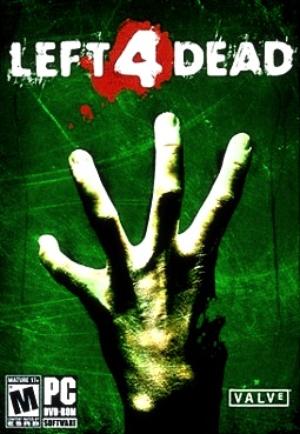 When I heard the announcement for Left 4 Dead, I was enormously elated. Finally, a game dedicated to fast-paced zombie action. A game I could rely on to really satisfy my urges to kill a swarm of infected. Then, when I saw the videos of people at E3 playing it for thirty minutes and then heading to the back of the huge line to play it again, there was no question.
When I heard the announcement for Left 4 Dead, I was enormously elated. Finally, a game dedicated to fast-paced zombie action. A game I could rely on to really satisfy my urges to kill a swarm of infected. Then, when I saw the videos of people at E3 playing it for thirty minutes and then heading to the back of the huge line to play it again, there was no question.
My hunger for a real zombie game had been stirring for years. I hated Resident Evil, and still do. The idea of searching around everywhere and solving more puzzles than killing zombies -- I was disgusted. The only thing that helped curve my thirst was Counter Strike: Source, where my friend and I would play “zombies” by pitting ourselves against 30 or so bots and allowing them to only use knives. I was even happier to hear that was the way Valve decided to make Left 4 Dead. They did the exact same thing.
I was counting the days in November, 2008, for the game's release. Every day at college just seemed to drag on and on, forever, until finally the day came. My classes felt longer than those of my final days before Christmas Break. When I got done with school the day of Left 4 Dead's release, I went straight to the store to pick up the game.
I purchased the PC version, and played through the entire game in a very brief period of time, but that was okay. With all of the achievements to be had, as well as the scoring and varying difficulty levels, this game had more replay-ability than any game I had played before or since. It never gets old. I love this game, and now I own it on Xbox to play the game cooperatively with my wife. We also spend quite a bit of time online playing against other players.
Read moreAugust 2, 2010 by Greg Noe
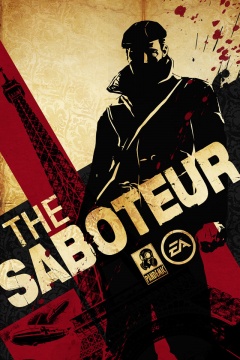 I don’t think I’ve ever played a game and honestly felt sad that the developer was no longer around, but that’s exactly what happened after I beat Pandemic Studios’ swan song, The Saboteur. I had an honestly great time with a flawed game, which is the opposite experience I’ve had with similar games in the genre.
I don’t think I’ve ever played a game and honestly felt sad that the developer was no longer around, but that’s exactly what happened after I beat Pandemic Studios’ swan song, The Saboteur. I had an honestly great time with a flawed game, which is the opposite experience I’ve had with similar games in the genre.
The Saboteur is pretty much the quintessential First Hour game: I played the first hour of the game a few months back, loved it, but had to send it back to my brother-in-law. A few months later I had the opportunity to borrow it again and jumped at the chance. When I said I wanted to keep playing, I really did.
Without much further ado, The Saboteur was released on the Xbox 360, PlayStation 3, and Windows, and while the game seems to hint at future sequels, with the studio closing it is doubtful those will ever appear. But you never know, I’m assuming EA owns the license to the game and characters so they might trudge up good old Sean Devlin again someday.
My full review is on the Xbox 360 version.
Read moreJuly 26, 2010 by Nate
 Every Monday morning since the Wii craze began in November 2006, the Wii Shop Channel has been updated with new downloadable titles to purchase. The Virtual Console, one of the Wii's few enticing tidbits to core gamers at launch, promised to make all our favorite classic games through the N64 era available on one piece of hardware. Things started out strong for the VC, which reached the 100-game milestone just over six months after launch. It seems Nintendo just couldn't keep that pace, however, as the first seven months of 2010 have seen less than twenty new retro titles. With obvious Nintendo classics like Star Fox, Yoshi's Island, Pilotwings 64, and Excitebike 64 still waiting to be let loose -- in addition to the many unseen third party games worth revisiting -- it seems far too early for the Virtual Console to receive less than one title a week.
Every Monday morning since the Wii craze began in November 2006, the Wii Shop Channel has been updated with new downloadable titles to purchase. The Virtual Console, one of the Wii's few enticing tidbits to core gamers at launch, promised to make all our favorite classic games through the N64 era available on one piece of hardware. Things started out strong for the VC, which reached the 100-game milestone just over six months after launch. It seems Nintendo just couldn't keep that pace, however, as the first seven months of 2010 have seen less than twenty new retro titles. With obvious Nintendo classics like Star Fox, Yoshi's Island, Pilotwings 64, and Excitebike 64 still waiting to be let loose -- in addition to the many unseen third party games worth revisiting -- it seems far too early for the Virtual Console to receive less than one title a week.
The future of the Virtual Console was looking bright in 2007, however, when Nintendo decided to make the N64 import classic Sin & Punishment available outside of Asia for the first time. It seems Treasure always planned a western release, as all the voice acting was performed in English (with Japanese subtitles), even in the original Japanese cartridge. The rumor is that a dried-up N64 market in 2000 made the niche developer think twice. In a rare showing of extra effort on Nintendo's part, Sin & Punishment was the first of a small collection of games formerly exclusive to Japan to make it to the Americas. It probably didn't take that much effort, though, since the only translation required was in the main menu and tutorials. The original Japanese subtitles persist even in the localized version.
I'd always planned on putting down the $12 to try Sin & Punishment at some point, but I figured the recent release of Sin & Punishment: Star Successor for the Wii makes this as good a time as any. Might as well snag the N64 game for some context, right? I downloaded the game with the intent of completing a first hour review for our readers, but it seems there isn't a whole lot to talk about beyond that first sixty minutes, so this has been upgraded to full review status. Lucky you!
July 21, 2010 by Greg Noe
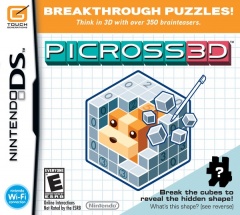 I can't name a lot of puzzle games I've honestly enjoyed. Tetris Attack, the Professor Layton series if those count, World of Goo? As you can tell I'm not a huge fan of the genre. I might play a puzzle game for a few rounds before I become bored, but Picross 3D was different, really different. I've already managed to beat over 200 levels and was becoming so obsessed with the game I was carrying my DS to work in case the opportunity came up over lunch.
I can't name a lot of puzzle games I've honestly enjoyed. Tetris Attack, the Professor Layton series if those count, World of Goo? As you can tell I'm not a huge fan of the genre. I might play a puzzle game for a few rounds before I become bored, but Picross 3D was different, really different. I've already managed to beat over 200 levels and was becoming so obsessed with the game I was carrying my DS to work in case the opportunity came up over lunch.
Picross 3D is not a typical puzzle game, it's slow moving and requires a lot of careful thought. There is little guessing involved and it does an excellent job of driving you on from puzzle to puzzle. As someone who had never played a Picross game before, I really had no idea what I was getting into until I read Nate's half hour review of the game. The game is cheap though so there's little investment for a chance of tons of hours of gaming. Plus it reminds me of my Kakuro obsession during my senior year of college.
Get ready for my shortest review ever!
Read moreJuly 19, 2010 by Nate
 It's hard to find a gamer who doesn't have some experience with the Half-Life franchise. A champion of PC software when things started shifting heavily in the favor of consoles, the original Half-Life wowed critics with its pulse-pounding scripted sequences and seamless stitching of narrative and gameplay in first-person. The long-awaited full sequel, Half-Life 2, received just as many accolades, if not more, for its advances in artificial intelligence, character animation, and especially the robust physics engine powering the game's many objects.
It's hard to find a gamer who doesn't have some experience with the Half-Life franchise. A champion of PC software when things started shifting heavily in the favor of consoles, the original Half-Life wowed critics with its pulse-pounding scripted sequences and seamless stitching of narrative and gameplay in first-person. The long-awaited full sequel, Half-Life 2, received just as many accolades, if not more, for its advances in artificial intelligence, character animation, and especially the robust physics engine powering the game's many objects.
And yet, it was only two weeks ago that I first experienced a game in Valve's flagship franchise myself. I've never been much of a PC gamer: I can count the number of games I've played on a computer monitor on one hand, and four of them begin with the words "Star Wars." I've had many consoles in my life, but rarely a PC with the power to play current games. I'm actually typing this on a Macbook right now, and as we all know, Macs just aren't for gamers.
That said, Valve has made an effort to bite into the Apple market with Mac versions of Steam and many of its own big games offered therein, just in time for the annual 4th of July sales on the incredible digital distribution service. And if Valve is willing to create a Mac version of Half-Life 2 and price it at an outrageously fair $3.39 just for me, then I guess I owe it to them to try the game that millions have gone headcrab-crazy for.
But for all its fame and glory, the bottom line is that Half-Life 2 is a six-year-old PC game in a genre I'm not terribly enthralled by. Did I hate it? Hit the jump, smash that caps lock key and ready your profane comments, PC fanboys, because I'm about to tear into your beloved Half-Life 2 like a shotgun into an antlion.
Read moreJuly 7, 2010 by Grant
 When most people think of Dragon Ball, they think of energy blasts, non-stop fights against aliens, and dozens of episodes where the only thing happening is veins bulging. But once upon a time, Dragon Ball was a simple kung fu adventure show starring a kid with a monkey tail that was loosely-kinda-sorta-maybe based off of the classic Chinese tale “Journey to the West.” Dragon Ball: Origins takes us back to this simpler time before Goku was a demigod and every other thing wanted to blow up Earth, and delivers a solid adventure for old and new fans.
When most people think of Dragon Ball, they think of energy blasts, non-stop fights against aliens, and dozens of episodes where the only thing happening is veins bulging. But once upon a time, Dragon Ball was a simple kung fu adventure show starring a kid with a monkey tail that was loosely-kinda-sorta-maybe based off of the classic Chinese tale “Journey to the West.” Dragon Ball: Origins takes us back to this simpler time before Goku was a demigod and every other thing wanted to blow up Earth, and delivers a solid adventure for old and new fans.
July 5, 2010 by Nate
 Professional athletes who excel at multiple sports are understandably rare. The ideal body proportions of an offensive lineman and a power forward are basically inverse. The abilities and skills required by a closing pitcher and a starting goaltender are worlds apart. And who could possibly have enough time to devote their training and competitive passion to two separate sports seasons that last six months or more each year? Ask a sports buff if any athletes have made an impact on two different sports, and they'll probably answer with Bo Jackson, Deion Sanders, and possibly Michael Jordan with a sneer.
Professional athletes who excel at multiple sports are understandably rare. The ideal body proportions of an offensive lineman and a power forward are basically inverse. The abilities and skills required by a closing pitcher and a starting goaltender are worlds apart. And who could possibly have enough time to devote their training and competitive passion to two separate sports seasons that last six months or more each year? Ask a sports buff if any athletes have made an impact on two different sports, and they'll probably answer with Bo Jackson, Deion Sanders, and possibly Michael Jordan with a sneer.
Ask a gamer, however, and the only answer will be Mario. Ever since the platforming plumber took up golf in 1991's NES Open Tournament Golf, Mario's been blazing a trail across athletic endeavors that none could possibly match, serving up scorchers with his tennis racket in one hand and palming a basketball in the other. The Italian even competes under his own personal flag in both the Summer and the Winter Olympic Games. And next year, Mario will be adding Dodgeball to his list with the launch of Mario Sports Mix, which will also feature the gaming icon's return to Volleyball, Hockey, and Basketball. Even with his talents spread so thin, critics have mostly praised Mario's spinoff sports titles for their sufficient gameplay and charming Mushroom Kingdom aesthetic.
Somebody forgot to tell Next Level Games about that Mushroom Kingdom charm, however, as the Canadian developer decided to go a drastically different route for their take on Mario playing Soccer, Mario Strikers Charged. Sure, Mario and his assortment of friends with mustaches and crowns all show up, as do the requisite mushrooms, shells, and stars, but something seems to have deeply upset the usually benevolent bunch: smiles turn to scowls, frilly dresses are traded for form-fitting battle armor, and the good-natured teasing is replaced with some outright lewd gestures. The tone may have taken a turn for the drab, but there is still plenty of fun to be had with this bizarre Mario Sports title.
Read moreJune 23, 2010 by Greg Noe
 Over the course of The Legend of Zelda series, I haven't missed a lotof games. I've played everything from Zelda II to Majora's Mask toOracle of Ages, but there was one that I had skipped: The Legend ofZelda: The Minish Cap. Why that one? How could I have missed it? Ican only determine that my interest was low due to it being developedoutside Nintendo again (Minish Cap, the two Oracle games, and FourSwords were created by Flagship, a former Capcom studio) and that itmissed the 2004 holiday window by a few weeks. Plus, for whateverreason it seemed like a kids game. I always saw the feature of Linkturning into a pixie as... lame.
Over the course of The Legend of Zelda series, I haven't missed a lotof games. I've played everything from Zelda II to Majora's Mask toOracle of Ages, but there was one that I had skipped: The Legend ofZelda: The Minish Cap. Why that one? How could I have missed it? Ican only determine that my interest was low due to it being developedoutside Nintendo again (Minish Cap, the two Oracle games, and FourSwords were created by Flagship, a former Capcom studio) and that itmissed the 2004 holiday window by a few weeks. Plus, for whateverreason it seemed like a kids game. I always saw the feature of Linkturning into a pixie as... lame.
How wrong I was.
Fiveyears later and I finally determine that it's high time to play TheMinish Cap, so I add it to my Amazon wishlist and receive it for mybirthday in May. I plowed through this game like my family's livesdepended on it (meaning I ignored them in the process, whoops, won'thappen again), but wanted to let the game sink in for a while before Iorganized all my thoughts and finished the review.
It's probablyworth comparing my review of this game to the two previous portableZeldas: Phantom Hourglass and Spirit Tracks. I always felt like thosegames were missing something, but I couldn't lay my finger on it untilI played The Minish Cap. Here's my full review of the one I almost letget away: The Legend of Zelda: The Minish Cap.
Read moreJune 22, 2010 by Grant
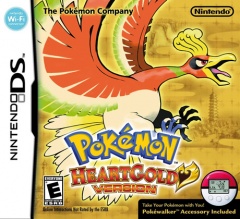 The “Pokemon fad” died about ten years ago, but the franchise is still as strong as ever as Diamond and Pearl sold over 17 million copies worldwide. In order to satiate the appetite of rabid Pokemon fans anxiously awaiting the next generation of games (which were recently announced as Black and White), Nintendo decided to remake the second generation games, Gold and Silver. Pokemon has changed a lot in the ten years since the release of Gold and Silver, but fortunately Nintendo has added every single innovation into the remake, along with a few new ones.
The “Pokemon fad” died about ten years ago, but the franchise is still as strong as ever as Diamond and Pearl sold over 17 million copies worldwide. In order to satiate the appetite of rabid Pokemon fans anxiously awaiting the next generation of games (which were recently announced as Black and White), Nintendo decided to remake the second generation games, Gold and Silver. Pokemon has changed a lot in the ten years since the release of Gold and Silver, but fortunately Nintendo has added every single innovation into the remake, along with a few new ones.
June 14, 2010 by Paul Eastwood
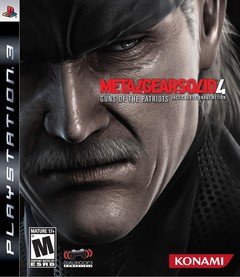 Metal Gear Solid 4: Guns of the Patriots is the final chapter of the Metal Gear saga (kind of). It seeks to wrap up the complicated plots from the previous three games, which up to this point seem to be fairly divergent. It also seeks to perfect the gameplay and presentation for which Kojima-san and his Metal Gear Solid games have become famous.
Metal Gear Solid 4: Guns of the Patriots is the final chapter of the Metal Gear saga (kind of). It seeks to wrap up the complicated plots from the previous three games, which up to this point seem to be fairly divergent. It also seeks to perfect the gameplay and presentation for which Kojima-san and his Metal Gear Solid games have become famous.
It is also the first game in the series on the PlayStation 3, and it uses this hardware to be one of the best looking games ever. The MGS series has always used the in-game graphics engine to render its cutscenes to prevent a jarring disconnect between graphic styles, and this is the first time it works perfectly. The in-game character models look good enough that you can't complain a bit. The facial animations and lip-syncing is increbible. The game is, in a word, stunning.
So we know the game looks good, we can tell that from screenshots and trailers Is it good? Is it fun? Is it worth buying? For those of you with short attention spans, the answer is yes. For everyone else, read on.
June 10, 2010 by Greg Noe
 If there's a series I lost track of over the years it's Mario RPG,which is really now made up of two series. After the original SuperMario RPG: Legend of the Seven Stars on the SNES, Nintendo split uptheir new Square-spawned role-playing series between their consoles andportables. The curious Paper Mario started off on the Nintendo 64 andthe even curiouser Mario & Luigi kicked off with Superstar Saga onthe Game Boy Advance.
If there's a series I lost track of over the years it's Mario RPG,which is really now made up of two series. After the original SuperMario RPG: Legend of the Seven Stars on the SNES, Nintendo split uptheir new Square-spawned role-playing series between their consoles andportables. The curious Paper Mario started off on the Nintendo 64 andthe even curiouser Mario & Luigi kicked off with Superstar Saga onthe Game Boy Advance.
While I had loved the original Super MarioRPG, I had a bit more trouble getting into Paper Mario. I playedthrough most of the game, but after watching my cousin beat it fromstart to finish over a long weekend, I packed it away for good. Andfor whatever reason, I never played any games from the Mario &Luigi series... until now.
Mario & Luigi: Bowser's InsideStory was getting great reviews so I added it to my Christmas list on awhim. I received it, surprisingly, and added it to my portable gamingqueue, and after forcing myself to finally beat Zelda: Spirit Tracksand read through the long Miles Edgeworth game, I finally landed onBowser's Inside Story. Why the heck did I wait so long?
Read more
June 2, 2010 by Greg Noe
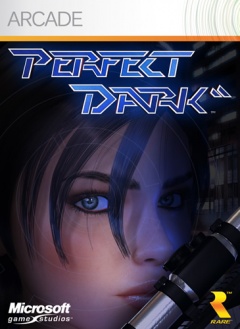 Sometimes, nostalgia has the habit of biting back. Hard. Ten years ago, Perfect Dark was released on the Nintendo 64, and along with The Legend of Zelda: Majora's Mask, capped off a great system by pushing it way past its limits. I gobbled this game up when it was released by throwing parties in my parent's basement and putting off getting my driver's license for another month. GoldenEye 007 was a great first-person shooter, but we were ready for some Perfect Dark.
Sometimes, nostalgia has the habit of biting back. Hard. Ten years ago, Perfect Dark was released on the Nintendo 64, and along with The Legend of Zelda: Majora's Mask, capped off a great system by pushing it way past its limits. I gobbled this game up when it was released by throwing parties in my parent's basement and putting off getting my driver's license for another month. GoldenEye 007 was a great first-person shooter, but we were ready for some Perfect Dark.
Ten years later, and Perfect Dark is ported to Xbox Live Arcade. I was a bit worried: how would a pre-Halo first-person shooter play against its modern day brethren? In my opinion, while GoldenEye was the console shooter breakout hit, Halo had set the standard for how they should actually play. Its control scheme is still used to this day, and imagining myself strafing with the C-buttons gives me the shivers.
For only $10 though, it was a hard bargain to pass up. Here was a game that I coughed up $59.99 + taxbefore I even had a job, I could easily hand over 800 Microsoft Points for a trip down memory lane. My friend Jim also bought the game, and we decided to take the journey together, playing through the single player campaign via online co-op (imagine doing that ten years ago on the Nintendo 64!). While we had both played the original, I was the more die-hard fan and had pored countless hours into my multiplayer character. We started up, with him playing as the lovely Joanna and me as the blonde no-named sister.
May 21, 2010 by Greg Noe
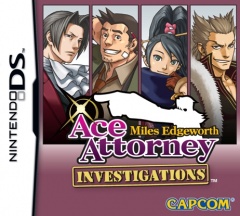 This game was a long time coming, but the true evolution of the Ace Attorney series has arrived with Ace Attorney Investigations: Miles Edgeworth. After four games of playing as a defense attorney, we finallyexperience what it's like to play as a prosecutor, particularly fanfavorite Miles Edgeworth. Miles has been a staple of the series butmostly as an antagonist turned sort-of-friend, but now we get to takedirect control of him in a series of cases surrounding a smuggling ringand a great thief.
This game was a long time coming, but the true evolution of the Ace Attorney series has arrived with Ace Attorney Investigations: Miles Edgeworth. After four games of playing as a defense attorney, we finallyexperience what it's like to play as a prosecutor, particularly fanfavorite Miles Edgeworth. Miles has been a staple of the series butmostly as an antagonist turned sort-of-friend, but now we get to takedirect control of him in a series of cases surrounding a smuggling ringand a great thief.
I've played all the previous games in the series and reviewed the last two on this site, Trials and Tribulations and Apollo Justice. While the games themselves are really long and haven't really evolvedgameplay wise over the last five years, I'm still continually drawn tothem year in and year out. They just have this great charm to themthat not only stems from great original writing, but also the besttranslations in the business. A ton of effort goes into these games'stories and characters, and it shows.
So here's my review ofMiles Edgeworth, in what could be the last game in the Ace Attorneyseries since the team has apparently moved on to a new game calledGhost Trick: Phantom Detective. I truly hope we see more from thePhoenix Wright universe one day though.
May 18, 2010 by Ian M. Bagley
 In all my years, I’ve never been much of a racing game fan. Quitehonestly, the idea of doing the same thing over and over feels tediousto me. While some games, like Need for Speed Underground and GranTurismo have offered vehicle customization to try and keep thingsfresh, they still seem to fall into a slump of painful repetition.
In all my years, I’ve never been much of a racing game fan. Quitehonestly, the idea of doing the same thing over and over feels tediousto me. While some games, like Need for Speed Underground and GranTurismo have offered vehicle customization to try and keep thingsfresh, they still seem to fall into a slump of painful repetition.
ButBlack Rock Studios, the creators of Pure, have strived to come up to asolution to this plague, and that is massive destruction and a gamepremise unique from any other racing game I’ve ever laid my eyes on.This solution is called Split/Second.
The premise of the game isthat you’re a stunt driver in a reality television series calledSplit/Second, that has these stunt drivers racing against each other incities manufactured by the television show. While stunts, inthemselves, are not entirely new, the massive chaos is extremelyrefreshing.
We’ve all played Mario Kart, and we’ve shot koopashells at our enemies and laughed as they were rendered motionlesswhile we passed them into first place, and it’s relatively satisfyingto a point, but this is different.
But where Mario Kart is setto stun, Split/Second is set to kill. From gas station explosions andhelicopters dropping explosive barrels to air planes crashing on theraceway, this game delivers a completely original adrenaline rush thatdelivers over and over again.
You’re in control of these beautifuldisasters with power plays, which are your weapons in this dog-eat-dogracing world. The way to activate them is to accumulate energy. You canaccomplish this by drifting around corners, drafting behind youropponents, and jumping with your vehicle. You also receive a bonusamount of energy by passing opponents while drifting, jumping pastopponents and dodging power plays set off in your path.
Read moreMay 17, 2010 by Mike in Omaha
 Sequels. Comic franchises converted to video games. Movie tie-ins.Studios closing their doors. Needless to say, there are a lot ofbarriers that can narrow the odds of producing a high quality title. Itwould seem that Iron Man 2 was forced to hurdle all of them. As Imentioned in my recent First Hour review of Iron Man 2, its predecessorwas critically panned. But did it deserve it? Or did it fall prey tothe echo chamber of hate that often befalls licensed products and spinoffs? The truth is, Iron Man had it’s problems. From unwieldy controlsto frame rate issues, it seemed like it stumbled each time it wouldjust get up to speed. But it had moments of fun, high intensity superhero action that carried one through to each subsequent mission. Goinginto a sequel, one assumes that Sega Studios San Francisco, thedeveloper behind both titles would make an effort to improve thefailings of the original while trying to maintain those things they gotright the first time. The question is, did they pull it off?
Sequels. Comic franchises converted to video games. Movie tie-ins.Studios closing their doors. Needless to say, there are a lot ofbarriers that can narrow the odds of producing a high quality title. Itwould seem that Iron Man 2 was forced to hurdle all of them. As Imentioned in my recent First Hour review of Iron Man 2, its predecessorwas critically panned. But did it deserve it? Or did it fall prey tothe echo chamber of hate that often befalls licensed products and spinoffs? The truth is, Iron Man had it’s problems. From unwieldy controlsto frame rate issues, it seemed like it stumbled each time it wouldjust get up to speed. But it had moments of fun, high intensity superhero action that carried one through to each subsequent mission. Goinginto a sequel, one assumes that Sega Studios San Francisco, thedeveloper behind both titles would make an effort to improve thefailings of the original while trying to maintain those things they gotright the first time. The question is, did they pull it off?
After sitting in on the developer conference call for Iron Man 2, I washopeful that things were looking good. They talked about a dedicationto listening to fans, and to implementing those lessons they learnedfrom user feedback on the first game. They talked about simplifiedcontrols, vast levels, destructible environments and deepcustomization. They touted a boss that is “bigger than any boss in anygame ever”. And War Machine. War Machine sounded like a perfectaddition to the Iron Man gaming universe. Yes, it sounded like it hadreally come together. And so I eagerly anticipated my review copy,thinking back to the flawed but fun experience I had with the firstgame.
May 7, 2010 by Nate
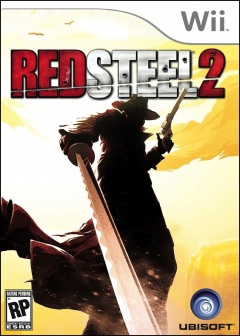 The first third-party Wii game was revealed in the May 2006 issue ofGame Informer. It promised intuitive swordfighting controls andunmatched precision in gunplay, all in a stylish Yakuza setting. In thesix months between reveal and launch, Red Steel hype built tounattainable levels. Disappointment was inevitable. But even withtempered expectations, Red Steel is barely an average game, and thecase for motion controls in action games took a serious blow when itfailed to impress.
The first third-party Wii game was revealed in the May 2006 issue ofGame Informer. It promised intuitive swordfighting controls andunmatched precision in gunplay, all in a stylish Yakuza setting. In thesix months between reveal and launch, Red Steel hype built tounattainable levels. Disappointment was inevitable. But even withtempered expectations, Red Steel is barely an average game, and thecase for motion controls in action games took a serious blow when itfailed to impress.
That said, the game rode the launch hype into some pretty decentsales, eventually crossing the million mark. A sequel was rumoredalmost as soon as the original appeared on store shelves. It took threeand a half years, but the sequel did eventually arrive in March 2010.Barring the focus on guns and swords, Red Steel 2 is nothing like theoriginal: the realistic visuals are switched out for a cel-shadedstyle, the Yakuza setting and characters are changed to anotherworldly-mix of Samurai and Western trappings, and the hopes dashedby waggle at launch are replaced with renewed fervor for precise motioncontrols, which are provided by the Wii Motion Plus controllerattachment that Red Steel 2 requires.
Even if you made the mistake of purchasing Red Steel back in 2006, don't make the mistake of ignoring Red Steel 2 now.
April 15, 2010 by Greg Noe
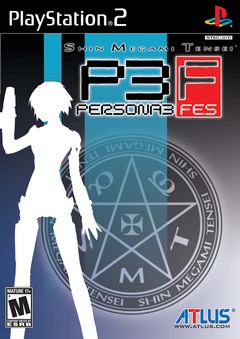 It was just a few years ago that I was a Japanese RPG freak. Injust one holiday, I asked for and received Persona 3 FES, ValkyrieProfile 2: Silmeria, and Rogue Galaxy. Three of the biggest JRPGs toland at the end of the PS2 lifespan. You know how much of those gamesI've played since? About 30 hours of Persona 3, the first hour of Rogue Galaxy, and I haven't even touchedValkyrie Profile 2; I blame it all on the games themselves.
It was just a few years ago that I was a Japanese RPG freak. Injust one holiday, I asked for and received Persona 3 FES, ValkyrieProfile 2: Silmeria, and Rogue Galaxy. Three of the biggest JRPGs toland at the end of the PS2 lifespan. You know how much of those gamesI've played since? About 30 hours of Persona 3, the first hour of Rogue Galaxy, and I haven't even touchedValkyrie Profile 2; I blame it all on the games themselves.
If Iwere to make an exhaustive list of my all-time favorite games, it wouldundoubtedly be topped by Chrono Trigger, closely followed by SuikodenII and Final Fantasy VI, with Final Fantasy X somewhere up there too. All Japanese RPGs, and all very good games for varying reasons. Ispent my college years playing more from what used to be my favoritegenre, and watched my roommate play a ton of them including theoriginal Valkyrie Profile, Shadow Hearts: Covenant, my copy ofXenogears, and pretty much the entire Xenosaga trilogy.
Maybe Iwas already burned out on the genre when I heard about how greatPersona 3 was; how it was the ultimate JRPG and that a re-release ofthe game was going to put it into my budget again. By the time Istarted playing it, I even had Persona 4 in my possession already(which I also haven't touched). I knew without a doubt I was going tolove this game.
Note: This post evolved from a rant onPersona 3 into a rant review on Persona 3, so while it's designated asa full review, I have not beaten either Persona 3 FES or Odin Sphere. No final scores will be given for obvious reasons.
Read moreApril 13, 2010 by Greg Noe
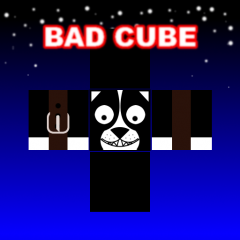 The iPhone App Store is flooded with games, some of them very good, most of them bad, but there's just an oversaturation of everything. Only the lowest common denominator crap rises to the top (unless it's Plants vs. Zombies, that game is awesome) and tons of gems are drowned by a sea of Sally Spa clones.
The iPhone App Store is flooded with games, some of them very good, most of them bad, but there's just an oversaturation of everything. Only the lowest common denominator crap rises to the top (unless it's Plants vs. Zombies, that game is awesome) and tons of gems are drowned by a sea of Sally Spa clones.
One of my close friends, Rory Johnson, is an iPhone game developer, and he just released his second game: Bad Cube. Early last year he released Circle Challenge, more of a personal challenge than anything else, and I finally got the chance to talk about it at the end of last year. It's a fun, free time waster where the object is to just draw circles. A simple concept, but it helped Rory learn the ropes of Objective C and the App Store.
Bad Cube is definitely a game, and a fun, challenging one at that. It's in 3D, features the shooting of hexahedron objects, and kicked my butt many times. I had the pleasure of watching the game mature from the "look! a 3D cube!" stage to the "look! a 3D cube that I can shoot!" stage, and it was entertaining to say the least.
Read moreApril 12, 2010 by Greg Noe
 I've been delaying writing my review for Mass Effect 2for a while now. It was my most anticipated game in years, and Ibought it the day it came out and finished it a few long nights later. I pored over 40 hours into my first playthrough of the game, longerthan even my first run of the original. This was going to be mydefining game of 2010, my Game of the Year. It's two months later now and I've played it more since I beat it, butI still haven't compiled all my thoughts on it. Half of me wants towrite the best review possible for one of the best games ever, and theother half of me wants to make sure it really was one of the best gamesever.
I've been delaying writing my review for Mass Effect 2for a while now. It was my most anticipated game in years, and Ibought it the day it came out and finished it a few long nights later. I pored over 40 hours into my first playthrough of the game, longerthan even my first run of the original. This was going to be mydefining game of 2010, my Game of the Year. It's two months later now and I've played it more since I beat it, butI still haven't compiled all my thoughts on it. Half of me wants towrite the best review possible for one of the best games ever, and theother half of me wants to make sure it really was one of the best gamesever.
I'll start with my conclusion though: I loved it. It's abeyond excellent game that takes the series and the genre into newterritories. Mass Effect 2 tries something new at every bend andseemingly succeeds at them all. I had built up an incredible amount ofhype for the game, and I can honestly say it surpassed myexpectations. BioWare, my hat goes off to you.
A little moreintroduction though: Mass Effect 2 was released in late January of 2010for the Xbox 360 and Windows. It's the direct sequel to Mass Effectwhich was released in late 2007. The game was published by EA and isits flagship product for its downloadable content scheme. Thefree-with-a-new-purchase Cerberus Network has provided us with plentyof free and paid for DLC since the game was released, and more is onthe way. It's BioWare's second big AAA title in about as many monthswith Dragon Age: Origins coming last November. Everything seems to be going right for them.
So you can tell I enjoyed the game already, but read on to see exactly why. Here's my full review of Mass Effect 2.
April 7, 2010 by Greg Noe
 This is a first for us, but this is our second full review of The Legend of Zelda: Spirit Tracks on the First Hour. Paul first reviewed the game in early February and praised it for its stellar action and improved controls over Phantom Hourglass. He did note some issues with the train in the game, and while most of my opinions will echo his, I would like to get my thoughts down before I move on to other games.
This is a first for us, but this is our second full review of The Legend of Zelda: Spirit Tracks on the First Hour. Paul first reviewed the game in early February and praised it for its stellar action and improved controls over Phantom Hourglass. He did note some issues with the train in the game, and while most of my opinions will echo his, I would like to get my thoughts down before I move on to other games.
This is Nintendo's second attempt at going for an entirely stylus-driven Zelda experience. I'm actually still a bit shocked that this works. It's not perfect, but it is definitely not substantially worse than playing a console Zelda game, and in some ways works better than the old 2D games. Paul said he noticed improvements in the control, but either it's been so long since I played Phantom Hourglass that I didn't notice, or... they didn't make any improvements. I'm guessing the former as I was rarely frustrated with the game control-wise.
Just like to quickly mention how awesome it is that we got two Legend of Zelda games on the Nintendo DS, especially considering it was nearly three years after the system debuted that Phantom Hourglass finally landed. It'd be great to see a third, but I imagine Nintendo will be refocusing their efforts on the DSi or 3DS at this point. Hey, you can always hire Capcom to make more portable iterations.
April 5, 2010 by Ian M. Bagley
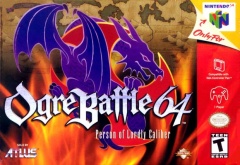 Ogre Battle 64: Person of Lordly Caliber is a mixed game, and has had mixed reviews. Some hold it as the holy grail of RPG/Strategy gaming, while others find it about as entertaining as a box of rocks.
Ogre Battle 64: Person of Lordly Caliber is a mixed game, and has had mixed reviews. Some hold it as the holy grail of RPG/Strategy gaming, while others find it about as entertaining as a box of rocks.
I’m of the former. When I saw this game in Nintendo Power, and read about it, it was all new to me. I never played its SNES predecessor. But it looked so awesome. Being an RPG fan, and desperately wanting a reason to play my Nintendo 64 other than to play Super Smash Bros. or Star Fox. The game Quest 64 left a terrible taste in my mouth and made me desperately want a Playstation for some good RPG games.
Read moreMarch 29, 2010 by Steve
 So as I'm moving through my Steambacklog, my next games are the adventure duo Ben There, Dan That! andits sequel Time Gentlemen, Please! Both are old-school 2d adventuregames, harking back to classics such as Maniac Mansion, Loom, MonkeyIsland and Sam & Max (admittedly, none of which I have playedaside from the free Sam & Max episode on Steam).
So as I'm moving through my Steambacklog, my next games are the adventure duo Ben There, Dan That! andits sequel Time Gentlemen, Please! Both are old-school 2d adventuregames, harking back to classics such as Maniac Mansion, Loom, MonkeyIsland and Sam & Max (admittedly, none of which I have playedaside from the free Sam & Max episode on Steam).
In case you aren't familiar with the PCadventure game genre, they're dialogue-heavy puzzle/detective gamesof a sort. You walk around, talk to people, pick things up, interactwith objects and generally figure out ways to progress to your nextor overall objective. It's generally very simple to play, notrequiring twitch skills or muscle memory like most modern games andcan be taken at whatever pace you wish. The humor of the games areby far their biggest draw, with large amounts of clever,lighthearted, endearing dialogue. Of course, then the dialogue isthe main draw of the genre and allows it to stand out over say, anelectronic version of Clue. Other significant factors towards thefinal product include ambience, intelligent pacing and a basic yeteffective control scheme. The genre as a whole has a fairly rabiddedicated fanbase. This is in contrast to the majority of the gamingworld, who doesn't even know that the genre exists.
Read moreMarch 26, 2010 by Greg Noe
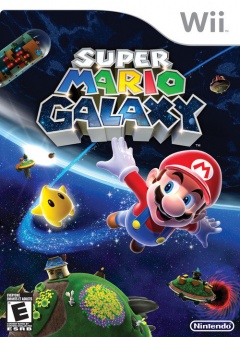 I loved Super Mario 64. It was the first game I ever played on what isone of my favorite consoles, and my memories of the game have stuckwith me to this day. The running, the jumping, the exploration of hugelevels, it was incredible. Mario made the best transition to 3D ever,well, until Ocarina of Timecame around. The next 3D Mario iteration was Super Mario Sunshine,which I was less then enthused about. I'm not sure if it was the waterpack gimmick or what, but I was never convinced that it would be worthplaying. Nintendo has finally delivered its third true 3D Mario game(well, two and a half years ago) with Super Mario Galaxy. While it is almost unrecognizable in terms of what a Mario game should be like, it plays just like Mario 64 did 14 years ago: awesomely.
I loved Super Mario 64. It was the first game I ever played on what isone of my favorite consoles, and my memories of the game have stuckwith me to this day. The running, the jumping, the exploration of hugelevels, it was incredible. Mario made the best transition to 3D ever,well, until Ocarina of Timecame around. The next 3D Mario iteration was Super Mario Sunshine,which I was less then enthused about. I'm not sure if it was the waterpack gimmick or what, but I was never convinced that it would be worthplaying. Nintendo has finally delivered its third true 3D Mario game(well, two and a half years ago) with Super Mario Galaxy. While it is almost unrecognizable in terms of what a Mario game should be like, it plays just like Mario 64 did 14 years ago: awesomely.
Galaxy's gimmick is that instead of featuring one giant, flat plane, each world is made up of small, Little Prince-likeplanets and objects. Gravity and physics are now Mario's biggestfriend and foe, as you're constantly being challenged in new ways tojump and explore. I love games like Braid and Portal that challenge me to think and play different, Super Mario Galaxy joins that elite group, in my opinion.
SuperMario Galaxy 2 is due in less than two months, and it'll probably bethe first Wii game I buy at launch in over three years. I'd love tohave a first hour review of that game at launch (hint, hint, Nintendo),but I've got a first hour review of this game also on the back burner. Here's my full review of Super Mario Galaxy. I collected all 120 starsin the game which took me about 25-30 hours.
March 17, 2010 by Steve
 Here we have Mirror's Edge, a first-person platformer of sorts, released in late 2008/early 2009 by DICE/EA. I've been interested in the game for a while, starting from its strong marketing campaign, so I jumped on the chance to play it recently.
Here we have Mirror's Edge, a first-person platformer of sorts, released in late 2008/early 2009 by DICE/EA. I've been interested in the game for a while, starting from its strong marketing campaign, so I jumped on the chance to play it recently.
It can be briefly summarized that in Mirror's Edge, you are a runner, tasked to transfer information between groups looking to avoid the surveillance of an overbearing government and its allies. As escaping capture is of utmost importance, runners do most of their travel on free outdoor environments, especially rooftops. Thus the gameplay is largely parkour-based, emphasizing proper use of momentum, speed and techniques to accomplish goals. At its best, this leads to a smooth, sublime experience, reminiscent of games like Jet Set Radio, Shadow of the Colossus, NiGHTS, and the original Prince of Persia. Mirror's Edge takes the player further into that experience, locking you to a first-person view with constant reminders of your physical struggles with and against the forces of gravity and objects in your world.
Read moreMarch 15, 2010 by Greg Noe
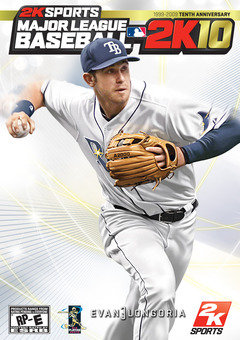 Another year, another sports game. Gamers hear this every few months when the newest Madden is coming out, or the next iteration in a 2K series, or even for the Tiger Woods series. Sure, you updated the roster, but what did you really spend the last 12 months on? That is the eternal question for series with annual updates, and it's always one someone is forced to answer.
Another year, another sports game. Gamers hear this every few months when the newest Madden is coming out, or the next iteration in a 2K series, or even for the Tiger Woods series. Sure, you updated the roster, but what did you really spend the last 12 months on? That is the eternal question for series with annual updates, and it's always one someone is forced to answer.
For 2K Sports' MLB series, 2009 was a rough year. The series was switching developers and reactions from the fanbase was generally bad. With Sony's rival series, The Show, growing stronger and stronger with every iteration, it was not a good year to take two steps back. 2K and Visual Concepts desperately needed to show that they still worth the MLB license they paid for: 2K10 needed to be the Comeback Player of the Year. If you believe Metacritic, they have definitely improved. 2K9 has a metascore of 64 with a user score of only 5.2, whereas 2K10 has a metascore of 76 but even more importantly, a user score of 8.0. The MLB 2K series seems to be back on the right track.
But I never played a previous iteration of the series, let alone 2K9, so I'm coming into this season as a rookie. I'm still expecting a lot though, my favorite baseball games are more arcadey, like Base Wars or the Ken Griffey Jr. series. Those games were just pure fun and the gameplay was great not because it was great baseball, but because it was a great video game. MLB 2K10, however, is realistic and trying to not let you realize that it is a video game. Quite a bit different than what I'm used to.
So here's my full review of MLB 2K10, this was a review copy provided to me by 2K Games. You can see read my "first hour review" of the game that actually follows me through about the first 10 hours of the game.
March 10, 2010 by Paul Eastwood
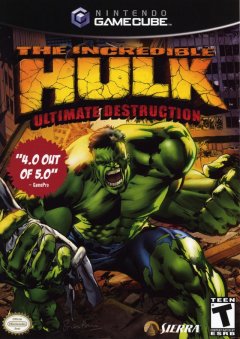 "Comic book video game." Maybe not the most successful four-word combination in the history of the world. But you can't blame them for trying, right? What could be cooler than playing as your favorite super-hero? The premise of Ultimate Destruction is that you play as the Hulk, and the Hulk smashes things. And although there's more to the game than that, smashing things is the basis of the gameplay, and guess what. It's fun.
"Comic book video game." Maybe not the most successful four-word combination in the history of the world. But you can't blame them for trying, right? What could be cooler than playing as your favorite super-hero? The premise of Ultimate Destruction is that you play as the Hulk, and the Hulk smashes things. And although there's more to the game than that, smashing things is the basis of the gameplay, and guess what. It's fun.March 3, 2010 by Michael T
Tatsunoko vs. Capcom: Ultimate All-Stars is the latest installment in the crossover series developed by Eighting and published by Capcom. Originally released in Japan more than a year ago (Dec 11, 2008), Tatsunoko vs. Capcom is finally making it's stateside debut January 26th, 2010.
You may be asking yourself, "Who the heck are these Tatsunoko characters?". I myself am asking this same question as I venture into this unknown universe. To my current knowledge, it is basically one of the grandfather anime production studios that really took off in the 80s and early 90s in Japan. Most of their work made it overseas with the likes of Samarai Pizza Cats, G-Force, and Robotech. If you grew up with cartoons in the 90s, there is a chance you will run across some familiar faces here (though you may have forgotten their names).
Capcom took a huge gamble bringing such an unknown universe stateside. To put the odds in their favor, the game has gained a few critical changes. First off, online match making has been included. Secondly, at the cost of losing one character from the original Japanese game due to licensing issues (see Hakushon Daimaō), Capcom has graciously added five new playable characters to the international version of the game.
This game was never originally planned to make it over here. I was able to play the title while I was over in Japan a year ago and was super excited to hear Capcom was putting so much effort into bringing it overseas. The game definitely warrants a purchase and fills the empty void of 2D fighters (with online) on the Wii. Hopefully word gets out about this game because I have a feeling it's going to be an uphill battle. I've lived in Japan for two years and I still don't know who half these Tatsunoko characters are.
February 26, 2010 by Greg Noe
We finish off our second annual indie games month with Gratuitous Space Battles, an epic space battle simulator from Positech Games. During our first independent games month last year, we featured Kudos 2, a life simulator also created by the one man team of Cliff Harris at Positech Games. This guy likes his simulators, whether they're of space, life, or Democracy, but Gratuitous Space Battles is a seriously awesome game.February 22, 2010 by Mike in Omaha
Simple yet complex? Possibly. Simply complex? Not quite right. I know it’s here somewhere and I think you get the point. L!ght Deluxe is a delightfully simple puzzle game from a new-to-me Indie Developer: Nemo Games. Looking at their website, it would appear that L!ght Deluxe is their first, or perhaps their only game. While the game definitely feels like an early effort, it shows promise and offers some interesting aspects to its gameplay.February 19, 2010 by Greg Noe
The sequel to the original BioShock has finally arrived, and boy, is it good! BioShock 2 returns the player to Rapture, the underwater city dreamed up by Objectivist Andrew Ryan. Many gamers were skeptical of the need for a sequel, myself included, but developer 2K Marin made me a believer.February 8, 2010 by Steve
Our second entry in this indie game month is a tower defense game by Studio Eres entitled Immortal Defense. I use the phrase "tower defense" lightly here, as while marketed as such, (Immortal Defense – a Tower Defense game), the creators only borrowed the genre basics and strived for much more than tower defense game #481.February 3, 2010 by Paul Eastwood
The Legend of Zelda: Spirit Tracks is the latest in the revered Legend of Zelda series. I doubt anyone needs an introduction to this series, so I won't give one.February 1, 2010 by Greg Noe
Zombie games are gaming's latest craze gone wild. With the popularity of zombie shooter Left 4 Dead at its peak, Call of Duty: World at War featuring a Nazi zombie mode, and old classics like Zombies Ate My Neighbors being re-released on the Virtual Console, a zombie outbreak is as ripe of setting as ever. Independent developer Sean Maher has brought the classic hobby of mowing down zombies to the iPhone now with Dead Panic, a tactical zombie shooter. Dead Panic is light on story, but heavy on difficult scenarios for your soldiers to survive. The premise is simple: strategically place your soldiers, and let loose horde.January 25, 2010 by Mike in Omaha
Heavenly Sword is the latest PS3 exclusive title from developers Ninja Theory. They are a relatively new and smaller development house based in Cambridge, England. Originally founded under the name Just Add Monsters, their only previous project was an unrelated original Xbox exclusive entitled Kung Fu Chaos. Released in 2007, Heavenly Sword was hyped as displaying an example of what the PS3 was truly capable of.January 15, 2010 by Greg Noe
Back in 2003, I played a bit of Star Wars: Knights of the Old Republic on the PC when it was released. It was college, so everybody was doing it, but for whatever reason, I only played a few hours. In 2009, I played the first hour of the game and rediscovered a gem. I loved Jade Empire and Mass Effect, but here was their older brother: slower paced and much more heavily based in the D20 rule set. It seemed like it wouldn't be possible to take the step backward from those action heavy games to Knights of the Old Republic, but after playing the first hour, I had to give it a try again.November 25, 2009 by Mike in Omaha
Jumper: Griffin's Story is a video game spinoff of a movie that was based on a novel by author Steven Gould. Yes, you read that right. It was developed by an Aussie studio called RedTribe, famous for such megahits as Looney Tunes: Acme Arsenal and Space Chimps. The movie and novel follow the life of a young man named David Rice as he grows up and eventually realizes he has the ability to teleport. At first it’s a life saving surprise, but over time David starts to use his ability to his advantage. He travels the globe and "accumulates" vast riches. However, his activities don’t go unnoticed. In the movie, we are introduced to a secret society of "Paladins"; men whose job it is to hunt down and kill those with the ability to teleport, also known as Jumpers. It isn’t long before the Paladins take an interest in David.November 16, 2009 by Mike in Omaha
Terminator Salvation is the recent adaptation of the McG helmed latest installment in the Terminator movie franchise. The game was developed by Halcyon Games with Grin Entertainment, the same company known for pumping out some of the years most underwhelming licensed properties and sequels, including Wanted: Weapons of Fate (review forthcoming) and a 3-D re-imagining of the classic Capcom game, Bionic Commando.November 9, 2009 by Greg Noe
It can be frustrating when your current favorite series releases a spin-off on a platform you don't own; this has happened to me before with Metal Gear Acid on the PSP, and now it happens again with Mass Effect Galaxy on the iPhone. Considering the game only costs three dollars, the barrier to playing is either cough up $200 for an iPod Touch or try to find someone who will give up their Precious for a few hours. I managed to convince someone of the latter, and the portable action RPG is finally in my hands.October 4, 2009 by Greg Noe
Professional puzzle-solver and tea lover Professor Hershel Layton and young Luke, his apprentice, are back to solving the ultimate mystery in Professor Layton and the Diabolical Box, the sequel to 2008's Curious Village. The game plays as a Myst-like point-and-click with brain-teasers thrown in every couple of minutes; and not the random, bumbling puzzles of Myst, but random, Mensa head-scratchers that will have you reaching for the nearest bottle of headache medicine. Diabolical Box is not just about solving puzzle after puzzle, however, there's a series of unsolved mysteries at hand along with a big cast of characters to help and hinder along the way. The game is chock full of wit and charm, and it is truly hard to put down.August 28, 2009 by Greg Noe
Peggle: Dual Shot is the Nintendo DS port of the popular puzzle-casual game, Peggle. It was released early this year and is a compilation of both Peggle and Peggle Nights. Peggle has appeared on a variety of platforms, but made it big when a themed demo of it was released with The Orange Box. The gameplay of Peggle is pretty simple, it's a bit like Pachinko, where you shoot/drop balls from the top of screen and watch them bounce off pegs (Peggles). Yeah, that's really about it, but if you know anything about the Japanese and their Pachinko, you know they can be addicted, and so will you if you pick up Peggle.August 18, 2009 by Greg Noe
Hitman: Blood Money is a stealth action game for the Xbox 360, Xbox, PlayStation 2, and Windows. It's the fourth game in the Hitman series and the last to come out. I will admit, I was influenced in playing this game after seeing the movie. I think that is probably the first time a film adaptation has done that, pretty special considering that's one of their main reasons for existence. I had never played a Hitman game before, and I will admit, I really enjoyed it. It's almost a sandbox game considering everything you can do, and no two gamers will play it the same way. What's nice about Blood Money is that someone without any experience with the series can come in and enjoy it. So maybe this review will convince you to check out the game like the movie did for me.August 6, 2009 by Greg Noe
BioShock is a first-person shooter released in 2007 for Windows, Xbox 360, and PlayStation 3. Many moons back, I reviewed the first hour of BioShock in a series of Xbox 360 reviews I did while borrowing my friend's system. I enjoyed the game immensely, but sadly, it was the one game I borrowed that I didn't beat (I even wasted my time playing all the way through Assassin's Creed). I'm not sure why I didn't choose to play through it, though I think I was actually scared. BioShock is a dystopian game set underwater with tons of crazed lunatics running around with masks on, not to mention its the spiritual successor to System Shock 2, considered one of the scariest games of all time by fans. So my wits got the better of me and I set it aside until now, and with my own Xbox 360 on the shelf and a copy of BioShock in my hand, I headed back into Rapture.July 1, 2009 by Greg Noe
SimCity Creator is a city-building game for the Nintendo DS. The game is known as SimCity DS 2 in Japan, but EA decided to rebrand it as SimCity Creator to align it with the Wii game of the same name that was also released in September 2008 (supposedly, the first SimCity DS, so they were also trying to break out of that stigma). So please, take note that this review is of the DS game and not the Wii game, while both SimCity games, they seem different enough to definitely qualify as unique games.June 28, 2009 by Greg Noe
Sacred 2: Fallen Angel is a hack and slash role playing game for the Xbox 360, Windows, and PlayStation 3. I had never even heard of the Sacred series before playing this game, and if you haven't either, think Diablo. Though it is definitely a brighter game if anything. Sacred 2 features a seamless open world with tons of action. It was released last year on the PC and about a month ago on the consoles.June 22, 2009 by Greg Noe
Grand Theft Auto: Chinatown Wars is the newest Grand Theft Auto game and the first for the Nintendo DS. It's an ambitious game (aren't all the GTA games though?), the entire Liberty City crammed into a tiny little cartridge, complete with a full story and living, breathing world. I will tell you right now that Rockstar really pulled it off.April 30, 2009 by Greg Noe
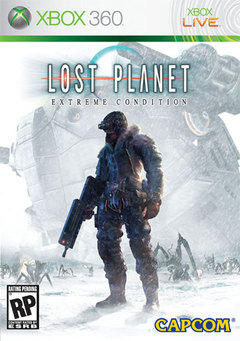 Lost Planet: Extreme Condition is a third-person shooter set on the eternal winter world of E.D.N. III. It was released in 2007 for the Xbox 360 and PC and the PlayStation 3 got a port in 2008. I reviewed the first hour of the game a few months ago and loved it. The game featured a great blend of action, atmosphere, and adventure. I definitely enjoy third-person perspective games typically more than first-person, the controls are usually a bit more unforgiving but I seem to get a much better context of the world around me. Lost Planet is no exception.
Lost Planet: Extreme Condition is a third-person shooter set on the eternal winter world of E.D.N. III. It was released in 2007 for the Xbox 360 and PC and the PlayStation 3 got a port in 2008. I reviewed the first hour of the game a few months ago and loved it. The game featured a great blend of action, atmosphere, and adventure. I definitely enjoy third-person perspective games typically more than first-person, the controls are usually a bit more unforgiving but I seem to get a much better context of the world around me. Lost Planet is no exception.
I honestly had low hopes for this game, fighting bugs on an ice planet? Sounds lame; sounds like it's been done a hundred times before. Mechs? Been there, blown up that. In reality, the game isn't much more than this, but it's action packed and you will be having fun. So there's mechs and ice and bugs, but all together, it makes for something awesome. Let's get into the full review of the Xbox 360 version of Lost Planet.
April 23, 2009 by Greg Noe
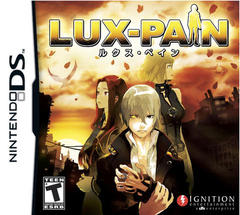 Lux-Pain is a visual novel game for the Nintendo DS. Novel is an accurate description of this game's length and amount of reading. Lux-Pain took me about 21 hours to read/play through and compared to the other popular heavy reading games on the DS like Phoenix Wright or Hotel Dusk, has much less interactive gameplay and unfortunately, a much less polished translation. Visual novels are a big genre in Japan, but have never really made the transition overseas outside of the Ace Attorney series. Honestly the big difference is that Ace Attorney gets the localization it deserves whereas Lux-Pain's seems rushed and bland.
Lux-Pain is a visual novel game for the Nintendo DS. Novel is an accurate description of this game's length and amount of reading. Lux-Pain took me about 21 hours to read/play through and compared to the other popular heavy reading games on the DS like Phoenix Wright or Hotel Dusk, has much less interactive gameplay and unfortunately, a much less polished translation. Visual novels are a big genre in Japan, but have never really made the transition overseas outside of the Ace Attorney series. Honestly the big difference is that Ace Attorney gets the localization it deserves whereas Lux-Pain's seems rushed and bland.
Anyways, Lux-Pain is not all bad. If you're a fan of this genre and like mysteries, this is probably right up your alley. It has a big story and starts off as a delicious cross between Persona 3, Phoenix Wright, and Heroes. It's a pretty serious game but has some great art and actually tons of voice acting. Lux-Pain offers a lot... if a bit scattered about. Let's get to my full review.
April 13, 2009 by Greg Noe
 World of Goo is a physics based puzzle game available for Windows, Linux, OS X, and WiiWare. I reviewed the first hour of the game a few months ago and just kept on playing it until it was unfortunately over. World of Goo was one of the highlights during February's indie game month at the First Hour, and as Magic Toy Chest developers, Graduate Games, told me, "it's tough following World of Goo." That it is. The game has a ton of charm, wit, and atmosphere to carry it over about 50 levels. Each one is unique and will leave you wanting more, and while I feel the story is a bit overdone, this is a brilliant game. Let's get into it.
World of Goo is a physics based puzzle game available for Windows, Linux, OS X, and WiiWare. I reviewed the first hour of the game a few months ago and just kept on playing it until it was unfortunately over. World of Goo was one of the highlights during February's indie game month at the First Hour, and as Magic Toy Chest developers, Graduate Games, told me, "it's tough following World of Goo." That it is. The game has a ton of charm, wit, and atmosphere to carry it over about 50 levels. Each one is unique and will leave you wanting more, and while I feel the story is a bit overdone, this is a brilliant game. Let's get into it.
April 7, 2009 by Greg Noe
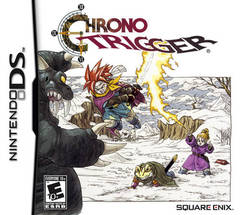 Chrono Trigger for the Nintendo DS is the second port of this classic Super Nintendo role-playing game. You guide a group of time-traveling heroes through different time periods to save the world from the alien parasite, Lavos. I'll get my biases out of the way right now and say that the Super Nintendo version is my favorite game of all time. Out of the hundreds of games I've played, Chrono Trigger stands as the undisputed number one. So I had very high expectations for the 2008 portable port of the 1995 original, so let's just get to my review to see if it lives up to the hype... and see if the game has stood the test of time.
Chrono Trigger for the Nintendo DS is the second port of this classic Super Nintendo role-playing game. You guide a group of time-traveling heroes through different time periods to save the world from the alien parasite, Lavos. I'll get my biases out of the way right now and say that the Super Nintendo version is my favorite game of all time. Out of the hundreds of games I've played, Chrono Trigger stands as the undisputed number one. So I had very high expectations for the 2008 portable port of the 1995 original, so let's just get to my review to see if it lives up to the hype... and see if the game has stood the test of time.
January 28, 2009 by Greg Noe
 Kung Fu Panda was a free game with my Xbox 360. When was the last time you got games with your system (yes, games, as Lego Indiana Jones was packed in too)? The Wii restarted a great trend by including Wii Sports, and sure, it was the Xbox 360 Holiday Bundle, but it's so nice to have something to play when you first plug it in. Did you know that I got three(!) games included with my Super Nintendo? Super Mario World, Super Mario Kart, and Super Mario All-Stars. It was the single greatest day of my childhood.
Kung Fu Panda was a free game with my Xbox 360. When was the last time you got games with your system (yes, games, as Lego Indiana Jones was packed in too)? The Wii restarted a great trend by including Wii Sports, and sure, it was the Xbox 360 Holiday Bundle, but it's so nice to have something to play when you first plug it in. Did you know that I got three(!) games included with my Super Nintendo? Super Mario World, Super Mario Kart, and Super Mario All-Stars. It was the single greatest day of my childhood.
So Kung Fu Panda is the new video game based off the movie of the same name. Have you seen it? If so, you will probably enjoy this game for as long as it lasts (not that long). If you haven't seen it, you probably won't appreciate the humor it has to offer. That is, until you see the movie. Let's just get into my review of Kung Fu Panda for the Xbox 360, all score are out of 10.
January 24, 2009 by Greg Noe
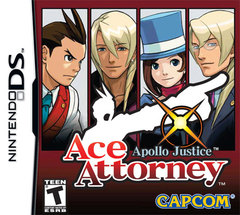 Apollo Justice: Ace Attorney is the latest Ace Attorney game for the Nintendo DS. It's the fourth game in the series and the first to star our new hero, Apollo Justice. This has been a sensitive point for fans as the series has focused on Phoenix Wright for three games, and all of a sudden Capcom decides to go in a different direction. Well, if you've skipped Apollo Justice because of this, you will soon find out you have a game you must play.
Apollo Justice: Ace Attorney is the latest Ace Attorney game for the Nintendo DS. It's the fourth game in the series and the first to star our new hero, Apollo Justice. This has been a sensitive point for fans as the series has focused on Phoenix Wright for three games, and all of a sudden Capcom decides to go in a different direction. Well, if you've skipped Apollo Justice because of this, you will soon find out you have a game you must play.
I previously reviewed the third Ace Attorney game, Trials and Tribulations, here last year. Check it out if you want to see where the series left off and a basic introduction to the gameplay featured in the games. I'm actually really excited for the next game in the series... well, a new series technically. Perfect Prosecutor: Miles Edgeworth is getting released in Japan in a few months. Courtroom drama and comedy from the other side of the room!
Let's get on with my review of Apollo Justice: Ace Attorney, all scores are out of 10.
January 21, 2009 by Greg Noe
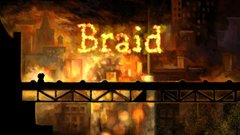 Braid is an extremely unique Xbox Live Arcade platformer where you're able to control time. It starts out kind of like Prince of Persia: The Sands of Time, allowing you to just reverse time if you die, but it gradually introduces more and more insane and awesome concepts that will have your mind totally boggled by the end. Braid is only available on the Xbox 360 right now, but it should get a PC release in the next few months. Buy this game whatever way you can. Geez, I'm already highly recommending it and we haven't even gotten to the review yet. Let's do it. All scores are out of 10.
Braid is an extremely unique Xbox Live Arcade platformer where you're able to control time. It starts out kind of like Prince of Persia: The Sands of Time, allowing you to just reverse time if you die, but it gradually introduces more and more insane and awesome concepts that will have your mind totally boggled by the end. Braid is only available on the Xbox 360 right now, but it should get a PC release in the next few months. Buy this game whatever way you can. Geez, I'm already highly recommending it and we haven't even gotten to the review yet. Let's do it. All scores are out of 10.
January 4, 2009 by Greg Noe
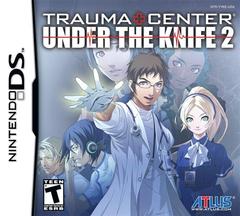 Trauma Center: Under the Knife 2 is the direct sequel to one of my favorite Nintendo DS games Before I played the original Trauma Center, I had never understood the real appeal of the DS. That game, along with Kirby Canvas Curse, demonstrated what the system was really capable of and how much fun it could be. So when the sequel was released, I put it at the top of my list to play. I actually beat this game about two months ago, but things have been pretty busy so I haven't been able to write the review until now.
Trauma Center: Under the Knife 2 is the direct sequel to one of my favorite Nintendo DS games Before I played the original Trauma Center, I had never understood the real appeal of the DS. That game, along with Kirby Canvas Curse, demonstrated what the system was really capable of and how much fun it could be. So when the sequel was released, I put it at the top of my list to play. I actually beat this game about two months ago, but things have been pretty busy so I haven't been able to write the review until now.
The Trauma Center series pits you as a highly skilled surgeon working for Caduceus, a well funded research facility. The games are highly linear, with tons of text, so if you're looking for a straight surgery simulator, you'll have to wade through a lot of cruft to get to it. If you can put up with much too serious characters in contrived situations, then you will be rewarded with excellent and difficult gameplay. Let's get to my review of Trauma Center 2.
December 17, 2008 by Greg Noe
 Pikmin is the brainchild of Shigeru Miyamoto, released for the GameCube in 2001. It's a real-time strategy game starring a horde of plant creatures and a tiny space traveler. You control Captain Olimar directly, leading around the mini pikmin that come in three different colors. The goal is to collect 30 ship parts in 30 days. Now I am generally annoyed by timed games, but I finished it on about my 20th day with every piece, so don't feel rushed for time. The pikmin serve as Olimar's willing slaves as they carry each piece back to his ship while sacrificing their lives in front of giant ladybugs and fire breathing snouts. It's kind of sad when you think about it. Well, can't dawdle on that too much. Pikmin 2 was also released for the GameCube and Pikmin 3 is announced for the Wii. Olimar rolls on with his minions in tow.
Pikmin is the brainchild of Shigeru Miyamoto, released for the GameCube in 2001. It's a real-time strategy game starring a horde of plant creatures and a tiny space traveler. You control Captain Olimar directly, leading around the mini pikmin that come in three different colors. The goal is to collect 30 ship parts in 30 days. Now I am generally annoyed by timed games, but I finished it on about my 20th day with every piece, so don't feel rushed for time. The pikmin serve as Olimar's willing slaves as they carry each piece back to his ship while sacrificing their lives in front of giant ladybugs and fire breathing snouts. It's kind of sad when you think about it. Well, can't dawdle on that too much. Pikmin 2 was also released for the GameCube and Pikmin 3 is announced for the Wii. Olimar rolls on with his minions in tow.
November 27, 2008 by Greg Noe
 Mother 3 is the sequel to the Super Nintendo RPG, Earthbound. It was released in 2006, but only in Japan. Being the successor to such a popular game, and no hope in sight of Nintendo of America releasing it, fans took it upon themselves to translate it. It took a few years, but the team released their translation patch in October and fans of the series, like me, pounced on it. I won't say I tore through the game, but I definitely dropped all other games to play it.
Mother 3 is the sequel to the Super Nintendo RPG, Earthbound. It was released in 2006, but only in Japan. Being the successor to such a popular game, and no hope in sight of Nintendo of America releasing it, fans took it upon themselves to translate it. It took a few years, but the team released their translation patch in October and fans of the series, like me, pounced on it. I won't say I tore through the game, but I definitely dropped all other games to play it.
I was a big fan of Earthbound, so playing this was a no-brainer. It's just unfortunate that fans had to rely on an unofficial translation to play it. No one really knows what Nintendo of America's reasons were for not releasing an English language version, but honestly, they missed their opportunity. This game is brilliant, including the translation. Let's get to the meat. All scores are out of 10.
For a review on just the first hour, check out my Mother 3 review at The First Hour.
November 6, 2008 by Greg Noe
 Spore was released a few months ago to much hype and anticipation. It was the game to end all simulators, featuring gameplay from the individual cell level to the entire universe. Will Wright and crew demoed the game more than two and a half years ago in what seemed to be a ready to release state. But the game would be delayed, and delayed, and delayed again, leading us to a September 2008 release. Spore was my must play game of the year, and play it I did. Was it everything it was supposed to be cracked up to be? Definitely not. Was it a disappointment in my eyes? Definitely yes. Please Greg, tell us why.
Spore was released a few months ago to much hype and anticipation. It was the game to end all simulators, featuring gameplay from the individual cell level to the entire universe. Will Wright and crew demoed the game more than two and a half years ago in what seemed to be a ready to release state. But the game would be delayed, and delayed, and delayed again, leading us to a September 2008 release. Spore was my must play game of the year, and play it I did. Was it everything it was supposed to be cracked up to be? Definitely not. Was it a disappointment in my eyes? Definitely yes. Please Greg, tell us why.
October 29, 2008 by Greg Noe
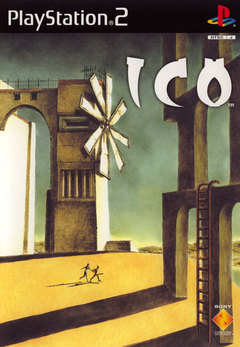 Ico is an adventure game in the greatest sense of the word. It was released on the PlayStation 2 back in 2001 and has a decent fanbase, helped by a sort of spiritual prequel in Shadow of the Colossus released in 2005. Ico is considered a prime example of video games being art, with many pointing at its stylistic graphics, lack of interface, and engrossing story as highlights. The game sold best in Europe, part of which I attribute to bad box-art syndrome. Check out the Japanese/European cover in the infobox, and here's the North American cover. I honestly don't know who approves this crap.
Ico is an adventure game in the greatest sense of the word. It was released on the PlayStation 2 back in 2001 and has a decent fanbase, helped by a sort of spiritual prequel in Shadow of the Colossus released in 2005. Ico is considered a prime example of video games being art, with many pointing at its stylistic graphics, lack of interface, and engrossing story as highlights. The game sold best in Europe, part of which I attribute to bad box-art syndrome. Check out the Japanese/European cover in the infobox, and here's the North American cover. I honestly don't know who approves this crap.
For my review on just the first hour, please see my Ico review at The First Hour.
June 2, 2008 by Greg Noe
 Hotel Dusk: Room 215 is a point and click adventure game for the Nintendo DS. I reviewed the first hour of the game a few months ago and awarded the game a 4 out of 10 for its never-ending dialogue and slow gameplay. But that's just one hour of 30, how will the complete package turn out? Note the scores are out of 10.
Hotel Dusk: Room 215 is a point and click adventure game for the Nintendo DS. I reviewed the first hour of the game a few months ago and awarded the game a 4 out of 10 for its never-ending dialogue and slow gameplay. But that's just one hour of 30, how will the complete package turn out? Note the scores are out of 10.
For my review on just the first hour, please see my Hotel Dusk: Room 215 review at The First Hour.
May 27, 2008 by Greg Noe
 Ninja Gaiden Dragon Sword is a new action game for the Nintendo DS. It features 3D graphics with pre-rendered backgrounds and the story is set six months after the events in Ninja Gaiden for the Xbox. I recently posted my first hour review of Ninja Gaiden and Ninja Gaiden and was inspired to try out the newest offering in the series. This was an excellent decision because Dragon Sword was a great game and plays perfectly on the Nintendo DS. Read on for the full review, but note, Ninja Gaiden Dragon Sword is not to be confused with Ninja Gaiden II: The Dark Sword of Chaos for the NES or Ninja Gaiden II for the Xbox 360.
Ninja Gaiden Dragon Sword is a new action game for the Nintendo DS. It features 3D graphics with pre-rendered backgrounds and the story is set six months after the events in Ninja Gaiden for the Xbox. I recently posted my first hour review of Ninja Gaiden and Ninja Gaiden and was inspired to try out the newest offering in the series. This was an excellent decision because Dragon Sword was a great game and plays perfectly on the Nintendo DS. Read on for the full review, but note, Ninja Gaiden Dragon Sword is not to be confused with Ninja Gaiden II: The Dark Sword of Chaos for the NES or Ninja Gaiden II for the Xbox 360.
April 21, 2008 by Greg Noe
 Rune Factory is the "Harvest Moon with swords." This is still the craziest thing I have ever heard and I just beat the stinking game! If you would have told me 10 years ago that the Harvest Moon game I loved would one day feature swords and magic and monsters and bosses, I would have thought that was pretty crazy. Of course, the series has evolved a lot since that first game and Rune Factory is just the latest one off that Natsume has been experimenting with the last few years. I think they were successful with a fantasy Harvest Moon though, but there are some problems. Let's just get right into the good and the bad.
Rune Factory is the "Harvest Moon with swords." This is still the craziest thing I have ever heard and I just beat the stinking game! If you would have told me 10 years ago that the Harvest Moon game I loved would one day feature swords and magic and monsters and bosses, I would have thought that was pretty crazy. Of course, the series has evolved a lot since that first game and Rune Factory is just the latest one off that Natsume has been experimenting with the last few years. I think they were successful with a fantasy Harvest Moon though, but there are some problems. Let's just get right into the good and the bad.
April 17, 2008 by Greg Noe
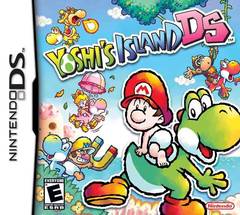 Yoshi's Island DS is the sequel to the greatest 2D platformer of all time, Super Mario World 2: Yoshi's Island. In my mind, this is a super tall order for the game to live up to, and unfortunately it doesn't, but the DS sequel is still a great game on its own and is definitely one of the best platformers on the system. If you've played the original you will be right at home with Yoshi's Island DS, as the basic gameplay is exactly the same as it was 13 years ago. This is a good thing but they also spent some time adding a few things here and there.
Yoshi's Island DS is the sequel to the greatest 2D platformer of all time, Super Mario World 2: Yoshi's Island. In my mind, this is a super tall order for the game to live up to, and unfortunately it doesn't, but the DS sequel is still a great game on its own and is definitely one of the best platformers on the system. If you've played the original you will be right at home with Yoshi's Island DS, as the basic gameplay is exactly the same as it was 13 years ago. This is a good thing but they also spent some time adding a few things here and there.
And maybe it's just me, but this game is hard, harder than the original. Especially if you plan to collect all the points in each level, which I did a few years back for the SNES game, and am currently attempting now for Yoshi's Island DS. Let's just say I need to wear a wrist strap so I don't chuck my DS across the room. Let's get to the review.
April 16, 2008 by Greg Noe
 Geometry Wars: Galaxies is a multi-directional shooter and in my opinion, the ultimate descendant of the classic arcade game, Asteroids. This is a full retail game that expands on Geometry Wars and Retro Evolved that appeared as bonus games and on Xbox Live Arcade. It was released on the Nintendo DS and the Wii, and I played it for the DS. There are a ton of levels and there is so much more variety than just the familiar giant box with enemies appearing from the corner. I was really impressed when I encountered my first really small level and was forced to basically hole up in a corner and defend myself for a few minutes.
Geometry Wars: Galaxies is a multi-directional shooter and in my opinion, the ultimate descendant of the classic arcade game, Asteroids. This is a full retail game that expands on Geometry Wars and Retro Evolved that appeared as bonus games and on Xbox Live Arcade. It was released on the Nintendo DS and the Wii, and I played it for the DS. There are a ton of levels and there is so much more variety than just the familiar giant box with enemies appearing from the corner. I was really impressed when I encountered my first really small level and was forced to basically hole up in a corner and defend myself for a few minutes.
For those unfamiliar with the series or the concept of an Asteroids clone/descendant, it's basically you against the universe in increasingly overwhelming odds. You pilot one small ship and more and more bad guys appear constantly. The enemies are color-coded and distinctly shaped, so you always have an idea how some will act and react to you. Some just float around aimlessly, others rocket at you at incredible speed kamikaze style. There are a lot of new additions from the original that make this a worthwhile playing experience.
April 1, 2008 by Greg Noe
 Professor Layton and the Curious Village is a Nintendo DS point and click adventure puzzle game. The game features 135 brain-busting puzzles that will seriously give you a headache by the game's end, but it is an incredibly rewarding experience beating them all. In between all the puzzles is a somewhat interesting story about Professor Layton and his young apprentice, Luke, exploring the village of St. Mystere and uncovering its many secrets. There's a wide cast of characters and all the art and backgrounds are hand-drawn and looks really great. There's even some voice acting thrown in that's actually good, but the real star in Professor Layton are the puzzles.
Professor Layton and the Curious Village is a Nintendo DS point and click adventure puzzle game. The game features 135 brain-busting puzzles that will seriously give you a headache by the game's end, but it is an incredibly rewarding experience beating them all. In between all the puzzles is a somewhat interesting story about Professor Layton and his young apprentice, Luke, exploring the village of St. Mystere and uncovering its many secrets. There's a wide cast of characters and all the art and backgrounds are hand-drawn and looks really great. There's even some voice acting thrown in that's actually good, but the real star in Professor Layton are the puzzles.
Within the curious village, residents will constantly offer you challenging puzzles to tackle, and clicking on certain items also triggers a puzzle from either the Professor or Luke. The puzzles range from 30 second quickies using pattern and object recognition to 30 minute Tylenol-taking nasties using advanced techniques such as shortest path, eight queens, playing card probability, and moving one giant block through a mess of smaller ones. Since there are so many puzzles, there is a ton of variety and only a few "repeats with new conditions."
None of this probably makes any sense, so let me just get to my review.
February 29, 2008 by Greg Noe
 Drawn to Life is a Nintendo DS game that takes platformers a step forward by allowing you to draw your own character among many other objects throughout the game. It also takes platformers two steps back with its awful gameplay. Before I rip into the game though, let's take a look at the product as a whole. Drawn to Life was released in September of last year and really advertised itself as a game that would allow for so much more creativity in a genre rather lacking lately. The game is targeted for children, but I'll brave anything if it interests me, and Drawn to Life definitely did.
Drawn to Life is a Nintendo DS game that takes platformers a step forward by allowing you to draw your own character among many other objects throughout the game. It also takes platformers two steps back with its awful gameplay. Before I rip into the game though, let's take a look at the product as a whole. Drawn to Life was released in September of last year and really advertised itself as a game that would allow for so much more creativity in a genre rather lacking lately. The game is targeted for children, but I'll brave anything if it interests me, and Drawn to Life definitely did.
Anyways, awful is a rather strong word but while I'm playing a game, I'm constantly thinking about its current overall score and how it's doing in the individual categories. Drawn to Life started at around a seven (a nice number, giving the game the benefit of the doubt that it is above average), drawing your own character was kind of cool, and I put a lot of work into it because I knew I'd be staring at "me" for the next few hours. Then the real game starts, and we're faced with an empty village and a whole bunch of villagers to rescue. This got me really excited because last year I played Dragon Quest Heroes: Rocket Slime, a truly stellar title that also focused on expanding a town and opening up new things as the game progresses. So I might have bumped up Drawn to Life to an eight at that point for its potential. However, the first platforming stage begins, and I was instantly able to recognize that this game is going to be painful, I'll get more into this during the gameplay portion. Between platforming levels, you wander around town doing other painfully boring stuff, more on this below during my story review. Overall, it's a constant back and forth between crap gameplay and crap story, ending in my biggest "WTF?" moment of the year.
Enough of this, straight to the scores out of 10.
February 21, 2008 by Greg Noe
 Lego Star Wars: The Complete Saga is the combination of the first two Lego Star Wars games (The Video Game and Original Trilogy) in what is an obvious attempt to sell more copies of the games and reach that same Star Wars audience that will only buy the DVDs when they're all available in one, giant box set. So basically we have all the levels from the first game, plus all the levels from the second game, plus some more (minor) stuff in case you already own the first two. I received this game for the Nintendo DS, which is essentially my platform of choice of late, and played the heck out of it for the last week and a half. And surprisingly, I loved every minute of it.
Lego Star Wars: The Complete Saga is the combination of the first two Lego Star Wars games (The Video Game and Original Trilogy) in what is an obvious attempt to sell more copies of the games and reach that same Star Wars audience that will only buy the DVDs when they're all available in one, giant box set. So basically we have all the levels from the first game, plus all the levels from the second game, plus some more (minor) stuff in case you already own the first two. I received this game for the Nintendo DS, which is essentially my platform of choice of late, and played the heck out of it for the last week and a half. And surprisingly, I loved every minute of it.
I'm not sure why it took so long for someone to realize that Legos are awesome, Star Wars is awesome, and video games are awesome, so why not put them all together. But it finally happened a few years ago and it was like my childhood fantasies were coming together for one last amazing adventure. Somehow though, I never played the first one (Episodes I-III) but got the chance to play The Original Trilogy (Episodes IV-VI). I thought the game was fun but short. The Complete Saga has allowed me to play the first game and replay the second, giving me a much more satisfying experience. It took me a solid 21.5 hours to achieve 100% completion and I'm a little sad to say goodbye. Thankfully though, Lego Indiana Jones and Lego Batman are only a few months away... Now let's get to the review!
February 9, 2008 by Greg Noe
 Phoenix Wright: Ace Attorney - Trials and Tribulations (longest game title ever?) is the final game in the Phoenix Wright trilogy, a series of defense attorney games for the Nintendo DS. If you are unfamiliar with the series, you will probably be stunned by the following description: You play as the young attorney, Phoenix Wright, in a justice system where your clients are presumed guilty until proven innocent. You are accompanied by a young woman who can channel dead spirits and murder cases are brought to court the day after the crime was committed. And finally, finger pointing and yelling "OBJECTION!" is your most powerful court room ally.
Phoenix Wright: Ace Attorney - Trials and Tribulations (longest game title ever?) is the final game in the Phoenix Wright trilogy, a series of defense attorney games for the Nintendo DS. If you are unfamiliar with the series, you will probably be stunned by the following description: You play as the young attorney, Phoenix Wright, in a justice system where your clients are presumed guilty until proven innocent. You are accompanied by a young woman who can channel dead spirits and murder cases are brought to court the day after the crime was committed. And finally, finger pointing and yelling "OBJECTION!" is your most powerful court room ally.
Ace Attorney games are broken up into two types of gameplay: the first is the actual court room, where you will argue with the prosecutor and cross-examine the incessantly lying witnesses until they crack. The second gameplay type is the on-site investigation. Phoenix Wright himself will head out to the scene of the crime (though often crimes follow him almost like he's Angela Lansbury) and perform investigations, interview witnesses and suspects, and gather evidence. If you haven't figured it out already, this game has a LOT of text. This game is so demanding on your A button I thought mine would fall out by the end. Trials and Tribulations is driven by its story, and it assumes you have played the other two when it comes to the characters and events. You don't need to have completed the previous games to beat Phoenix Wright 3, but it will be a much more satisfying experience if you have.
My category reviews should describe the game well, so read on for the scores which are out of 10.
January 14, 2008 by Greg Noe
 Mass Effect was my "must-play" game of 2007. Alas, it wasn't until 2008 that I finally got to play it. And play it I did: nearly 40 hours of gaming in 10 days is probably the most gaming I've done since Final Fantasy VIII was released (or any period of time that I played World of Warcraft). The game is not perfect, but I was engrossed the entire time and the game kept throwing surprises at me around every turn. I went in thinking I understood the game and thought I could play it the way I wanted to play it. Instead, Mass Effect played me like it was my first time saving the universe. I came out extremely satisfied and wanted to start it over again right away.
Mass Effect was my "must-play" game of 2007. Alas, it wasn't until 2008 that I finally got to play it. And play it I did: nearly 40 hours of gaming in 10 days is probably the most gaming I've done since Final Fantasy VIII was released (or any period of time that I played World of Warcraft). The game is not perfect, but I was engrossed the entire time and the game kept throwing surprises at me around every turn. I went in thinking I understood the game and thought I could play it the way I wanted to play it. Instead, Mass Effect played me like it was my first time saving the universe. I came out extremely satisfied and wanted to start it over again right away.
For my review on just the first hour, please see my Mass Effect review at The First Hour.
Bioware's epic is a combination of role-playing game and third-person shooter. Think of the best things Knights of the Old Republic has to offer and carefully mesh it with the best features of Gears of War, and you will have Mass Effect. However, the game is much more action-oriented than Knights but isn't as demanding as Gears, it really finds a perfect balance between the two that makes you wonder how they pulled it off. Geez, I don't know how I can go on without going into too much detail, so let's get right to the specifics!
January 8, 2008 by Greg Noe
 Final Fantasy XII: Revenant Wings is the direct sequel to Final Fantasy XII for the Nintendo DS. It was released late last year and was the first game I received for Christmas and thus the first game I decided to play through. Revenant Wings is essentially a real-time strategy game on the small screen, something that is not attempted very often and especially not from a company like Square Enix. They do have plenty of experience with strategy games like Final Fantasy Tactics, but surprisingly the game does not play like that at all. It's much more focused on split second decisions and fast action.
Final Fantasy XII: Revenant Wings is the direct sequel to Final Fantasy XII for the Nintendo DS. It was released late last year and was the first game I received for Christmas and thus the first game I decided to play through. Revenant Wings is essentially a real-time strategy game on the small screen, something that is not attempted very often and especially not from a company like Square Enix. They do have plenty of experience with strategy games like Final Fantasy Tactics, but surprisingly the game does not play like that at all. It's much more focused on split second decisions and fast action.
The game brings back most of the main characters from Final Fantasy XII and also integrates a few gameplay elements from its big brother. The game is also long, clocking in at around 40 hours depending on how many extra levels you want to play. This is pretty typical for a Final Fantasy game, but it seemed really long for a portable title! Thankfully though, the game is designed to be digested in small chunks, so it still works very well as a portable game. Here's the review for Final Fantasy XII: Revenant Wings (from now on this game will be called Revenant Wings and the PS2 original will be called Final Fantasy XII).
December 31, 2007 by Greg Noe
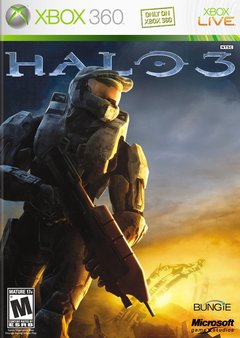 Halo 3 probably doesn't need much introduction, being one of the most hyped game of the year and the climax to one of the most popular series ever. For the unaware, Halo 3 is a first person shooter putting you in the role of Master Chief, a super soldier in super armor. The game focuses on fast action and throws hordes of enemies at you. Halo 3 also features a variety of vehicles that are actually fun to drive and add substantially to the gameplay. Let's just get straight to the review.
Halo 3 probably doesn't need much introduction, being one of the most hyped game of the year and the climax to one of the most popular series ever. For the unaware, Halo 3 is a first person shooter putting you in the role of Master Chief, a super soldier in super armor. The game focuses on fast action and throws hordes of enemies at you. Halo 3 also features a variety of vehicles that are actually fun to drive and add substantially to the gameplay. Let's just get straight to the review.
December 18, 2007 by Greg Noe
 Gears of War is a third-person shooter for the Xbox 360 and was the original poster child for Epic's new Unreal Engine 3. It's a gritty look on a post alien-ravaged Earth and its main feature is many very large linebackers hiding behind stuff and shooting guns wildly. That's my one sentence summing up, but this game is actually deeper than it seems to be. The cover system, while not completely original, is what all the combat and gameplay is built around. The game punishes you severely for run-and-gun style of play and forces you to be patient in a world of chainsaws and spiked grenades. Gears of War sold very well, but it was not until this last month that I got to play through it completely, and that I did (twice). Now let's get right into my review.
Gears of War is a third-person shooter for the Xbox 360 and was the original poster child for Epic's new Unreal Engine 3. It's a gritty look on a post alien-ravaged Earth and its main feature is many very large linebackers hiding behind stuff and shooting guns wildly. That's my one sentence summing up, but this game is actually deeper than it seems to be. The cover system, while not completely original, is what all the combat and gameplay is built around. The game punishes you severely for run-and-gun style of play and forces you to be patient in a world of chainsaws and spiked grenades. Gears of War sold very well, but it was not until this last month that I got to play through it completely, and that I did (twice). Now let's get right into my review.
December 15, 2007 by Greg Noe
 Assassin's Creed is the newest action-adventure game from Ubisoft. Since it was released about a month ago it has seen pretty good reviews and has become the fastest selling new IP since 2002 (The Getaway, seriously??). I can't argue with facts but I can't believe how many unbelievable scores this game has gotten: a 10 from Games Radar, a 9.5 from Game Informer, and 37/40 from Famitsu are just a few scores that make me go "WTF?"
Assassin's Creed is the newest action-adventure game from Ubisoft. Since it was released about a month ago it has seen pretty good reviews and has become the fastest selling new IP since 2002 (The Getaway, seriously??). I can't argue with facts but I can't believe how many unbelievable scores this game has gotten: a 10 from Games Radar, a 9.5 from Game Informer, and 37/40 from Famitsu are just a few scores that make me go "WTF?"
For my review on just the first hour, please see my Assassin's Creed review at The First Hour.
Before I defend myself and get into why this game is both incredibly awesome and incredibly horrible at the same time, let's have a little more history. Assassin's Creed is in the same vein as the recent Prince of Persia trilogy, you can run up walls, kill bad guys with your sword, and basically just do cool acrobatics. Ubisoft made a good decision giving the Prince a break and trying something a little different. Breaking away from the Prince of Persia games, Assassin's Creed gives you a giant sandbox to play around with in three giant 12th century cities. Jerusalem, Acre, and Damascus are rendered beautifully and you can tell were created meticulously and carefully. The main character, Altair, is basically a white-clad ninja in the Holy Land, so it seems like it would be really fun to dive into his stealth-killing world. What could possibly go wrong?
December 9, 2007 by Greg Noe
 I've recently had the opportunity to borrow a friend's Xbox 360 and five select games. I played the first hour of all five of those for my first hour review site, and ended up playing Call of Duty 4: Modern Warfare last. I did not stop playing until 3 am last night when I finished it. I simply could not put the game down.
I've recently had the opportunity to borrow a friend's Xbox 360 and five select games. I played the first hour of all five of those for my first hour review site, and ended up playing Call of Duty 4: Modern Warfare last. I did not stop playing until 3 am last night when I finished it. I simply could not put the game down.
I missed out on Call of Duty 1, 2, and 3, so it was kind of a wonder that I was even interested in playing this game in the first place. I gave it a chance however, and I loved it. The previous installments of Call of Duty have all taken place during World War II, which I think has been done to death. Infinity Ward instead made the correct decision to set Call of Duty 4 in our own turbulent, modern day Middle East. This makes for an ultra high-action, technology driven war experience. And this is very fun. I'm not sure how else to describe this game without creeping in on what I want to say later, so let's just get right down to it.
For my review on just the first hour, please see my Call of Duty 4 review at The First Hour.
December 6, 2007 by Greg Noe
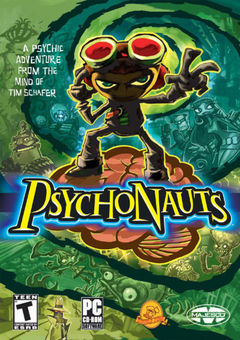 Well, it's been over a month since I beat a game, this is pretty typical the last couple of years but since I started this particular review site, it's only brought it to my attention more. I recently reviewed the first hour of Psychonauts (actually just on Monday, three days ago!) and I could not put the game down. It may have been a month since I finished a game but it's been seemingly years since I enjoyed a longer game this much. Psychonauts actually came out in 2005 and I've had it in the back of my mind ever since, and just now I realize how stupid I am for not playing it until now. The game is simply a very funny, highly original platformer. Everything comes together in a perfect storm of awesomeness for 20 hours, and at the end, you come away very satisfied.
Well, it's been over a month since I beat a game, this is pretty typical the last couple of years but since I started this particular review site, it's only brought it to my attention more. I recently reviewed the first hour of Psychonauts (actually just on Monday, three days ago!) and I could not put the game down. It may have been a month since I finished a game but it's been seemingly years since I enjoyed a longer game this much. Psychonauts actually came out in 2005 and I've had it in the back of my mind ever since, and just now I realize how stupid I am for not playing it until now. The game is simply a very funny, highly original platformer. Everything comes together in a perfect storm of awesomeness for 20 hours, and at the end, you come away very satisfied.
That's enough introduction, I'll let the categories speak for themselves. All the scores are out of 10.
For my longer review on just the first hour, please see my Psychonauts review at The First Hour.
November 3, 2007 by Greg Noe
 The Legend of Zelda: Phantom Hourglass is a recent Nintendo DS release and the direct sequel to Wind Waker. It features cel-shaded graphics and complete control using the stylus, pressing buttons is entirely optional and you can only use them for shortcut keys anyway, no controlling Link. This probably makes Phantom Hourglass the most unique Zelda game in terms of control (even considering Twilight Princess), but other than that it is a pretty standard Zelda affair.
The Legend of Zelda: Phantom Hourglass is a recent Nintendo DS release and the direct sequel to Wind Waker. It features cel-shaded graphics and complete control using the stylus, pressing buttons is entirely optional and you can only use them for shortcut keys anyway, no controlling Link. This probably makes Phantom Hourglass the most unique Zelda game in terms of control (even considering Twilight Princess), but other than that it is a pretty standard Zelda affair.
Phantom Hourglass picks up where Wind Waker left off, with you and Tetra sailing the high seas. Of course, something bad happens and we basically get a repeat of the opening of Link's Awakening (a game I always considered to be sort of a sequel to Wind Waker even though they were made 10 years apart with probably no intention of relating to each other). Anyways, the game focuses on exploring the four quadrants of ocean on a treasure hunter ship and saving your girlfriend. Treasure and women is usually a good combination and Wind Waker doesn't disappoint. There is a surprisingly amount of repetitiveness, however, as the game forces you to repeat a particular dungeon something like five or six times over the course of the game. This is the only part in which the Phantom Hourglass actually has any meaning and it just feels a little rushed and slopped together in this sense. Anyways, time for some scores out of 10.
October 13, 2007 by Greg Noe
 Portal is a puzzle first-person shooter recently released as part of Valve's The Orange Box. Also in this long awaited package is Team Fortress 2 and Half-Life 2: Episode Two. It also includes the original Half-Life 2 and Episode One, so basically this is the perfect purchase for someone looking to get into this great series. Portal was just released this week but I had the foresight of playing it right away from the recommendations of a couple of co-workers (direct quotes: "game of the year," "funniest game ever," "best character ever"). It was a great experience as I will soon describe.
Portal is a puzzle first-person shooter recently released as part of Valve's The Orange Box. Also in this long awaited package is Team Fortress 2 and Half-Life 2: Episode Two. It also includes the original Half-Life 2 and Episode One, so basically this is the perfect purchase for someone looking to get into this great series. Portal was just released this week but I had the foresight of playing it right away from the recommendations of a couple of co-workers (direct quotes: "game of the year," "funniest game ever," "best character ever"). It was a great experience as I will soon describe.
But how about a quick explanation of what this game is all about! Basically, you're a woman in a research facility, experimenting with the new portal gun. This gun can shoot two different portals, a blue one and an orange one. These portals are then connected so if you walk into the blue portal you'll come out the orange portal and vice-versa. This makes for a complex but enjoyable gaming experience as you can walk through one portal and fall out the other side if it's on the ceiling. Even more fun is the momentum you can build up by placing a portal on the floor a couple levels below you and then jumping down into it from above. Your momentum carries over from the fall and you'll come hurtling out the other portal! Very fun stuff! The portals also allow you to see yourself through the portal if they're positioned properly, making for a disorienting experience. Not a bad disorienting though. Time for some scores out of 10!
For my longer review on just the first hour, please see my Portal review at The First Hour.
September 17, 2007 by Greg Noe
 Kirby: Canvas Curse was one of those early Nintendo DS games that really showed off what the system could do and what happened when good developers took the time to take advantage of the DS's unique capabilities. Typical Kirby games have you basically playing a platformer, fun, but unoriginal and done to death. Kirby: Canvas Curse takes all direct control of Kirby out of your hands, instead, you draw lines on the screen to act as a path for Kirby, and the poke him along with the stylus to get him to roll along on your lines. It sounds simple, and maybe awkward, but it simply works. You can get Kirby rolling really fast and then launch him off one of your line ramps into an enemy, or make him do loops, or even scale walls with near vertical strokes. This is also one of the deepest Kirby games to date, even beating out Kirby Super Star in terms of number of things to do. The game encourages you to replay levels many times to collect more medals - to buy more stuff. The neat thing is the levels are usually different than the last time you played them, offering enough variety to keep the fun going for a while. Now for some scores out of 10.
Kirby: Canvas Curse was one of those early Nintendo DS games that really showed off what the system could do and what happened when good developers took the time to take advantage of the DS's unique capabilities. Typical Kirby games have you basically playing a platformer, fun, but unoriginal and done to death. Kirby: Canvas Curse takes all direct control of Kirby out of your hands, instead, you draw lines on the screen to act as a path for Kirby, and the poke him along with the stylus to get him to roll along on your lines. It sounds simple, and maybe awkward, but it simply works. You can get Kirby rolling really fast and then launch him off one of your line ramps into an enemy, or make him do loops, or even scale walls with near vertical strokes. This is also one of the deepest Kirby games to date, even beating out Kirby Super Star in terms of number of things to do. The game encourages you to replay levels many times to collect more medals - to buy more stuff. The neat thing is the levels are usually different than the last time you played them, offering enough variety to keep the fun going for a while. Now for some scores out of 10.
September 9, 2007 by Greg Noe
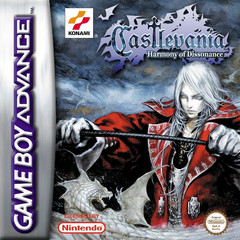 The first game in my new review series is Castlevania: Harmony of Dissonance. The second Game Boy Advance Castlevania game and the third with Metroidvania style of gameplay (the first being Symphony of the Night, which I reviewed on The First Hour a week ago). The game was released in 2002 and then re-released again in the Castlevania Double Pack to reach a larger audience (as the first release of this game and the next had rather small releases). This is how I was able to play it for the first time, and being a huge fan of this style of gameplay, was very excited to play it. Let's see at how it panned out, all scores are out of 10.
The first game in my new review series is Castlevania: Harmony of Dissonance. The second Game Boy Advance Castlevania game and the third with Metroidvania style of gameplay (the first being Symphony of the Night, which I reviewed on The First Hour a week ago). The game was released in 2002 and then re-released again in the Castlevania Double Pack to reach a larger audience (as the first release of this game and the next had rather small releases). This is how I was able to play it for the first time, and being a huge fan of this style of gameplay, was very excited to play it. Let's see at how it panned out, all scores are out of 10.